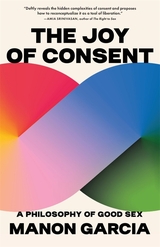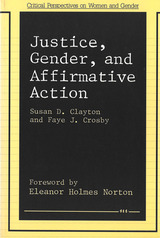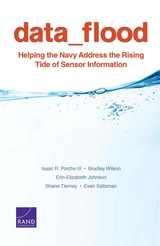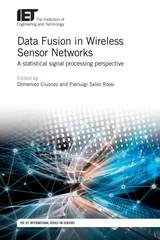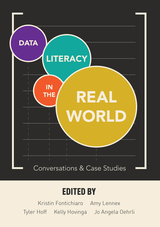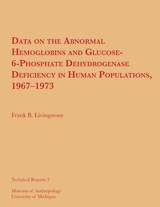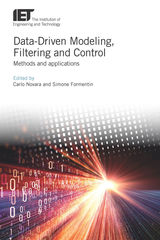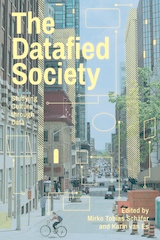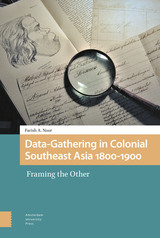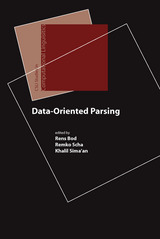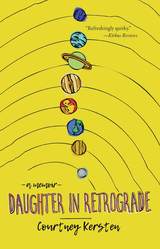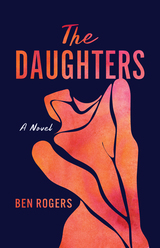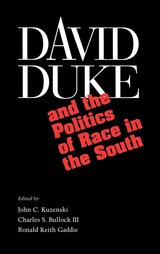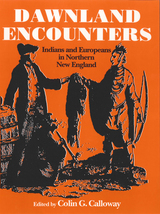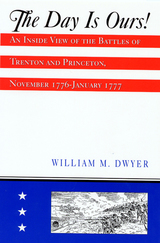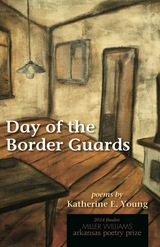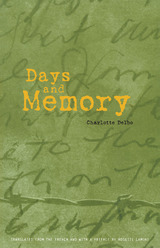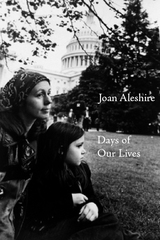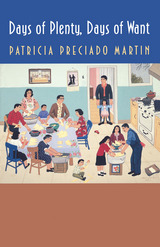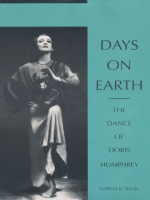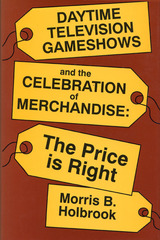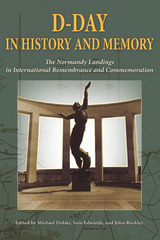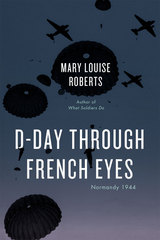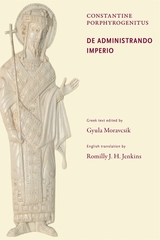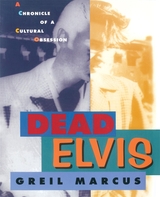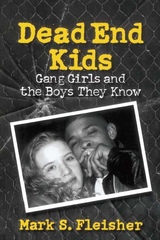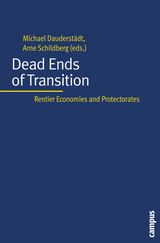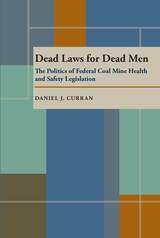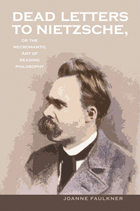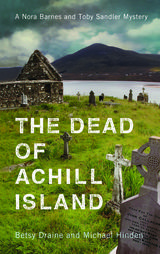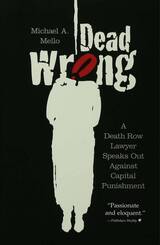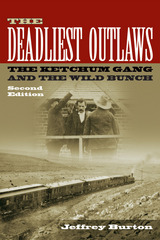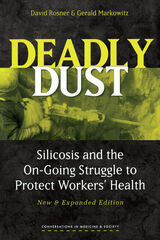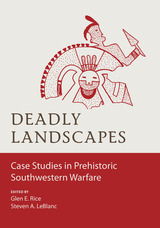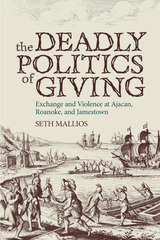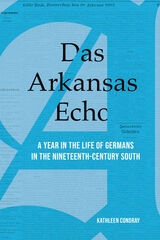 Das Arkansas Echo: A Year in the Life of Germans in the Nineteenth-Century South
Kathleen Condray
University of Arkansas Press, 2020 In the late nineteenth century, a thriving immigrant population supported three German-language weekly newspapers in Arkansas. Most traces of the community those newspapers served disappeared with assimilation in the ensuing decades—but luckily, the complete run of one of the weeklies, Das Arkansas Echo, still exists, offering a lively picture of what life was like for this German immigrant community.
“Das Arkansas Echo”: A Year in the Life of Germans in the Nineteenth-Century South examines topics the newspaper covered during its inaugural year. Kathleen Condray illuminates the newspaper’s crusade against Prohibition, its advocacy for the protection of German schools and the German language, and its promotion of immigration. We also learn about aspects of daily living, including food preparation and preservation, religion, recreation, the role of women in the family and society, health and wellness, and practical housekeeping. And we see how the paper assisted German speakers in navigating civic life outside their immigrant community, including the racial tensions of the post-Reconstruction South.
“Das Arkansas Echo”: A Year in the Life of Germans in the Nineteenth-Century South offers a fresh perspective on the German speakers who settled in a modernizing Arkansas. Mining a valuable newspaper archive, Condray sheds light on how these immigrants navigated their new identity as southern Americans.
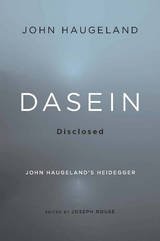 Dasein Disclosed: John Haugeland’s Heidegger
John Haugeland
Harvard University Press, 2013 The author of discipline-defining studies of human cognition and artificial intelligence, John Haugeland was a charismatic, highly original voice in the contemporary forum of Anglo-American analytic philosophy. At his death in 2010, he left behind an unfinished manuscript, more than a decade in the making, intended as a summation of his life-long engagement with one of the twentieth century’s most influential philosophical tracts, Heidegger’s Being and Time (1927). Dasein Disclosed brings together in a single volume the writings of a man widely acknowledged as one of Heidegger’s preeminent and most provocative interpreters.
A labyrinth of notoriously difficult ideas and terminology, Being and Time has inspired copious commentary. Not content merely to explain, Haugeland aspired to a sweeping reevaluation of Heidegger’s magnum opus and its conception of human life as Dasein—a reevaluation focused on Heidegger’s effort to reawaken philosophically dormant questions of what it means “to be.” Interpreting Dasein unconventionally as “the living of a living way of life,” Haugeland put involvement in a shared world, rather than individual persons or their experience, at the heart of Heidegger’s phenomenology of understanding and truth. Individuality, Haugeland insists, emerges in the call to take responsibility for a collective way of being in the world. He traces this thought to Heidegger’s radical conclusion that one does not truly understand philosophical concepts unless that understanding changes how one lives.
As illuminating as it is iconoclastic, Dasein Disclosed is not just Haugeland’s Heidegger—it is a major contribution to philosophy in its own right.
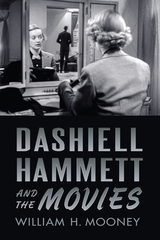 Dashiell Hammett and the Movies
Mooney, William H
Rutgers University Press, 2014 As the father of the hardboiled detective genre, Dashiell Hammett had a huge influence on Hollywood. Yet, it is easy to forget how adaptable Hammett’s work was, fitting into a variety of genres and inspiring generations of filmmakers.
Dashiell Hammett and the Movies offers the first comprehensive look at Hammett’s broad oeuvre and how it was adapted into films from the 1930s all the way into the 1990s. Film scholar William H. Mooney reveals the wide range of films crafted from the same Hammett novels, as when The Maltese Falcon was filmed first as a pre-Code sexploitation movie, then as a Bette Davis screwball comedy, and finally as the Humphrey Bogart classic. He also considers how Hammett rose to Hollywood fame not through the genre most associated with him, but through a much fizzier concoction, the witty murder mystery The Thin Man. To demonstrate the hold Hammett still has over contemporary filmmakers, the book culminates in an examination of the Coen brothers’ pastiche Miller’s Crossing.
Mooney not only provides us with an in-depth analysis of Hammett adaptations, he also chronicles how Hollywood enabled the author’s own rise to stardom, complete with a celebrity romance and a carefully crafted public persona. Giving us a behind-the-scenes look at the complex power relationships, cultural contexts, and production concerns involved in bringing Hammett’s work from the page to the screen, Dashiell Hammett and the Movies offers a fresh take on a literary titan.
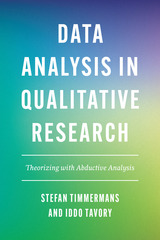 Data Analysis in Qualitative Research: Theorizing with Abductive Analysis
Stefan Timmermans and Iddo Tavory
University of Chicago Press, 2022 From two experts in the field comes an accessible, how-to guide that will help researchers think more productively about the relation between theory and data at every stage of their work.
In Data Analysis in Qualitative Research, Iddo Tavory and Stefan Timmermans provide a how-to guide filled with tricks of the trade for researchers who hope to take excellent qualitative data and transform it into powerful scholarship. In their previous book, Abductive Analysis: Theorizing Qualitative Research, Timmermans and Tavory offered a toolkit for innovative theorizing in the social sciences. In this companion, they go one step further to show how to uncover the surprising revelations that lie waiting in qualitative data—in sociology and beyond.
In this book, they lay out a series of tools designed to help both novice and expert scholars see and understand their data in surprising ways. Timmermans and Tavory show researchers how to “stack the deck” of qualitative research in favor of locating surprising findings that may lead to theoretical breakthroughs, whether by engaging with theory, discussing research strategies, or walking the reader through the process of coding data. From beginning to end of a research project, Data Analysis in Qualitative Research helps social scientists pinpoint the most promising paths to take in their approach.
Data as Infrastructure for Smart Cities
Larissa Suzuki
The Institution of Engineering and Technology, 2019 This book describes how smart cities can be designed with data at their heart, moving from a broad vision to a consistent city-wide collaborative configuration of activities. The authors present a comprehensive framework of techniques to help decision makers in cities analyse their business strategies, design data infrastructures to support these activities, understand stakeholders' expectations, and translate this analysis into a competitive strategy for creating a smart city data infrastructure. Readers can take advantage of unprecedented insights into how cities and infrastructures function and be ready to overcome complex challenges. The framework presented in this book has guided the design of several urban platforms in the European Union and the design of the City Data Strategy of the Mayor of London, UK.
Data Communications and Networks
R.L. Brewster
The Institution of Engineering and Technology, 1994 There has been unprecedented development in data communications and services since the first edition of this book was published in 1986. In less than a decade the technology has advanced beyond all recognition and the first edition is now really no more than an interesting historical record. The second edition, published in 1989, reflected some of these developments and introduced the then emerging proposals for an integrated services digital network (ISDN). Since that date ISDN has become a fact and has already begun to be superseded by proposals and standards for a broadband ISDN (B-ISDN), offering greatly enhanced and flexible data rates over a public network based mainly on optical fibre transmission. Optical fibre technology is also being used in wide-area private digital networks and for high-capacity internetworking operations.
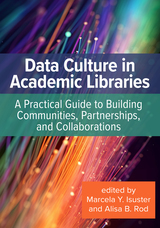 Data Culture in Academic Libraries: A Practical Guide to Building Communities, Partnerships, and Collaborations
Marcela Y. Isuster
Association of College & Research Libraries, 2025 Librarians and academic data specialists support the research data needs of faculty and students through conventional services such as consultations and workshops, but also increasingly by cultivating a data culture that supports the diverse data needs of their communities. The shift toward data-related research as a driver of social capital is a critical opportunity to reassess data literacy training and build a local scholarly culture around data. In five parts, Data Culture in Academic Libraries: A Practical Guide to Building Communities, Partnerships, and Collaborations can help you foster an institutional culture that favors the curation, creation, and wider use of datasets. - Data at all Levels
- Data Services and Instruction
- Data Outreach
- Data Communities
- Data Partnerships
Chapters include case studies, practical examples, and strategies from practitioners in North America, Asia, and Europe working in a wide range of academic contexts and fostering data partnerships and communities that often go beyond their libraries and institutions. Data Culture in Academic Libraries highlights the ways that library workers are developing novel and innovative models of relationship-building to improve data-related services while incorporating a lens of equity, diversity, anti-racism, and inclusion in programming events and partnerships.
Data Dating: Love, Technology, Desire
Edited by Ania Malinowska and Valentina Peri
Intellect Books, 2021 A collection of essays exploring the intersection of dating and digital reality.
Data Dating is a collection of eleven academic essays accompanied by eleven works of media art that provide a comprehensive insight into the construction of love and its practices in the time of digitally mediated relationships. The essays come from recognized researchers in the field of media and cultural studies.
 Data Equals: Democratic Equality and Technological Hierarchy
Colin Koopman
University of Chicago Press, 2025 An expansive vision for data equality that goes beyond algorithmic fairness.
When we gave algorithms power over our world, we hoped that the apparent neutrality of machine thinking would create a more egalitarian age. Yet we are more divided than ever, staring down threats to democracy itself. In Data Equals, Colin Koopman argues that data technologies fail us so often because we built them around a deficient notion of equality.
It is not enough, Koopman explains, that algorithms engage everyone’s data with the same measuring stick. The data themselves are all too often structured in ways that obscure and exacerbate stratifying distinctions. Koopman contends that we must also work to ensure that those people subject to computational assessment enter data systems on equal terms. Part philosophical argument, part practical guide (replete with case studies from education technology), Data Equals offers novel methods for realizing democratic equality in a digital age.
Data Flood: Helping the Navy Address the Rising Tide of Sensor Information
Isaac R. III Porche
RAND Corporation, 2014 Navy analysts are struggling to keep pace with the growing flood of data collected by intelligence, surveillance, and reconnaissance sensors. This challenge is sure to intensify as the Navy continues to field new and additional sensors. The authors explore options for solving the Navy’s “big data” challenge, considering changes across four dimensions: people, tools and technology, data and data architectures, and demand and demand management.
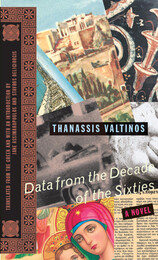 Data from the Decade of the Sixties: A Novel
Thanassis Valtinos
Northwestern University Press, 2000 Winner of Greece’s National Book Award for Best Novel in 1990 and short-listed for the Aristeion European Literature Prize in 1991, Data from the Decade of the Sixties is a masterpiece by Greek author Thanassis Valtinos.
Just as Greece today struggles to adapt to a shifting political landscape, so Greece in the 1960s was convulsed by the collision of tradition and cultural transformation. In Data from the Decade of the Sixties, Valtinos assembles voices, stories, and news clips that capture the transformation of Greece, the monarchy giving way to a republic via dictatorship, the industrialization of its agricultural society, and the replacement of arranged marriages with love matches.
The many voices in this tour de force coalesce in a bricolage of documents: personal letters between friends and family, news reports, advertisements, and other written ephemera. As governments fall, sexologists, fortune-tellers, garage owners, and lonely matrons advertise their specialties and fantasies in want ads, while the young and lonely find escape within the cheap novels, movies, and gossip columns that enliven their barren existence.
Together these testimonies illuminate the tumult of 1960s Greece, where generations and values clash and Greek society struggles to adapt. Valtinos captures the pulse of a decade, portraying the spirit of the century in Greece and throughout the world.
Data Fusion in Wireless Sensor Networks: A statistical signal processing perspective
Domenico Ciuonzo
The Institution of Engineering and Technology, 2019 The role of data fusion has been expanding in recent years through the incorporation of pervasive applications, where the physical infrastructure is coupled with information and communication technologies, such as wireless sensor networks for the internet of things (IoT), e-health and Industry 4.0. In this edited reference, the authors provide advanced tools for the design, analysis and implementation of inference algorithms in wireless sensor networks.
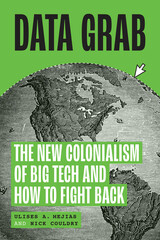 Data Grab: The New Colonialism of Big Tech and How to Fight Back
Ulises A. Mejias and Nick Couldry
University of Chicago Press, 2024 A compelling argument that the extractive practices of today’s tech giants are the continuation of colonialism—and a crucial guide to collective resistance.
Large technology companies like Meta, Amazon, and Alphabet have unprecedented access to our daily lives, collecting information when we check our email, count our steps, shop online, and commute to and from work. Current events are concerning—both the changing owners (and names) of billion-dollar tech companies and regulatory concerns about artificial intelligence underscore the sweeping nature of Big Tech’s surveillance and the influence such companies hold over the people who use their apps and platforms.
As trusted tech experts Ulises A. Mejias and Nick Couldry show in this eye-opening and convincing book, this vast accumulation of data is not the accidental stockpile of a fast-growing industry. Just as nations stole territories for ill-gotten minerals and crops, wealth, and dominance, tech companies steal personal data important to our lives. It’s only within the framework of colonialism, Mejias and Couldry argue, that we can comprehend the full scope of this heist.
Like the land grabs of the past, today’s data grab converts our data into raw material for the generation of corporate profit against our own interests. Like historical colonialism, today’s tech corporations have engineered an extractive form of doing business that builds a new social and economic order, leads to job precarity, and degrades the environment. These methods deepen global inequality, consolidating corporate wealth in the Global North and engineering discriminatory algorithms. Promising convenience, connection, and scientific progress, tech companies enrich themselves by encouraging us to relinquish details about our personal interactions, our taste in movies or music, and even our health and medical records. Do we have any other choice?
Data Grab affirms that we do. To defy this new form of colonialism we will need to learn from previous forms of resistance and work together to imagine entirely new ones. Mejias and Couldry share the stories of voters, workers, activists, and marginalized communities who have successfully opposed unscrupulous tech practices. An incisive discussion of the digital media that’s transformed our world, Data Grab is a must-read for anyone concerned about privacy, self-determination, and justice in the internet age.
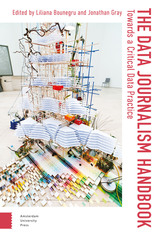 The Data Journalism Handbook: Towards A Critical Data Practice
Liliana Bounegru
Amsterdam University Press, 2021 The Data Journalism Handbook: Towards a Critical Data Practice provides a rich and panoramic introduction to data journalism, combining both critical reflection and practical insight. It offers a diverse collection of perspectives on how data journalism is done around the world and the broader consequences of datafication in the news, serving as both a textbook and a sourcebook for this emerging field. With more than 50 chapters from leading researchers and practitioners of data journalism, it explores the work needed to render technologies and data productive for journalistic purposes. It also gives a "behind the scenes" look at the social lives of data sets, data infrastructures, and data stories in newsrooms, media organizations, start-ups, civil society organizations and beyond. The book includes sections on "doing issues with data," "assembling data," "working with data," "experiencing data," "investigating data, platforms and algorithms," "organizing data journalism," "learning data journalism together" and "situating data journalism."
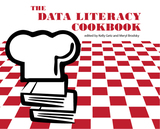 The Data Literacy Cookbook
Kelly Getz
Association of College & Research Libraries, 2022 Today’s students create and are confronted with many kinds of data in multiple formats. Data literacy enables students and researchers to access, interpret, critically assess, manage, handle, and ethically use data. The Data Literacy Cookbook includes a variety of approaches to and lesson plans for teaching data literacy, from simple activities to self-paced learning modules to for-credit and discipline-specific courses. Sixty-five recipes are organized into nine sections based on learning outcomes: - Interpreting Polls and Surveys
- Finding and Evaluating Data
- Data Manipulation and Transformation
- Data Visualization
- Data Management and Sharing
- Geospatial Data
- Data in the Disciplines
- Data Literacy Outreach and Engagement
- Data Literacy Programs and Curricula
Many sections have overlapping learning outcomes, so you can combine recipes from multiple sections to whip up a scaffolded curriculum. The Data Literacy Cookbook provides librarians with lesson plans, strategies, and activities to help guide students as both consumers and producers in the data life cycle.
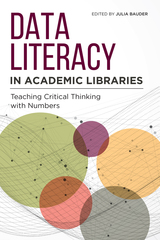 Data Literacy in Academic Libraries: Teaching Critical Thinking with Numbers
Julia Bauder
American Library Association, 2021 We live in a data-driven world, much of it processed and served up by increasingly complex algorithms, and evaluating its quality requires its own skillset. As a component of information literacy, it's crucial that students learn how to think critically about statistics, data, and related visualizations. Here, Bauder and her fellow contributors show how librarians are helping students to access, interpret, critically assess, manage, handle, and ethically use data. Offering readers a roadmap for effectively teaching data literacy at the undergraduate level, this volume explores such topics as - the potential for large-scale library/faculty partnerships to incorporate data literacy instruction across the undergraduate curriculum;
- how the principles of the ACRL Framework for Information Literacy for Higher Education can help to situate data literacy within a broader information literacy context;
- a report on the expectations of classroom faculty concerning their students’ data literacy skills;
- various ways that librarians can partner with faculty;
- case studies of two initiatives spearheaded by Purdue University Libraries and University of Houston Libraries that support faculty as they integrate more work with data into their courses;
- Barnard College’s Empirical Reasoning Center, which provides workshops and walk-in consultations to more than a thousand students annually;
- how a one-shot session using the PolicyMap data mapping tool can be used to teach students from many different disciplines;
- diving into quantitative data to determine the truth or falsity of potential “fake news” claims; and
- a for-credit, librarian-taught course on information dissemination and the ethical use of information.
Data Literacy in the Real World: Conversations & Case Studies
Edited by Kristin Fontichiaro, Amy Lennex, Tyler Hoff, Kelly Hovinga, Jo Angela Oehrli
Michigan Publishing, 2017 Knowing how to recognize the role data plays in our lives is critical to navigating today’s complex world. In this volume, you’ll find two kinds of professional development tools to support that growth. Part I contains pre-made professional development via links to webinars from the 2016 and 2017 4T Virtual Conference on Data Literacy, along with discussion questions and activities that can animate conversations around data in your school. Part II explores data “in the wild” with case studies pulled from the headlines, along with provocative discussion questions, professionals and students alike can explore multiple perspectives at play with Big Data, data privacy, personal data management, ethical data use, and citizen science.
Data Mind: Poems
Joanna Fuhrman
Northwestern University Press, 2025 Wrestling with the experience of living online as a non-digital native Joanna Fuhrman didn’t grow up online. Her generation entered the digital age as adults, with optimism about the possibilities it would bring for community building. In the alien landscape of the internet, they indeed found moments of joy and connection, but they also watched in anguish as what had been sold as a utopian space instead magnified the anti-democratic demons of necrocapitalism. In this darkly comic and surreal collection, Fuhrman lets herself fall into the internet wormhole of these conflicting realities. With titles ranging from “You Won’t Believe How Your Favorite Childhood Star Looks Now” to “We’ll Burn That Algorithm When We Get to It,” the feminist prose poems in Data Mind remix the tropes of digital life with the puckishness and embodied urgency for which Fuhrman is celebrated.
Data: Now Bigger and Better!
Edited by Tom Boellstorff and Bill Maurer
Prickly Paradigm Press, 2015 Data is too big to be left to the data analysts. Data: Now Bigger and Better! brings together researchers whose work is deeply informed by the conceptual frameworks of anthropology—frameworks that are comparative as well as field-based. From kinship to gifts, everything old becomes rich with new insight when the anthropological archive washes over “big data.” Bringing together anthropology’s classic debates and contemporary interventions, the book counters the future-oriented speculation so characteristic of discussions regarding big data. Drawing on the long-standing experience in industry contexts, the contributors also provide analytical provocations that can help reframe some of the most important shifts in technology and society in the first half of the twenty-first century.
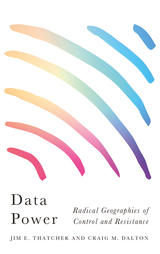 Data Power: Radical Geographies of Control and Resistance
Jim E. Thatcher
Pluto Press, 2021 In recent years, popular media has inundated audiences with sensationalized headlines recounting data breaches, new forms of surveillance and other dangers of our digital age. Despite their regularity, such accounts treat each case as unprecedented and unique. This book proposes a radical rethinking of the history, present and future of our relations with the digital, spatial technologies that increasingly mediate our everyday lives.
From smartphones to surveillance cameras, to navigational satellites, these new technologies offer visions of integrated, smooth and efficient societies, even as they directly conflict with the ways users experience them. Recognizing the potential for both control and liberation, the authors argue against both acquiescence to and rejection of these technologies.
Through intentional use of the very systems that monitor them, activists from Charlottesville to Hong Kong are subverting, resisting and repurposing geographic technologies. Using examples as varied as writings on the first telephones to the experiences of a feminist collective for migrant women in Spain, the authors present a revolution of everyday technologies. In the face of the seemingly inevitable circumstances, these technologies allow us to create new spaces of affinity, and a new politics of change.
Data Security in Cloud Computing
Vimal Kumar
The Institution of Engineering and Technology, 2017 Cloud Computing has already been embraced by many organizations and individuals due to its benefits of economy, reliability, scalability and guaranteed quality of service among others. But since the data is not stored, analysed or computed on site, this can open security, privacy, trust and compliance issues. This one-stop reference covers a wide range of issues on data security in Cloud Computing ranging from accountability, to data provenance, identity and risk management.
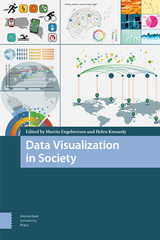 Data Visualization in Society
Martin Engebretsen
Amsterdam University Press, 2020 Today we are witnessing an increased use of data visualization in society. Across domains such as work, education and the news, various forms of graphs, charts and maps are used to explain, convince and tell stories. In an era in which more and more data are produced and circulated digitally, and digital tools make visualization production increasingly accessible, it is important to study the conditions under which such visual texts are generated, disseminated and thought to be of societal benefit. This book is a contribution to the multi-disciplined and multi-faceted conversation concerning the forms, uses and roles of data visualization in society. Do data visualizations do 'good' or 'bad'? Do they promote understanding and engagement, or do they do ideological work, privileging certain views of the world over others? The contributions in the book engage with these core questions from a range of disciplinary perspectives.
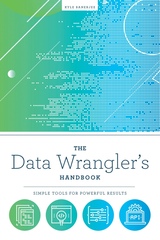 The Data Wrangler's Handbook: Simple Tools for Powerful Results
Kyle Banerjee
American Library Association, 2019 Data manipulation and analysis are far easier than you might imagine—in fact, using tools that come standard with your desktop computer, you can learn how to extract, manipulate, and analyze data (and metadata) of any size and complexity. In this handbook, data wizard Banerjee will familiarize you with easily digestible but powerful concepts that will enable you to feel confident working with data. With his expert guidance, you’ll learn how to - use a single-word command to sort files of any size by any criteria, identify duplicates, and perform numerous other common library tasks;
- understand data formats, delimited text and CSV files, XML, JSON, scripting, and other key components of data;
- undertake more sophisticated tasks such as comparing files, converting data from one format to another, reformatting values, combining data from multiple files, and communicating with APIs (Application Programming Interfaces);
- save time and stress through simple techniques for transforming text, recognizing symbols that perform important tasks, a Regular Expression cheat sheet, a glossary, and other tools.
Library technologists and those involved in maintaining and analyzing data and metadata will find Banerjee’s resource essential.
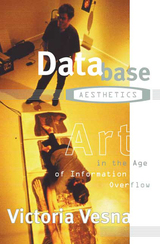 Database Aesthetics: Art in the Age of Information Overflow
Victoria Vesna
University of Minnesota Press, 2007 Database Aesthetics examines the database as cultural and aesthetic form, explaining how artists have participated in network culture by creating data art. The essays in this collection look at how an aesthetic emerges when artists use the vast amounts of available information as their medium. Here, the ways information is ordered and organized become artistic choices, and artists have an essential role in influencing and critiquing the digitization of daily life. Contributors: Sharon Daniel, U of California, Santa Cruz; Steve Deitz, Carleton College; Lynn Hershman Leeson, U of California, Davis; George Legrady, U of California, Santa Barbara; Eduardo Kac, School of the Art Institute of Chicago; Norman Klein, California Institute of the Arts; John Klima; Lev Manovich, U of California, San Diego; Robert F. Nideffer, U of California, Irvine; Nancy Paterson, Ontario College of Art and Design; Christiane Paul, School of Visual Arts in New York; Marko Peljhan, U of California, Santa Barbara; Warren Sack, U of California, Santa Cruz; Bill Seaman, Rhode Island School of Design; Grahame Weinbren, School of Visual Arts, New York. Victoria Vesna is a media artist, and professor and chair of the Department of Design and Media Arts at the University of California, Los Angeles.
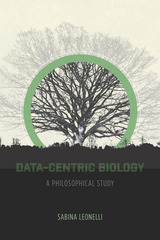 Data-Centric Biology: A Philosophical Study
Sabina Leonelli
University of Chicago Press, 2016 In recent decades, there has been a major shift in the way researchers process and understand scientific data. Digital access to data has revolutionized ways of doing science in the biological and biomedical fields, leading to a data-intensive approach to research that uses innovative methods to produce, store, distribute, and interpret huge amounts of data. In Data-Centric Biology, Sabina Leonelli probes the implications of these advancements and confronts the questions they pose. Are we witnessing the rise of an entirely new scientific epistemology? If so, how does that alter the way we study and understand life—including ourselves?
Leonelli is the first scholar to use a study of contemporary data-intensive science to provide a philosophical analysis of the epistemology of data. In analyzing the rise, internal dynamics, and potential impact of data-centric biology, she draws on scholarship across diverse fields of science and the humanities—as well as her own original empirical material—to pinpoint the conditions under which digitally available data can further our understanding of life. Bridging the divide between historians, sociologists, and philosophers of science, Data-Centric Biology offers a nuanced account of an issue that is of fundamental importance to our understanding of contemporary scientific practices.
Data-Driven Modeling, Filtering and Control: Methods and applications
Carlo Novara
The Institution of Engineering and Technology, 2019 The scientific research in many engineering fields has been shifting from traditional first-principle-based to data-driven or evidence-based theories. The latter methods may enable better system design, based on more accurate and verifiable information.
The Datafied Society: Studying Culture through Data
Edited by Mirko Tobias Schäfer and Karin van Es
Amsterdam University Press, 2017 As machine-readable data comes to play an increasingly important role in everyday life, researchers find themselves with rich resources for studying society. The novel methods and tools needed to work with such data require not only new knowledge and skills, but also a new way of thinking about best research practices. This book critically reflects on the role and usefulness of big data, challenging overly optimistic expectations about what such information can reveal, introducing practices and methods for its analysis and visualisation, and raising important political and ethical questions regarding its collection, handling, and presentation.
Data-Gathering in Colonial Southeast Asia 1800-1900: Framing the Other
Farish A. Noor
Amsterdam University Press, 2020 Empire-building did not only involve the use of excessive violence against native communities, but also required the gathering of data about the native Other. This is a book about books, which looks at the writings of Western colonial administrators, company-men and map-makers who wrote about Southeast Asia in the 19th century. In the course of their information-gathering they had also framed the people of Southeast Asia in a manner that gave rise to Orientalist racial stereotypes that would be used again and again. Data-Gathering in Colonial Southeast Asia 1800-1900: Framing the Other revisits the era of colonial data-collecting to demonstrate the workings of the imperial echo chamber, and how in the discourse of 19th century colonial-capitalism data was effectively weaponized to serve the interests of Empire.
Data-Oriented Parsing
Edited by Rens Bod, Remko Scha, and Khalil Sima'an
CSLI, 2003 Data-Oriented Parsing (DOP) is one of the leading paradigms in Statistical Natural Language Processing. In this volume, a collection of computational linguists offer a state-of-the-art overview of DOP, suitable for students and researchers in natural language processing and speech recognition as well as for computational linguistics.
This handbook begins with the theoretical background of DOP and introduces the algorithms used in DOP as well as in other probabilistic grammar models. After surveying extensions to the basic DOP model, the volume concludes with close study of the applications that use DOP as a backbone: speech understanding, machine translation, and language learning.
 A Date Which Will Live: Pearl Harbor in American Memory
Emily S. Rosenberg
Duke University Press, 2005 December 7, 1941—the date of Japan’s surprise attack on the U.S. fleet at Pearl Harbor—is "a date which will live" in American history and memory, but the stories that will live and the meanings attributed to them are hardly settled. In movies, books, and magazines, at memorial sites and public ceremonies, and on television and the internet, Pearl Harbor lives in a thousand guises and symbolizes dozens of different historical lessons. In A Date Which Will Live, historian Emily S. Rosenberg examines the contested meanings of Pearl Harbor in American culture.
Rosenberg considers the emergence of Pearl Harbor’s symbolic role within multiple contexts: as a day of infamy that highlighted the need for future U.S. military preparedness, as an attack that opened a "back door" to U.S. involvement in World War II, as an event of national commemoration, and as a central metaphor in American-Japanese relations. She explores the cultural background that contributed to Pearl Harbor’s resurgence in American memory after the fiftieth anniversary of the attack in 1991. In doing so, she discusses the recent “memory boom” in American culture; the movement to exonerate the military commanders at Pearl Harbor, Admiral Husband Kimmel and General Walter Short; the political mobilization of various groups during the culture and history "wars" of the 1990s, and the spectacle surrounding the movie Pearl Harbor. Rosenberg concludes with a look at the uses of Pearl Harbor as a historical frame for understanding the events of September 11, 2001.
Dated Greek Manuscripts of the Thirteen and Fourteenth Centuries in the Libraries of Great Britain
Alexander Turyn
Harvard University Press, 1980 Professor Turyn has published books on Greek manuscripts in the Vatican Library, and here he examines book scripts and subscriptions from the dated Greek manuscripts in the libraries of Great Britain.
These to-scale facsimile reproductions, one hundred ninety-eight in total, provide ample paleographical material that will help in dating other manuscripts. The author presents the chronological evidence and extensively interprets the prosopographical and linguistic elements of the manuscripts. At the same time he elucidates the origins of a manuscript, its character as a document of Byzantine culture, and its role in the transmission of ancient and medieval Greek literature.
Daughter in Retrograde: A Memoir
Courtney Kersten
University of Wisconsin Press, 2021 When she isn't eavesdropping on family gossip or gazing at taxidermy squirrels in smoky dives, Courtney Kersten charts the uncertainty of her midwestern homeland by looking to the stars and planets. As a teen she had plunged deep into the worlds of signs, symbols, and prophecy. But as her mother—her traveling companion into these spheres—lies dying, Kersten must learn to navigate without the person who always lit the way. Their last journey together, to swim in a Wisconsin lake, is a bittersweet, darkly comic, poignant climax to this transformative memoir.
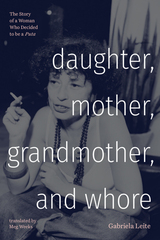 Daughter, Mother, Grandmother, and Whore: The Story of a Woman Who Decided to be a Puta
Gabriela Leite
Duke University Press, 2024 In the early 1970s, while living at home with her conservative middle-class family and studying at the University of São Paulo, Gabriela Leite decided to become a sex worker. From her first client in a tiny room in downtown São Paulo to the launch of an exuberant clothing line designed for sex workers in Rio de Janeiro thirty years later, Daughter, Mother, Grandmother, and Whore tells the fascinating story of Leite’s bold and unique life in her own words. After helping to organize Brazil’s first protests by sex workers against police brutality, she moved to Rio de Janeiro, where she quickly became ensconced in the city’s storied red-light district. From there, Leite built a national network of politicized sex workers, worked for HIV/AIDS prevention, and participated in Brazil’s robust new civil society after its return to democracy in 1985 following a twenty-one-year military dictatorship. Insistent on advocating for the sex worker’s comprehensive human rights, Leite pioneered an irreverent grassroots Latin American feminism, which critiqued moral hypocrisies and Christian conservatism while affirming pleasure, joy, and agency. Daughter, Mother, Grandmother, and Whore also includes a foreword by artist and activist Carol Leigh.
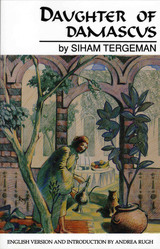 Daughter of Damascus: A Memoir
By Siham Tergeman
University of Texas Press, 1993 Daughter of Damascus presents a personal account of a Syrian woman's youth in the Suq Saruja ("old city") quarter of Damascus in the 1940s. Siham Tergeman wrote this book to preserve the details of a "genuine Arab past" for Syrian young people. In it, she relates the customs pertaining to marriage, birth, circumcision, and death. She writes of Ramadan festivities, family picnics to the orchards of the Ghuta, weekly trips to the public bath, her school experiences, Damascene cooking, peddlers' calls, and proverbs. She includes the well-known dramatic skits, songs, and tales of the Syrian Hakawati storytellers. And, through the words of her father, she describes the difficult period when Syrians were involved in the Balkans War and World War I. All this wealth of ethnographic detail is set in real-life vignettes that make the book lively and entertaining reading. Little has been published about modern Syrian social life. In this English translation of an Arabic memoir originally published in Syria in 1978, Tergeman appeals to a wide audience. General readers will find a charming story, while scholars can find source material for university courses in anthropology, sociology, family and women's studies, and Middle Eastern area studies. The introduction by anthropologist Andrea Rugh portrays Syrian social life for Western readers and points out some of the nuances that might escape the attention of those unacquainted with Arab culture.
 The Daughter of Man
L. J. Sysko
University of Arkansas Press, 2023 "This whip-smart collection is a playful celebration of feminine power.”
—Publisher’s Weekly
"What a beautiful book.”
—Ross Gay
"With the verve of Alice Fulton and the panache of Gerald Stern, Sysko keens into the canon, a welcome voice. Sing, indeed, heavenly muse.”
—Alan Michael Parker
Finalist for the 2023 Miller Williams Poetry Prize
Selected by Patricia Smith The Daughter of Man follows its unorthodox heroine as she transforms from maiden to warrior—then to queen, maven, and crone—against the backdrop of suburban America from the 1980s to today. In this bold reframing of the hero’s journey, L. J. Sysko serves up biting social commentary and humorous, unsparing self-critique while enlisting an eccentric cast that includes Betsy Ross as sex worker, Dolly Parton as raptor, and a bemused MILF who exchanges glances with a young man at a gas station. Sysko’s revisions of René Magritte’s modernist icon The Son of Man and the paintings of baroque artist Artemisia Gentileschi, whose extraordinary talent was nearly eclipsed after she took her rapist to trial, loom large in this multifaceted portrait of womanhood. With uncommon force, The Daughter of Man confronts misogyny and violence, even as it bursts with nostalgia, lust, and poignant humor.
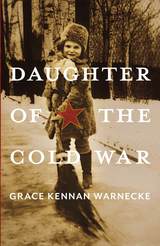 Daughter of the Cold War
Grace Kennan Warnecke
University of Pittsburgh Press, 2018
Grace Kennan Warnecke's memoir is about a life lived on the edge of history. Daughter of one of the most influential diplomats of the twentieth century, wife of the scion of a newspaper dynasty and mother of the youngest owner of a major league baseball team, Grace eventually found her way out from under the shadows of others to forge a dynamic career of her own.
Born in Latvia, Grace lived in seven countries and spoke five languages before the age of eleven. As a child, she witnessed Hitler’s march into Prague, attended a Soviet school during World War II, and sailed the seas with her father. In a multi-faceted career, she worked as a professional photographer, television producer, and book editor and critic. Eventually, like her father, she became a Russian specialist, but of a very different kind. She accompanied Ted Kennedy and his family to Russia, escorted Joan Baez to Moscow to meet with dissident Andrei Sakharov, and hosted Josef Stalin’s daughter on the family farm after Svetlana defected to the United States. While running her own consulting company in Russia, she witnessed the breakup of the Soviet Union, and later became director of a women’s economic empowerment project in a newly independent Ukraine.
Daughter of the Cold War is a tale of all these adventures and so much more. This compelling and evocative memoir allows readers to follow Grace's amazing path through life – a whirlwind journey of survival, risk, and self-discovery through a kaleidoscope of many countries, historic events, and fascinating people.
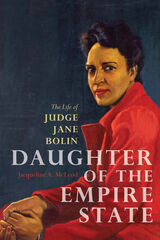 Daughter of the Empire State: The Life of Judge Jane Bolin
Jacqueline A. McLeod
University of Illinois Press, 2016 This long overdue biography of the nation's first African American woman judge elevates Jane Matilda Bolin to her rightful place in American history as an activist, integrationist, jurist, and outspoken public figure in the political and professional milieu of New York City before the onset of the modern Civil Rights movement. Bolin was appointed to New York City's domestic relations court in 1939 for the first of four ten-year terms. When she retired in 1978, her career had extended well beyond the courtroom. Drawing on archival materials as well as a meeting with Bolin in 2002, historian Jacqueline A. McLeod reveals how Bolin parlayed her judicial position to impact significant reforms of the legal and social service system in New York. Beginning with Bolin's childhood and educational experiences at Wellesley and Yale, Daughter of the Empire State chronicles Bolin's relatively quick rise through the ranks of a profession that routinely excluded both women and African Americans. Deftly situating Bolin's experiences within the history of black women lawyers and the historical context of high-achieving black New Englanders, McLeod offers a multi-layered analysis of black women's professionalization in a segregated America. Linking Bolin's activist leanings and integrationist zeal to her involvement in the NAACP, McLeod analyzes Bolin's involvement at the local level as well as her tenure on the organization's national board of directors. An outspoken critic of the discriminatory practices of New York City's probation department and juvenile placement facilities, Bolin also co-founded, with Eleanor Roosevelt, the Wiltwyck School for boys in upstate New York and campaigned to transform the Domestic Relations Court with her judicial colleagues. McLeod's careful and highly readable account of these accomplishments inscribes Bolin onto the roster of important social reformers and early civil rights trailblazers.
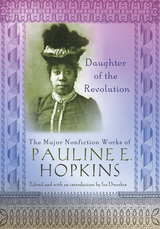 Daughter of the Revolution: The Major Nonfiction Works of Pauline Hopkins
Dworkin, Ira
Rutgers University Press, 2007 Pauline E. Hopkins (1859–1930) came to prominence in the early years of the twentieth century as an outspoken writer, editor, and critic. Frequently recognized for her first novel, Contending Forces, she is currently one of the most widely read and studied African American novelists from that period. While nearly all of Hopkins’s fiction remains in print, there is very little of her nonfiction available. This reader brings together dozens of her hard-to-find essays, including longer nonfiction works such as Famous Men of the Negro Race and The Dark Races of the Twentieth Century, some of which are published here for the first time in their entirety. Through these works, along with two juvenile essays from the 1870s, a personal letter, and two speeches, readers encounter a voice that is committed to constructing an international discourse on race, recovering the militant abolitionist tradition to combat Jim Crow, celebrating black political participation during and after the Reconstruction era, articulating the connections between race and labor, and insisting on equal rights for women. Hopkins’s writing will challenge contemporary scholars to rethink their understanding of black activism and modernity in the early twentieth century.
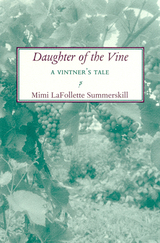 Daughter of the Vine: A Vintner's Tale
Summerskill, Mimi LaFollette
Rutgers University Press, 1996 The inspiring and beautifully written memoir of a fascinating woman who, with her family, worked to make their dream of a vineyard into a reality. Buy land, girl, buy land. You will never go hungry if you have land, advised Mimi LaFollette Summerskill's grandfather. So she and her husband John purchased a 30Ðacre farm just north of Princeton, New Jersey. After an initial try at cattle farming, the novice farmers decided to try their hands at wine making. Literally. In the spring of 1979, the family planted 2,000 Seyval Blanc seedlings. After months of research, soil testing, charting weather patterns, pruning, fertilizing, picking, pressing, filtering, bottling, and labeling, the LaFollette Vineyard and Winery was born. Learning the ins and outs of actual wine making turned out to be one of the smaller difficulties the family faced. Until the passage of the Farm Winery Act of 1981, only seven New Jersey farms were licensed to operate a winery. Once that hurdle was passed and the vineyard duly licensed by the state, the federal government stepped in. The Summerskills had to pass inspection by the Bureau of Alcohol and Firearms for a federal license. Then the family had to save their farm from the New Jersey Department of Transportation, who planned to run a major highway right through the vineyard. Learning each and every step along the way, the Summerskills produced success. Today, people around the state enjoy the fruits of the Summerskill's labor.
Daughter Zion: Her Portrait, Her Response
Mark J. Boda
SBL Press, 2012 This volume showcases recent exploration of the portrait of Daughter Zion as “she” appears in biblical Hebrew poetry. Using Carleen Mandolfo’s Daughter Zion Talks Back to the Prophets (Society of Biblical Literature, 2007) as a point of departure, the contributors to this volume explore the image of Daughter Zion in its many dimensions in various texts in the Hebrew Bible. Approaches used range from poetic, rhetorical, and linguistic to sociological and ideological. To bring the conversation full circle, Carleen Mandolfo engages in a dialogic response with her interlocutors. The contributors are Mark J. Boda, Mary L. Conway, Stephen L. Cook, Carol J. Dempsey, LeAnn Snow Flesher, Michael H. Floyd, Barbara Green, John F. Hobbins, Mignon R. Jacobs, Brittany Kim, Cheryl A. Kirk-Duggan, Christl M. Maier, Carleen Mandolfo, Jill Middlemas, Kim Lan Nguyen, and Lena-Sofia Tiemeyer.
The Daughters: A Novel
Ben Rogers
University of Nevada Press, 2025 Renowned—albeit washed-up—author Peter Zemeckis (“Z”) is relishing the sunset of a life spent single when Dr. Nancy Chu crash-lands in the bungalow next door. As Nancy’s family drags him into deeper water, Z must rethink the ending to his own story.
Spanning from Amarillo, Texas, in 1977 to La Jolla, California, in 2012, The Daughters is a kaleidoscopic meditation on family, memory, and the invisible forces that bind us. Z’s narrative interweaves small-town rodeos with amateur radios, teen angst with parental love. Shard by shard, he pieces together the story of a fractured family struggling to reassemble itself.
Like particles, Z’s characters (and neighbors) are both small and singular, but their stories ripple like waves—colliding, refracting, and reshaping one another across generations. Elegant, intricate, and deeply moving, The Daughters reverberates long after its final page is turned.
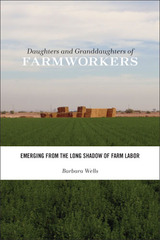 Daughters and Granddaughters of Farmworkers: Emerging from the Long Shadow of Farm Labor
Wells, Barbara
Rutgers University Press In Daughters and Granddaughters of Farmworkers, Barbara Wells examines the work and family lives of Mexican American women in a community near the U.S.-Mexican border in California’s Imperial County. Decades earlier, their Mexican parents and grandparents had made the momentous decision to migrate to the United States as farmworkers. This book explores how that decision has worked out for these second- and third-generation Mexican Americans. Wells provides stories of the struggles, triumphs, and everyday experiences of these women. She analyzes their narratives on a broad canvas that includes the social structures that create the barriers, constraints, and opportunities that have shaped their lives. The women have constructed far more settled lives than the immigrant generation that followed the crops, but many struggle to provide adequately for their families. These women aspire to achieve the middle-class lives of the American Dream. But upward mobility is an elusive goal. The realities of life in a rural, agricultural border community strictly limit social mobility for these descendants of immigrant farm laborers. Reliance on family networks is a vital strategy for meeting the economic challenges they encounter. Wells illustrates clearly the ways in which the “long shadow” of farm work continues to permeate the lives and prospects of these women and their families.
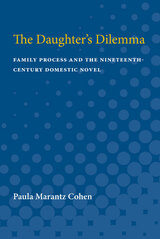 The Daughter's Dilemma: Family Process and the Nineteenth-Century Domestic Novel
Paula Marantz Cohen
University of Michigan Press, 1993 The Daughter's Dilemma breaks new ground in literary studies through its application of family systems theory to the analysis of nineteenth-century domestic novels. Cohen argues for structural correspondences between families and novels: as systems seeking closure, they are governed by certain analogous laws. She argues further that the father-daughter dyad is the pivotal structure by which the nuclear family and the domestic novel were able to define themselves as closed systems. The study treats novels by Samuel Richardson, Jane Austen. Emily Bronte, George Eliot, and Henry James and places them in the context of the writers' individual family experiences. Drawing on recent work in literary and feminist criticism, anthropology, history, and psychoanalysis. as well as family systems theory, Cohen seeks to critique the limitations of these theoretical models even as she employs them lo illuminate the texts under discussion. The study's approach leads to insights about the contemporary family and about the present state of literature and literary criticism. Cohen concludes by suggesting that the modern period marked the demise of an ideology favoring closed systems. The result has been both a nostalgia for those systems and a redefinition of experience and relationship as open and subject to endless interpretation. Such an ideological reformulation helps explain the present insistence by literary theorists on the inescapability of the text and the "reality" of representation.
 Daughters, Fathers, and the Novel: The Sentimental Romance of Heterosexuality
Lynda Zwinger
University of Wisconsin Press, 1991 Daughters, Fathers, and the Novel is a provocative study of the father-daughter story—a neglected dimension of the family romance. It has important implications for the history of the novel, for our understanding of key texts in that history, and for theories concerning the representation of gender, family relations, and heterosexuality in Western culture.
In the English and American novel, argues Lynda Zwinger, “the good woman” . . . is a father’s daughter, . . . constructed to the very particular specifications of an omnipresent and unvoiced paternal desire.” Zwinger supports her case with an analysis of both “high-brow” and “low-brow” novels and with ingenious textual analyses of five novels: Clarissa Harlowe, Dombey and Son, Little Women, The Golden Bowl, and The Story of O.
In the dominant discourse of Anglo-American culture, the father’s daughter provides the cornerstone for the patriarchal edifice of domesticity and the alibi for patriarchal desire. Zwinger’s analysis of the sexual politics embodied in the figure of this sentimental daughter raises compelling critical and cultural issues. Zwinger shows how different readings of Clarissa’s story form a sentimental composite that makes her available in perpetuity to heterosexual desire. Dombey and Son illuminates the erotic dimension of the sentimental, the titillation always inherent in the spectacle of virtue in distress. Zwinger’s analysis of Little Women in the context of Louisa May Alcott’s own life-text focuses upon the problems of a daughter trying to write the filial romance. The Golden Bowl deploys the daughter of sentiment as a “cover story” for a feminine version of the Oedipal story, founded on the daughter who can’t say yes, but doesn’t say no. The Story of O reveals the pornographic dimension in romantic and sentimental love.
In her conclusion, Zwinger offers an overview of the nineteenth-century novel, asking what difference it makes when the writer is a daughter. She shows how the daughter’s family romance pictures the father as inadequate, ironically requiring the sentimental daughter as a patriarchal prop. She develops a useful concept of hysteria and argues that generic “disorder” and hysterical “intrusions” mark the family romance novels of Jane Austen, Emily and Charlotte Brontë, and George Eliot. And finally, she makes the case that the daughter’s choice to stay home is not necessarily an act of simple complicity, for by staying home she comes as close as she can to disrupting the father-daughter romance.
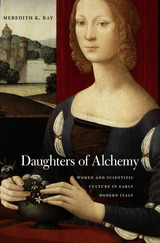 Daughters of Alchemy: Women and Scientific Culture in Early Modern Italy
Meredith K. Ray
Harvard University Press, 2015 The era of the Scientific Revolution has long been epitomized by Galileo. Yet many women were at its vanguard, deeply invested in empirical culture. They experimented with medicine and practical alchemy at home, at court, and through collaborative networks of practitioners. In academies, salons, and correspondence, they debated cosmological discoveries; in their literary production, they used their knowledge of natural philosophy to argue for their intellectual equality to men.
Meredith Ray restores the work of these women to our understanding of early modern scientific culture. Her study begins with Caterina Sforza’s alchemical recipes; examines the sixteenth-century vogue for “books of secrets”; and looks at narratives of science in works by Moderata Fonte and Lucrezia Marinella. It concludes with Camilla Erculiani’s letters on natural philosophy and, finally, Margherita Sarrocchi’s defense of Galileo’s “Medicean” stars.
Combining literary and cultural analysis, Daughters of Alchemy contributes to the emerging scholarship on the variegated nature of scientific practice in the early modern era. Drawing on a range of under-studied material including new analyses of the Sarrocchi–Galileo correspondence and a previously unavailable manuscript of Sforza’s Experimenti, Ray’s book rethinks early modern science, properly reintroducing the integral and essential work of women.
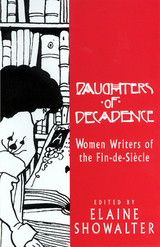 Daughters of Decadence: Women Writers of the Fin de Siecle
Showalter, Elaine
Rutgers University Press, 1993 At the turn of the century, short stories by -- and often about -- "New Women" flooded the pages English and American magazines such as the Atlantic Monthly, Harpers, and the Yellow Book. This daring new fiction, often innovative in form and courageous in its candid representations of female sexuality, marital discontent, and feminist protest, shocked Victorian critics, who denounced the authors as "literary degenerates" or "erotomaniacs." This collection brings together twenty of the most original and important stories from this period. The writers included in this highly readable volume are Kate Chopin, Victoria Cross, George Egerton, Julia Constance Fletcher, Charlotte Perkins Gilman, Sarah Grand, Vernon Lee, Ada Leverson, Charlotte Mew, Olive Schreiner, Edith Wharton, Constance Fenimore Woolson, and Mabel E. Wotton. As Elaine Showalter shows in her introduction, the short fiction of the Fin-de-Siecle is the missing link between the Golden Age of Victorian women writers and the new era of feminist modernism.
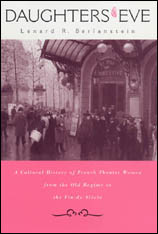 Daughters of Eve: A Cultural History of French Theater Women from the Old Regime to the Fin de Siècle
Lenard R. Berlanstein
Harvard University Press, 2001 Famous and seductive, female stage performers haunted French public life in the century before and after the Revolution. This pathbreaking study delineates the distinctive place of actresses, dancers, and singers within the French erotic and political imaginations. From the moment they became an unofficial caste of mistresses to France's elite during the reign of Louis XIV, their image fluctuated between emasculating men and delighting them.
Drawing upon newspaper accounts, society columns, theater criticism, government reports, autobiographies, public rituals, and a huge corpus of fiction, Lenard Berlanstein argues that the public image of actresses was shaped by the political climate and ruling ideology; thus they were deified in one era and damned in the next. Tolerated when civil society functioned and demonized when it faltered, they finally passed from notoriety to celebrity with the stabilization of parliamentary life after 1880. Only then could female fans admire them openly, and could the state officially recognize their contributions to national life.
Daughters of Eve is a provocative look at how a culture creates social perceptions and reshuffles collective identities in response to political change.
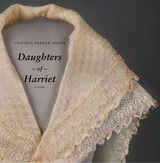 Daughters of Harriet
Cynthia Parker-Ohene
University Press of Colorado, 2022 Finalist, 2022 Los Angeles Times Book Prize for Poetry
Finalist, 2022 Foreword INDIES for Poetry
Finalist, 2022 Golden Poppy Award for Poetry
Finalist, 2022 San Francisco/Nomadic Literary Award for Poetry
Drawing inspiration from the life of Harriet Tubman, Cynthia Parker-Ohene’s poetic narratives follow a historical arc of consciousness of Black folks: mislaid in potters’ fields and catalogued with other misbegotten souls, now unsettled as the unknown Black denominator. Who loved them? Who turned them away? Who dismembered their souls? In death, they are the institutionalized marked Black bodies assigned to parcels, scourged beneath plastic sheets identified as a number among Harriets as black, marked bodies. These poems speak to how the warehousing of enslaved and somewhat free beings belies their humanity through past performances in reformatories, workhouses, and hospitals for the negro insane. To whom did their Black lives belong? How are Black grrls socialized within the family to be out in the world? What is the beingness of Black women? How have the Harriets—the descended daughters of Harriet Tubman—confronted issues of caste and multiple oppressions? These poems give voice to the unspeakable, the unreachable, the multiple Black selves waiting to become.
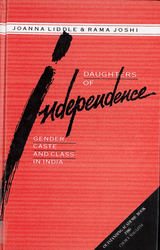 Daughters of Independence
Joanna Liddle
Rutgers University Press, 1989 Joanna Liddle and Rama Joshi explore the connection in India between gender and caste, and gender and class. They ask whether the subordination of women has diminished as India moves from a caste to a class structure, and what effect colonization had on the status of women in India. Focusing on educated, professional women, the authors look at the particular experiences of 120 women they interviewed, and also interpret the larger patterns of social relations that emerge from the interviews. These sensitive stories are told with an eloquence that is often moving and inspiring. For thousands of years Indian women have had a cultural tradition of resisting male domination. At the same time, the control of female sexuality has always been central to social hierarchies in India. Women are constrained in both class and caste hierarchies, to help distinguish the men at the top of the hierarchy from men at the bottom, where women are less constrained. In class society the seclusion of women allowed men to have sexual control over women and to retain the property that was transferred in marriage. In contemporary India, professional women have had success entering the professions as the social groups to which they belong move increasingly to class rather than caste structures. But men continue to control the type of education they receive and the type of employment open to them, and to participate in the sexual harassment of women in the workplace. The concept that women are inferior to men--a concept that is not part of the Indian cultural heritage--is growing. In a sense, working professional women strengthen male control. The class structure is no more egalitarian than the caste structure, as oppression simply takes other forms.
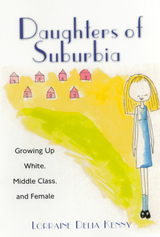 Daughters of Suburbia: Growing Up White, Middle Class, and Female
Edited by Lorraine Delia Kenny
Rutgers University Press, 2000 White middle-class suburbia represents all that is considered "normal" in the United States, especially to the people who live its privileged life. Part ethnography, part cultural study, Daughters of Suburbia focuses on the lives of teenage girls from this world--the world of the Long Island, New York, middle school that author Lorraine Kenny once attended--to examine how standards of normalcy define gender, exercise power, and reinforce the cultural practices of whiteness.
In order to move beyond characterizations of "the normal" (a loaded term that can obscure much of what actually defines this culture), Kenny highlights both the experiences of the middle-school students and the stories of three notoriously "bad" white middle-class teenage girls: Amy Fischer, the "Pistol-Packing Long Island Lolita," Cheryl Pierson, who hired a classmate to murder her father, and Emily Heinrichs, a former white supremacist and a teen mom. Arguing that middle-class whiteness thrives on its invisibility--on not being recognized as a cultural phenomenon--Kenny suggests that what the media identify as aberrant, as well as what they choose not to represent, are the keys to identifying the unspoken assumptions that constitute middle-class whiteness as a cultural norm. Daughters of Suburbia makes the familiar strange and gives substance to an otherwise intangible social position. Lorraine Kenny is the Public Education Coordinator for the American Civil Liberties Union's Reproductive Freedom Project. She has taught anthropology at Sarah Lawrence College.
 Daughters of the Union: Northern Women Fight the Civil War
Nina Silber
Harvard University Press, 2005 Daughters of the Union casts a spotlight on some of the most overlooked and least understood participants in the American Civil War: the women of the North. Unlike their Confederate counterparts, who were often caught in the midst of the conflict, most Northern women remained far from the dangers of battle. Nonetheless, they enlisted in the Union cause on their home ground, and the experience transformed their lives.
Nina Silber traces the emergence of a new sense of self and citizenship among the women left behind by Union soldiers. She offers a complex account, bolstered by women's own words from diaries and letters, of the changes in activity and attitude wrought by the war. Women became wage-earners, participants in partisan politics, and active contributors to the war effort. But even as their political and civic identities expanded, they were expected to subordinate themselves to male-dominated government and military bureaucracies.
Silber's arresting tale fills an important gap in women's history. She shows the women of the North--many for the first time--discovering their patriotism as well as their ability to confront new economic and political challenges, even as they encountered the obstacles of wartime rule. The Civil War required many women to act with greater independence in running their households and in expressing their political views. It brought women more firmly into the civic sphere and ultimately gave them new public roles, which would prove crucial starting points for the late-nineteenth-century feminist struggle for social and political equality.
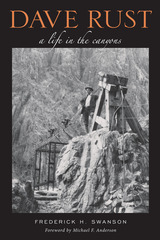 Dave Rust: A Life in the Canyons
Frederick H Swanson
University of Utah Press, 2008 "A thorough traveler must be something of a geologist, something of a botanist, an archaeologist, an ornithologist, an artist, a philosopher, and so on. Through it all he is likely to be friendly with a camera. He must be agreeable in society, contented in solitude, enthusiastic and patient as a fisherman."—Dave Rust
In the fall of 1897, Dave Rust, a young placer miner from Caineville, Utah, looked up from his sluice box on the Colorado River and gazed at the brilliant sandstone cliffs of Glen Canyon. He wasn’t finding much gold, but he knew that this landscape abounded in scenic beauty and that people would pay good money to see it. A quarter century later, he would fulfill his dream of taking adventurous travelers through this stunning canyon in his little canvas-covered canoes. By that time he had amassed a comprehensive knowledge of the geologic wonders of the Colorado Plateau province of Utah and Arizona, and each summer he led month-long pack trips through a mind-boggling variety of cliffs, mesas, mountaintop overlooks, and hidden desert canyons.
David D. Rust (1874–1963) grew up in south-central Utah, and as a young man he worked a variety of jobs. But the canyon country always called to him, and for more than three decades he was the premier backcountry outfitter and guide in southern Utah. He felt that travel was more than a pastime—it was a chance to enrich one’s mind, and he showed the way to achieve a deep understanding of the Colorado Plateau’s fabulous landforms.
Winner of the Evans Biography Award, the Utah State History Association's Best Utah History Book Award, the Mormon History Association Turner-Bergera Best Biography Award, the Utah State Division of History Francis Armstrong Madsen Best Utah History Book Award, and the Utah Book Award in Nonfiction.
 David and Goliath: Commentaries on the Russo-Ukrainian War
Serhii Plokhy
Harvard University Press The biblical image of David and Goliath captures fittingly the nature of the war that Russia, the world’s largest country by surface area, unleashed on neighboring Ukraine, a country that—while still the largest on the European continent—is almost thirty times smaller and has only over a quarter of Russia’s population. Yet Ukraine’s stubborn resistance proves that it is possible to mount a successful defense against an enormously larger, more populous, and better equipped enemy, even despite its threats of nuclear apocalypse should Ukraine refuse to submit and the West dare to interfere. This volume shows that history can help reveal the reasons for Ukraine’s resolve and success on the battlefield and in the public arena.
Collected in David and Goliath for the first time are short essays, commentaries, and interviews written and given by Serhii Plokhy, the world’s preeminent scholar of Ukrainian history, on the eve and during the first two years of Russia’s full-scale invasion of Ukraine. Plokhy draws our attention to the unique nature of the truly historic events of the largest war in Europe since the end of World War II.
 David Cronenberg: Author or Filmmaker?
Mark Browning
Intellect Books, 2007 For more than thirty years, David Cronenberg has made independent films such as Scanners and A History of Violence which aim to disturb, surprise, and challenge audiences. He has also repeatedly drawn on literary fiction for inspiration, adapting themes from authors like William Burroughs, J. G. Ballard, and Patrick McGrath for the big screen; David Cronenberg: Author or Filmmaker? is the first book to explore how underground and mainstream fiction have influenced—and can help illuminate—his labyrinthine films.
Film scholar Mark Browning examines Cronenberg’s literary aesthetic not only in relation to his films’ obvious source material, but by comparing his movies to the writings of Vladimir Nabokov, Angela Carter, and Bret Easton Ellis. This groundbreaking volume addresses Cronenberg’s narrative structures and his unique conception of auteurism, as well as his films’ shocking psychological frameworks, all in the broader context of film adaptation studies. David Cronenberg is an essential read for anyone interested in the symbiotic relationship between literature and filmmaking.
“David Cronenberg is a work that attempts to illuminate and unravel the connection between the great Canadian auteur and his literary influences.”—Film Snob Weekly “David Cronenberg is an essential read for anyone interested in the symbiotic relationship between literature and filmmaking.”—Video Canada
 David Davis, Abraham Lincoln's Favorite Judge
Raymond J. McKoski
University of Illinois Press, 2025 One of Abraham Lincoln’s staunchest and most effective allies, Judge David Davis masterminded the floor fight that gave Lincoln the presidential nomination at the 1860 Republican National Convention. This history-changing event emerged from a long friendship between the two men. It also altered the course of Davis’s career, as Lincoln named him to the U.S. Supreme Court in 1862. Raymond J. McKoski offers a biography of Davis’s public life, his impact on the presidency and judiciary, and his personal, professional, and political relationships with Lincoln. Davis lent his vast network of connections, organizational and leadership abilities, and personal persuasiveness to help Lincoln’s political rise. When Davis became a judge, he honed an ability to hear each case with complete impartiality, a practice that endeared him to Lincoln but one day put him at odds with the president over important Civil War–era rulings. McKoski details these cases while providing an in-depth account of Davis’s role in Lincoln’s two unsuccessful campaigns for U.S. Senate and the fateful run for the presidency.
David Duke and the Politics of Race in the South
John C. Kuzenski
Vanderbilt University Press, 1995 A thought-provoking examination of the constituencies and the impact of one of the most controversial political figures of our time. Journalists have thoroughly documented David Duke's rise to prominence in Louisiana politics, but until now, few intensive analyses of the Duke phenomenon have been undertaken. This new collection identifies the significant junctures of Duke's political career, from its earliest beginnings to his recent campaigns for governor, the Senate, and the Presidency. Through a variety of methods and approaches, the contributors to this work advance our understanding of what made this former Ku Klux Klan member a significant political force, and of how and why he very nearly succeeded in his attempts to gain higher office.
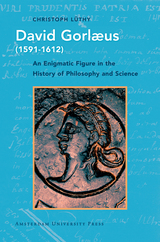 David Gorlæus (1591-1612): An Enigmatic Figure in the History of Philosophy and Science
Christoph Lüthy
Amsterdam University Press, 2013
When David Gorlæus, a prospective theology student, passed away tragically at twenty-one years old, he left behind two highly innovative manuscripts, which were published posthumously in 1620 and 1651, respectively. As his identity was unknown, seventeenth-century readers understood him both as an anti-Aristotelian thinker and a precursor of Descartes. In contrast, by the twentieth century, historians depicted him as an atomist, natural scientist, and even a chemist. David Gorlæus (1591–1612) seeks to pull together what is known of this enigmatic figure. Combining multiple historical sources, Christoph Lüthy provides a narrative of Gorlæus’s life that casts light on his exceptional body of work and places it firmly at the intersection between philosophy, the nascent natural sciences, and theology.
“Christoph Lüthy is the first to tell the complete story of David Gorlæus and to reconstruct his image on the basis of all remaining sources. Showing in a convincing way that Gorlæus is one of the key figures in the renewal of atomistic philosophy in the seventeenth century and a major influence on many philosophers that are much better known, he leaves us with the melancholy picture of someone who died too young to become one of the heroes of the scientific revolution.”—Theo Verbeek, Utrecht University
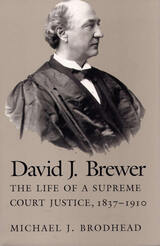 David J Brewer: The Life of a Supreme Court Justice, 1837-1910
Michael J. Brodhead
Southern Illinois University Press, 1994
This is the first biography of David J. Brewer, an Associate Justice of the United States Supreme Court from 1889 to 1910.
Prior to rising to the nation’s highest tribunal, Brewer served as a county probate judge, a state district judge, a Kansas State Supreme Court justice, and a federal circuit court judge. He was known not only for his long tenure on the Supreme Court but also for his numerous off-the-bench statements as an orator and writer.
Many of Brewer’s judicial opinions and nonjudicial utterances created controversy, particularly when he confronted the reform issues of his day. The court, then presided over by Chief Justice Melville W. Fuller, has been seen as reactionary, determined to infuse the law with social Darwinism and laissez-faire ideology. Yet, contrary to this assessment of the Fuller Court as a whole, Brewer accepted most of his generation’s reform goals. He championed many forms of social legislation, the regulation of business, the rights of women and minorities, the support of charities, educational reform, and world peace.
Michael J. Brodhead contends that until recently historians have carelessly and inaccurately created a false image of Brewer, partly by citing a small sample of his opinions and public statements as representative of his alleged conservatism. They have also assumed that the disputable decisions of Brewer and his contemporaries were based on ideological predilections and that precedent and recognized legal principles played no role.
During his term, Brewer was the author of such notable court opinions as In re Debs, Muller v. Oregon, and Kansas v. Colorado. He supported property rights, admired honest entrepreneurial activity, and opposed the concentration of power in any form. Brewer favored the individual in all instances, whether that individual was the initiator of a great economic enterprise or a farmer struggling to extend agriculture into the western plains.
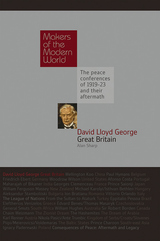 David Lloyd George: Great Britain
Alan Sharp
Haus Publishing, 2010 David Lloyd George (1863-1945). The end of the First World War saw Britain at the height of its power. Its fleet and air force were the largest in the world. Its armies had triumphed in the Middle East and spearheaded the final attacks in Western Europe that had driven the defeated Germans to seek an armistice. Britain now had to translate this military victory into the achievement of its war aims and future security and prosperity. Its main negotiator at the forthcoming peace conference would be its prime minister, the ebullient and enigmatic David Lloyd George, the "Welsh Wizard" and "the man who had won the war." Lloyd George's energy had maintained the war effort through the dark days of 1917 and early 1918, but now he anticipated, with relish, the prospect of winning the peace. Few were better equipped. He was a skilled and accomplished negotiator with the knack of reconciling the apparently irreconcilable. His admirers, of whom there were many, pointed to his brilliant and agile mind, his rapid grasp of complex questions and his powers of persuasion. His critics, who were also numerous, distrusted his sleight of hand, fleetness of foot and, frankly, his word. His six months in Paris in 1919, as he pitted his wits against formidable world leaders like Woodrow Wilson and Georges Clemenceau, were among the most enjoyable but exhausting of his life. This study investigates the extent to which Lloyd George succeeded in his aims and evaluates the immediate and longer-term results of his negotiations for Britain.
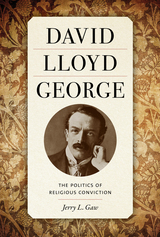 David Lloyd George: The Politics of Religious Conviction
Jerry Gaw
University of Tennessee Press, 2022 Born on January 17, 1863, in Manchester, England, David Lloyd George is perhaps best known for his service as prime minister of the United Kingdom during the second half of World War I. While many biographies have chronicled his life and political endeavors, few, if any, have explored how his devotion to democratic doctrines in the Church of Christ shaped his political perspectives and choices both before and during the First World War. In David Lloyd George: The Politics of Religious Conviction, Jerry L. Gaw bridges this gap in scholarship, showcasing George’s religious roots and their impact on his politics in the late nineteenth and early twentieth centuries.
With a comprehensive narrative that spans more than a century, Gaw’s book ranges beyond typical biography and examines how the work and theology of Alexander Campbell, a founder
of the Stone-Campbell Movement in America, influenced a prominent world leader. George’s twelve diaries and the more than three thousand letters he wrote to his brother between 1886 and 1943 provide the foundation for Gaw’s thorough analysis of George’s beliefs and politics. Taken together, these texts illuminate his lifelong adherence to the Church of Christ in Britain and how his faith, in turn, contributed to his proclivity for championing humanitarian, egalitarian, and popular political policies beginning with the first of his fifty-five years in the British Parliament.
Broadly, Gaw’s study helps us to understand how the Stone-Campbell tradition—and later, Churches of Christ—became contextualized in the British Isles over the course of the nineteenth century. His significant mining of primary materials successively reveals a lesser-known side of David Lloyd George, in large part explaining how he arrived at the political decisions that helped shape history.
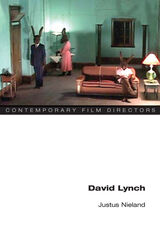 David Lynch
Justus Nieland
University of Illinois Press, 2012 A key figure in the ongoing legacy of modern cinema, David Lynch designs environments for spectators, transporting them to inner worlds built by mood, texture, and uneasy artifice. We enter these famously cinematic interiors to be wrapped in plastic, the fundamental substance of Lynch’s work. This volume revels in the weird dynamism of Lynch’s plastic worlds. Exploring the range of modern design idioms that inform Lynch’s films and signature mise-en-scène, Justus Nieland argues that plastic is at once a key architectural and interior design dynamic in Lynch’s films, an uncertain way of feeling essential to Lynch’s art, and the prime matter of Lynch’s strange picture of the human organism. Nieland’s study offers striking new readings of Lynch’s major works (Eraserhead, Blue Velvet, Wild at Heart, Mulholland Dr., Inland Empire) and his early experimental films, placing Lynch’s experimentalism within the aesthetic traditions of modernism and the avant-garde; the genres of melodrama, film noir, and art cinema; architecture and design history; and contemporary debates about cinematic ontology in the wake of the digital. This inventive study argues that Lynch’s plastic concept of life--supplemented by technology, media, and sensuous networks of an electric world--is more alive today than ever.
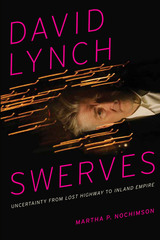 David Lynch Swerves: Uncertainty from Lost Highway to Inland Empire
By Martha Nochimson
University of Texas Press, 2013 Beginning with Lost Highway, director David Lynch “swerved” in a new direction, one in which very disorienting images of the physical world take center stage in his films. Seeking to understand this unusual emphasis in his work, noted Lynch scholar Martha Nochimson engaged Lynch in a long conversation of unprecedented openness, during which he shared his vision of the physical world as an uncertain place that masks important universal realities. He described how he derives this vision from the Holy Vedas of the Hindu religion, as well as from his layman’s fascination with modern physics. With this deep insight, Nochimson forges a startlingly original template for analyzing Lynch’s later films—the seemingly unlikely combination of the spiritual landscape envisioned in the Holy Vedas and the material landscape evoked by quantum mechanics and relativity. In David Lynch Swerves, Nochimson navigates the complexities of Lost Highway, The Straight Story, Mulholland Drive, and Inland Empire with uncanny skill, shedding light on the beauty of their organic compositions; their thematic critiques of the immense dangers of modern materialism; and their hopeful conceptions of human potential. She concludes with excerpts from the wide-ranging interview in which Lynch discussed his vision with her, as well as an interview with Columbia University physicist David Albert, who was one of Nochimson’s principal tutors in the discipline of quantum physics.
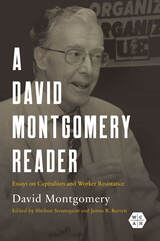 A David Montgomery Reader: Essays on Capitalism and Worker Resistance
David Montgomery. Edited by Shelton Stromquist and James R. Barrett
University of Illinois Press, 2024 A foundational figure in modern labor history, David Montgomery both redefined and reoriented the field. This collection of Montgomery’s most important published and unpublished articles and essays draws from the historian’s entire five-decade career. Taken together, the writings trace the development of Montgomery’s distinct voice and approach while providing a crucial window into an era that changed the ways scholars and the public understood working people’s place in American history. Three overarching themes and methods emerge from these essays: that class provided a rich reservoir of ideas and strategies for workers to build movements aimed at claiming their democratic rights; that capital endured with the power to manage the contours of economic life and the capacities of the state but that workers repeatedly and creatively mounted challenges to the terms of life and work dictated by capital; and that Montgomery’s method grounded his gritty empiricism and the conceptual richness of his analysis in the intimate social relations of production and of community, neighborhood, and family life.
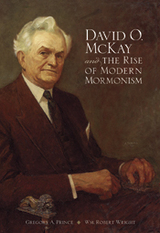 David O. McKay and the Rise of Modern Mormonism
Gregory A Prince
University of Utah Press, 2005 Ordained as an apostle in 1906, David O. McKay served as president of the Church of Jesus Christ of Latter-day Saints from 1951 until his death in 1970. Under his leadership, the church experienced unparalleled growth—nearly tripling in total membership—and becoming a significant presence throughout the world.
The first book to draw upon the David O. McKay Papers at the J. Willard Marriott Library at the University of Utah, in addition to some two hundred interviews conducted by the authors, David O. McKay and the Rise of Modern Mormonism focuses primarily on the years of McKay's presidency. During some of the most turbulent times in American and world history, McKay navigated the church through uncharted waters as it faced the challenges of worldwide growth in an age of communism, the civil rights movement, and ecumenism. Gregory Prince and Robert Wright have compiled a thorough history of the presidency of a much-loved prophet who left a lasting legacy within the LDS Church.
Winner of the Evans Handcart Award.
Winner of the Mormon History Association Turner-Bergera Best Biography Award.
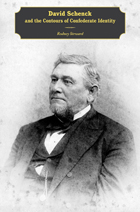 David Schenck and the Contours of Confederate Identity
Rodney Steward
University of Tennessee Press, 2012 A mid-level Confederate official and lawyer in secessionist North Carolina, David Schenck (1835–1902) penned extensive diaries that have long been a wellspring of information for historians. In the midst of the secession crisis, Schenck overcame long-established social barriers and reshaped antebellum notions of manhood, religion, and respectability into the image of a Confederate nationalist. He helped found the revolutionary States’ Rights Party and relentlessly pursued his vision of an idealized Southern society even after the collapse of the Confederacy. In the first biography of this complicated figure, Rodney Steward opens a window into the heart and soul of the Confederate South’s burgeoning professional middle class and reveals the complex set of desires, aspirations, and motivations that inspired men like Schenck to cast for themselves a Confederate identity that would endure the trials of war, the hardship of Reconstruction, and the birth of a New South.
After secession, Schenck remained on the home front as a receiver under the Act of Sequestration, enriching himself on the confiscated property of those he accused of disloyalty. After the war, his position as a leader in the Ku Klux Klan and his resistance to Radical Reconstruction policies won him a seat on the superior court bench, but scathing newspaper articles about his past upended a bid for chief justice of the North Carolina Supreme Court, a compelling fall from grace that reveals much about the shifting currents in North Carolina society and politics in the years after Reconstruction. During the last twenty years of his life, spent in Greensboro, Schenck created the Guilford Battleground Company in an effort to redeem the honor of the Tar Heels who fought there and his own honor as well.
Schenck’s life story provides a powerful new lens to examine and challenge widely held interpretations of secessionists, Confederate identity, Civil War economics, and home-front policies. Far more than a standard biography, this compelling volume challenges the historiography of the Confederacy at many levels and offers a sophisticated analysis of the evolution of a Confederate identity over a half century.
Rodney Steward is an assistant professor of history at the University of South Carolina, Salkehatchie. His works have appeared in the Virginia Magazine of History and Biography, Encyclopedia of North Carolina, and North Carolina Historical Review.
David to Corot: French Drawings in the Fogg Art Museum
Agnes Mongan
Harvard University Press, 1996 The Harvard University Art Museums hold one of the world’s finest collections of early nineteenth-century drawings; the nearly 500 works reproduced in this catalogue include the most significant groups of drawings outside France by the masters of the age—David, Gericault, Ingres, Delacroix, and Prud’hon. Although familiar to scholars, the collection has never been the subject of a comprehensive catalogue, and many of the drawings are published here for the first time.
David to Delacroix
Walter Friedlaender
Harvard University Press This renowned study follows the evolution of French painting from the Revolution through the Napoleonic era. Beginning with David's revolutionary classicism, Friedlaender scrutinizes the work of early-nineteenth-century artists against the background of their times. He reveals the baroque tendencies diffused into the art of Prudhon and the same predisposition, mixed with a strong realism, in the work of Géricault.
Two distinct trends appear, deriving from Pussin and Rubens. The author follows the styles as they mature, and represents their consumation in two great masters—the refined and abstract classicism of Ingres and the baroque of Delacroix with its flamboyant colorism and exotic subjects.
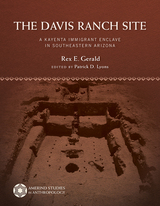 The Davis Ranch Site: A Kayenta Immigrant Enclave in Southeastern Arizona
Rex E. Gerald, Edited by Patrick D. Lyons
University of Arizona Press, 2019 In this new volume, the results of Rex E. Gerald’s 1957 excavations at the Davis Ranch Site in southeastern Arizona’s San Pedro River Valley are reported in their entirety for the first time.
Annotations to Gerald’s original manuscript in the archives of the Amerind Museum and newly written material place Gerald’s work in the context of what is currently known regarding the late thirteenth-century Kayenta diaspora and the relationship between Kayenta immigrants and the Salado phenomenon. Data presented by Gerald and other contributors identify the site as having been inhabited by people from the Kayenta region of northeastern Arizona and southeastern Utah.
The results of Gerald’s excavations and Archaeology Southwest’s San Pedro Preservation Project (1990–2001) indicate that the people of the Davis Ranch Site were part of a network of dispersed immigrant enclaves responsible for the origin and spread of Roosevelt Red Ware pottery, the key material marker of the Salado phenomenon.
A companion volume to Charles Di Peso’s 1958 publication on the nearby Reeve Ruin, archaeologists working in the U.S. Southwest and other researchers interested in ancient population movements and their consequences will consider this work an essential case study.
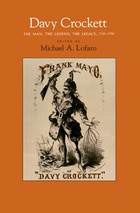 Davy Crockett: The Man, the Legend, the Legacy, 1786–1986
Michael A. Lofaro
University of Tennessee Press, 1986 Who was Davy Crockett? Was he really born on a mountaintop? Did he wear a coonskin cap?
This collection of eight essays exposes both truth and fiction surrounding the legendary David Crockett. The essayists, including Charles K. Wolfe, Norman Bruce, and Catherine L. Albanese, chronicle Crockett's growth from an obscure backwoods hunter turned storytelling politician to the representative symbol of the American frontier in both its noble and its savage aspects. Together, the essays trace the development of Crockett's legend, his ability to manipulate it during his lifetime for political ends, and, after his death, its boundless expansion in the popular media of his day and ours. He grows to gigantic proportions, as the United States likewise expands, in the tall tales that dominate the Crockett almanacs, in melodramas of stage and screen, and in a Disney-inspired "Crockett craze."
In all this, Crockett mirrors the range and diversity of the country that made him a hero and documents the ever-changing mental image we have of ourselves as a nation and as individuals. Illustrated with more than forty illustrations and carefully edited by Michael Lofaro, this collection examines the many facets of Crockett's life and legend and places them in a larger critical framework to highlight the inseparability of the two, revealing the huge effect this composite Crockett has come to have on American popular thought and culture.
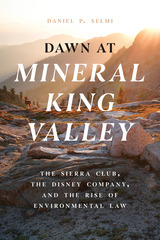 Dawn at Mineral King Valley: The Sierra Club, the Disney Company, and the Rise of Environmental Law
Daniel P. Selmi
University of Chicago Press, 2022 The story behind the historic Mineral King Valley case, which reveals how the Sierra Club battled Disney’s ski resort development and launched a new environmental era in America.
In our current age of climate change–induced panic, it’s hard to imagine a time when private groups were not actively enforcing environmental protection laws in the courts. It wasn’t until 1972, however, that a David and Goliath–esque Supreme Court showdown involving the Sierra Club and Disney set a revolutionary legal precedent for the era of environmental activism we live in today.
Set against the backdrop of the environmental movement that swept the country in the late 1960s and early 1970s, Dawn at Mineral King Valley tells the surprising story of how the US Forest Service, the Disney company, and the Sierra Club each struggled to adapt to the new, rapidly changing political landscape of environmental consciousness in postwar America. Proposed in 1965 and approved by the federal government in 1969, Disney’s vast development plan would have irreversibly altered the practically untouched Mineral King Valley, a magnificently beautiful alpine area in the Sierra Nevada mountains. At first, the plan met with unanimous approval from elected officials, government administrators, and the press—it seemed inevitable that this expanse of wild natural land would be radically changed and turned over to a private corporation. Then the scrappy Sierra Club forcefully pushed back with a lawsuit that ultimately propelled the modern environmental era by allowing interest groups to bring litigation against environmentally destructive projects.
An expert on environmental law and appellate advocacy, Daniel P. Selmi uses his authoritative narrative voice to recount the complete history of this revolutionary legal battle and the ramifications that continue today, almost 50 years later.
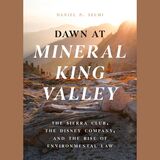 Dawn at Mineral King Valley: The Sierra Club, the Disney Company, and the Rise of Environmental Law
Daniel P. Selmi
University of Chicago Press, 2022 This is an auto-narrated audiobook edition of this book. The story behind the historic Mineral King Valley case, which reveals how the Sierra Club battled Disney’s ski resort development and launched a new environmental era in America.
In our current age of climate change–induced panic, it’s hard to imagine a time when private groups were not actively enforcing environmental protection laws in the courts. It wasn’t until 1972, however, that a David and Goliath–esque Supreme Court showdown involving the Sierra Club and Disney set a revolutionary legal precedent for the era of environmental activism we live in today.
Set against the backdrop of the environmental movement that swept the country in the late 1960s and early 1970s, Dawn at Mineral King Valley tells the surprising story of how the US Forest Service, the Disney company, and the Sierra Club each struggled to adapt to the new, rapidly changing political landscape of environmental consciousness in postwar America. Proposed in 1965 and approved by the federal government in 1969, Disney’s vast development plan would have irreversibly altered the practically untouched Mineral King Valley, a magnificently beautiful alpine area in the Sierra Nevada mountains. At first, the plan met with unanimous approval from elected officials, government administrators, and the press—it seemed inevitable that this expanse of wild natural land would be radically changed and turned over to a private corporation. Then the scrappy Sierra Club forcefully pushed back with a lawsuit that ultimately propelled the modern environmental era by allowing interest groups to bring litigation against environmentally destructive projects.
An expert on environmental law and appellate advocacy, Daniel P. Selmi uses his authoritative narrative voice to recount the complete history of this revolutionary legal battle and the ramifications that continue today, almost 50 years later.
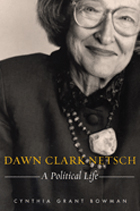 Dawn Clark Netsch: A Political Life
Cynthia Grant Bowman
Northwestern University Press, 2010 Illinois Democratic politics has recently produced the most skilled and inspirational politician in memory . . . and has also reminded us of the need for further reform. It is fitting, then, that the latest installment of the Chicago Lives series turns to Dawn Clark Netsch, a leading reformer of Illinois politics since the 1950s and the first woman major party nominee for governor of Illinois. Netsch was a pioneer, or the first of her gender, in almost every endeavor she undertook. From the very beginning of her career, when she led the move to desegregate Northwestern University's undergraduate dorms, her passion for social justice extended beyond the rights of women to rights for racial minorities and those of all sexual orientations. Bowman charts Dawn Clark Netsch's remarkable political career, from her work behind the scenes as assistant to Governor Otto Kerner and as a participant in the 1970 Constitutional Convention to her later service in elected office, first as Illinois state senator for eighteen years and later as Illinois comptroller, and culminating in her historic run for governor in 1994. Throughout, Netsch lost neither her genteel yet unpretentious demeanor, nor her passion for progressive politics as exemplified by her early mentor, Governor Adlai E. Stevenson.
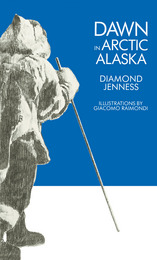 Dawn in Arctic Alaska
Diamond Jenness
University of Chicago Press, 1985 "The Karluk had disappeared. Whether the vessel had freed itself from the ice and steamed eastward, or whether, still imprisoned, it had been carried by the ice westward, we could not know. In any case it was gone, leaving our hunting party of six men marooned on a sandy islet surrounded by thin ice and open water. The wind finally died away, in the calm air the water rapidly froze over again, and on September 30 we crossed with our two sleds to the mainland."
In 1913 a young ethnologist from New Zealand boarded a ship for the Arctic, beginning a personal journey that was to make Diamond Jenness one of the twentieth century's foremost authorities on Alaskan Eskimos. Jenness had been asked to join the Stefansson expedition, and his official duties were to collect ethnographic details on the Eskimos—their culture, technology, religion, and social organization. His account of the expedition was published as People of the Twilight in 1928, but Jenness also kept a diary of his three years among the Eskimos. He was eventually persuaded to publish it as Dawn in Arctic Alaska.
Predating the genre of personal ethnographies that has become so popular and important today, Jenness's tales blend his keen observations of the Arctic and its people with his own reflections and sensory experiences. He expresses great adimiration for the customs and character of the Eskimos and great regret and disappointment over the destruction of their lifeway through contact with white men.
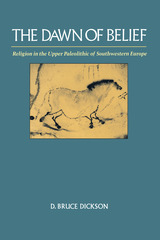 The Dawn of Belief: Religion in the Upper Paleolithic of Southwestern Europe
D. Bruce Dickson
University of Arizona Press, 1990 Hunter-gatherers of the Upper Paleolithic period of the late Pleistocene epoch in western Europe left a legacy of cave paintings and material remains that have long fascinated modern man. This book draws on theories derived from cultural anthropology and cognitive archaeology to propose a reconstruction of the religious life of those people based on the patterning and provenience of their artifacts.
Based on the premises that all members of Homo sapiens sapiens share basically similar psychological processes and capabilities and that human culture is patterned, the author uses ethnographic analogy, inference from material patterns, and formal analysis to find in prehistoric imagery clues to the cosmology that lay behind them. The resulting book is an intriguing speculation on the nature of paleolithic religion, offering scholars a valuable synthesis of anthropological, archaeological, and sociological research, and general readers an accessible account of how our forebears may have regarded the unknown.
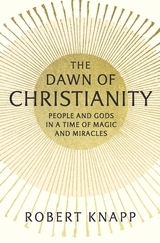 The Dawn of Christianity: People and Gods in a Time of Magic and Miracles
Robert Knapp
Harvard University Press, 2017 Ordinary people of antiquity interacted with the supernatural through a mosaic of beliefs and rituals. Exploring everyday life from 200 BCE to the end of the first century CE, Robert Knapp shows that Jews and polytheists lived with the gods in very similar ways. Traditional interactions provided stability even in times of crisis, while changing a relationship risked catastrophe for the individual, his family, and his community. However, people in both traditions did at times leave behind their long-honored rites to try something new. The Dawn of Christianity reveals why some people in Judea and then in the Roman and Greek worlds embraced a new approach to the forces and powers in their daily lives.
Knapp traces the emergence of Christianity from its stirrings in the eastern Mediterranean, where Jewish monotheism coexisted with polytheism and prayer mixed with magic. In a time receptive to prophetic messages and supernatural interventions, Jesus of Nazareth convinced people to change their beliefs by showing, through miracles, his direct connection to god-like power. The miracle of the Resurrection solidified Jesus’s supernatural credentials. After his death, followers continued to use miracles and magic to spread Jesus’s message of reward for the righteous in this life and immortality in the next.
Many Jews and polytheists strongly opposed the budding movement but despite major setbacks Christianity proved resilient and adaptable. It survived long enough to be saved by a second miracle, the conversion of Emperor Constantine. Hand in hand with empire, Christianity began its long march through history.
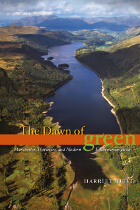 The Dawn of Green: Manchester, Thirlmere, and Modern Environmentalism
Harriet Ritvo
University of Chicago Press, 2009 Located in the heart of England’s Lake District, the placid waters of Thirlmere seem to be the embodiment of pastoral beauty. But under their calm surface lurks the legacy of a nineteenth-century conflict that pitted industrial progress against natural conservation—and helped launch the environmental movement as we know it. Purchased by the city of Manchester in the 1870s, Thirlmere was dammed and converted into a reservoir, its water piped one hundred miles south to the burgeoning industrial city and its workforce. This feat of civil engineering—and of natural resource diversion—inspired one of the first environmental struggles of modern times. The Dawn of Green re-creates the battle for Thirlmere and the clashes between conservationists who wished to preserve the lake and developers eager to supply the needs of a growing urban population. Bringing to vivid life the colorful and strong-minded characters who populated both sides of the debate, noted historian Harriet Ritvo revisits notions of the natural promulgated by romantic poets, recreationists, resource managers, and industrial developers to establish Thirlmere as the template for subsequent—and continuing—environmental struggles.
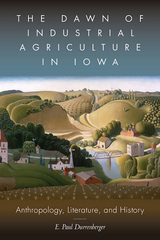 The Dawn of Industrial Agriculture in Iowa: Anthropology, Literature, and History
E. Paul Durrenberger
University Press of Colorado, 2021 In The Dawn of Industrial Agriculture in Iowa E. Paul Durrenberger recounts the transformation of Iowa’s family farms into today’s agricultural industry through the lens of the lives and writings of Iowa novelist Paul Corey and poet Ruth Lechlitner. This anthropological biography analyzes Corey’s fiction, Lechlitner’s poetry, and their professional and personal correspondence to offer a new perspective on an era (1925–1947) that saw the collapse and remaking of capitalism in the United States, the rise of communism in the Soviet Union, the rise and defeat of fascism around the world, and the creation of a continuous warfare state in America.
Durrenberger tells the story that Corey aimed to record and preserve of the industrialization of Iowa’s agriculture and the death of its family farms. He analyzes Corey’s regionalist focus on Iowa farming and regionalism’s contemporaneous association in Europe with rising fascism. He explores Corey’s adoption of naturalism, evident in his resistance to heroes and villains, to plot structure and resolution, and to moral judgment, as well as his ethnographic tendency to focus on groups rather than individuals.
An unusual and wide-ranging study, The Dawn of Industrial Agriculture in Iowa offers important insight into the relationships among fiction, individual lives, and anthropological practice, as well as into a pivotal period in American history.
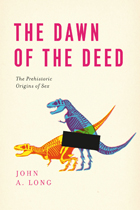 The Dawn of the Deed: The Prehistoric Origins of Sex
John A. Long
University of Chicago Press, 2012 We all know about the birds and the bees, but what about the ancient placoderm fishes and the dinosaurs? The history of sex is as old as life itself—and as complicated and mysterious. And despite centuries of study there is always more to know. In 2008, paleontologist John A. Long and a team of researchers revealed their discovery of a placoderm fish fossil, known as “the mother fish,” which at 380 million years old revealed the oldest vertebrate embryo—the earliest known example of internal fertilization. As Long explains, this find led to the reexamination of countless fish fossils and the discovery of previously undetected embryos. As a result, placoderms are now considered to be the first species to have had intimate sexual reproduction or sex as we know it—sort of. Inspired by this incredible find, Long began a quest to uncover the paleontological and evolutionary history of copulation and insemination. In The Dawn of the Deed, he takes readers on an entertaining and lively tour through the sex lives of ancient fish and exposes the unusual mating habits of arthropods, tortoises, and even a well-endowed (16.5 inches!) Argentine Duck. Long discusses these significant discoveries alongside what we know about reproductive biology and evolutionary theory, using the fossil record to provide a provocative account of prehistoric sex. The Dawn of the Deed also explores fascinating revelations about animal reproduction, from homosexual penguins to monogamous seahorses to the difficulties of dinosaur romance and how sexual organs in ancient shark-like fishes actually relate to our own sexual anatomy. The Dawn of the Deed is Long’s own story of what it’s like to be a part of a discovery that rewrites evolutionary history as well as an absolutely rollicking guide to sex throughout the ages in the animal kingdom. It’s natural history with a naughty wink.
Dawnland Encounters: Indians and Europeans in Northern New England
Edited by Colin G. Calloway
University Press of New England, 1991 Colin G. Calloway collects, for the first time, documents describing the full range of encounters of Indians and Europeans in northern New England during the Colonial era. His comprehensive and highly readable introduction to the subject of Indian and European interaction in northern New England covers early encounters, missionary efforts, diplomacy, war, commerce, and cultural interchange and features a wide range of primary sources, including narratives, letters, account books, treaties, and council proceedings. Together with period illustrations, the documents testify to the richness and variety of the inter-ethnic relations in northern New England. They also show that while conflict certainly occurred, the encounters were also marked by cooperation and accommodation.
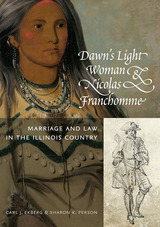 Dawn's Light Woman & Nicolas Franchomme: Marriage and Law in the Illinois Country
Carl J. Ekberg and Sharon K. Person
Southern Illinois University Press, 2022 WINNER, 2023 Illinois State Historical Society Superior Achievement Award in “Books, Scholarly”!
Native women’s marital rights and roles in colonial Illinois society
Kaskaskia, Illinois, once the state’s capital, torn from the state by flood waters, and now largely forgotten, was once the home to a couple who helped transform the region in the 1720s from a frontier village to a civil society. In the heart of France’s North American empire, the village was a community of French-Canadian fur traders and Kaskaskia Indians who not only lived together but often intermarried. These Indigenous and French intermarriages were central to colonial Illinois society, and the coupling of Marguerite 8assecam8c8e (Dawn’s Light Woman) and Nicolas Franchomme, in particular, was critical to expanding the jurisdiction of French law.
While the story of Marguerite and Nicolas is unknown today, it is the story of how French customary law (Coutume de Paris) governed colonial marriage, how mixed Indian-French marriages stood at the very core of early colonial Illinois society, and how Illinois Indian women benefited, socially and legally, from being married to French men. All of this came about due to a lawsuit in which Nicolas successfully argued that his wife had legal claim to her first husband’s estate—a legal decision that created a precedent for society in the Illinois Country.
Within this narrative of a married couple and their legal fight—based on original French manuscripts and supported by the comprehensively annotated 1726 Illinois census—is also the story of the village of Kaskaskia during the 1720s, of the war between Fox Indians and French settlers, with their Indian allies, in Illinois, and of how the spread of plow agriculture dramatically transformed the Illinois Country’s economy from largely fur trade–based to expansively agricultural.
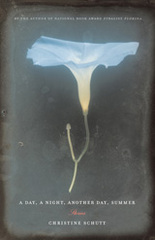 A Day, A Night, Another Day, Summer: Stories
Christine Schutt
Northwestern University Press, 2005 The title of Christine Schutt's second collection strikes the theme of swiftly passing time that runs through each of the stories. In "The Life of the Palm and the Breast" a woman watches her half-grown children running through the house and wonders: Whose boys are these? Whose life is this? The title story tells of a grandfather who has lived long enough to see his daughter's struggles echoed in his granddaughter and how her unhappiness leads him to unexpectedly feel the weight of his years. In "Darkest of All" a mother's relationship with her sons is wreaked by a repeated cycle of drugs and abusive relationships, the years pass and the pain-and its chosen remedy-remains the same. The narrator in "Winterreise" evokes Thoreau and strives to be heroic in the face of her longtime friend's imminent death, a harsh reminder of the time that is allotted to each of us.
Schutt's indomitable, original talent is once again on full display in each of these deeply informed, intensely realized stories. Many of the narratives take place in a space as small as a house, where the doors are many and what is hidden behind these thin domestic barriers tends towards violence, abusive sex, and mental anguish. Schutt opens these doors in sudden, bold moments that also reveal how the characters are often hopeful, even optimistic. With a style that is at once sensual and spare, dreamlike and deliberate, she exposes the terrible intimacy of the rooms and corridors of our innermost lives.
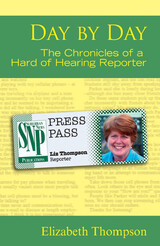 Day by Day: The Chronicles of a Hard of Hearing Reporter
Elizabeth Thompson
Gallaudet University Press, 2008 The Seventh Volume in the Deaf Lives Series Elizabeth Thompson’s hearing loss was detected when she was in elementary school, and her hearing continued to deteriorate until she became completely deaf. Like many other hard of hearing and late-deafened individuals, her hearing loss complicated the general challenges of life. She struggled through school, worked as a secretary, married, had a daughter, and then found herself living as a single mother. She remarried, and soon after learned that she had contracted Multiple Sclerosis (MS). Despite these hurdles, Thompson always expressed her determination to enjoy the best life had to offer. Her astonishing exuberance might have gone unnoticed if she hadn’t accepted a new position as a reporter/columnist in 1998 for the Suburban News Publications (SNP). Day by Day: The Chronicles of a Hard of Hearing Reporter presents a marvelous blend of her experiences and best SNP columns that illustrate how she crafted her remarkable outlook.
In her columns, Thompson presented how she handled her hearing loss as a personal guide for readers. She used every stratagem available to function full-throttle – hearing aids, FM systems, lights for alarms, TTYs, even training her dog Snert. She also gently counseled readers on how to treat deaf and hard of hearing people with practical consideration and respect. Her pursuit of a fully realized life enabled her to do what she loved most, to meet and write about inspiring persons, many of whom are profiled in her memoir. Thompson eventually underwent cochlear implantation that restored 95% of her hearing, an exalting moment for her. Yet, Day by Day celebrates the entire arc of her life, a wonderful testament to her joyous resilience.
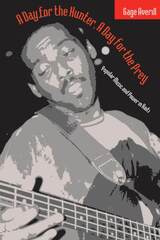 A Day for the Hunter, a Day for the Prey: Popular Music and Power in Haiti
Gage Averill
University of Chicago Press, 1997 The history of Haiti throughout the twentieth century has been marked by oppression at the hands of colonial and dictatorial overlords. But set against this "day for the hunter" has been a "day for the prey," a history of resistance, and sometimes of triumph. With keen cultural and historical awareness, Gage Averill shows that Haiti's vibrant and expressive music has been one of the most highly charged instruments in this struggle—one in which power, politics, and resistance are inextricably fused.
Averill explores such diverse genres as Haitian jazz, troubadour traditions, Vodou-jazz, konpa, mini-djaz, new generation, and roots music. He examines the complex interaction of music with power in contexts such as honorific rituals, sponsored street celebrations, Carnival, and social movements that span the political spectrum.
With firsthand accounts by musicians, photos, song texts, and ethnographic descriptions, this book explores the profound manifestations of power and song in the day-to-day efforts of ordinary Haitians to rise above political repression.
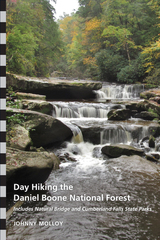 Day Hiking the Daniel Boone National Forest
Johnny Molloy
University of Tennessee Press, 2019 Kentucky’s Daniel Boone National Forest is one of the crown jewels of the Bluegrass State’s outdoor attractions. Yet until now, there has been no detailed guidebook on this beautiful area. Johnny Molloy, a veteran guidebook writer, has compiled a detailed resource for enjoyable adventures in the Daniel Boone National Forest (DBNF).
In this guide, Molloy leads readers through forty hikes within the natural wonders of DBNF, including Natural Bridge and Cumberland Falls. Descriptions of each hike are straightforward and accurate, so readers can focus on enjoying natural features, scenic overlooks, interesting geological formations, and landmarks along the trails. Hikers will see the best of the Cumberland Plateau, from exquisite arches to bluffs that offer extensive vistas to waterfalls that descend into sandstone cathedrals. The paths tread through deep forests in gorges cut by creeks and rivers and atop the Cumberland Plateau, where oak and pine forests range long distances. Rockhouses, caves, and other geological features stand out in these rich woodlands. Hikers may also encounter protected plants and animals along these trails, including the red-cockaded woodpecker, Virginia big-eared bat, freshwater mussels, white-haired goldenrod, and the black bear.
Detailed, easy-to-follow directions for each trail will allow hikers to progress on their chosen course without frustrating detours. The hikes range in distance, difficulty, and destination, offering the full breadth of hiking experiences to be had within the DBNF. The shortest hike is under a mile, and the longest is ten, with most somewhere in the middle. Hikers can use the chart at beginning of the book to select the perfect trail for their experience level and desires. Also included are detailed trail maps and photos.
For the new hiker as well as the experienced outdoor adventurer, Day Hiking Kentucky’s Daniel Boone National Forest is sure to become an indispensable guide to one of Kentucky’s national treasures.
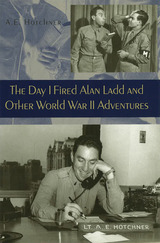 The Day I Fired Alan Ladd and Other World War II Adventures
A. E. Hotchner
University of Missouri Press, 2002 "To perform heroically in a perilous situation is one thing, but I found that, in my case, the real difficulty was in getting myself into a spot where heroism was possible. Nobody on latrine duty ever got the Medal of Honor." This delightful memoir of A. E. Hotchner’s World War II experiences explores a different side of the troubled war years. Hotchner, who grew up in St. Louis, was a rookie lawyer fresh out of Washington University Law School when the United States declared war. Like many others of his generation, he aspired to serve his country. He tried to enlist in the navy, first as a pilot and then as a deck officer, but he was rejected for faulty depth perception and flat feet, respectively. Drafted as a lowly GI into the air force branch of the army, he was accepted to bombardier school. But on the eve of his departure, he was ordered to write and perform in an air force musical comedy instead. He eventually went to Officer Candidate School and was assigned to the Anti-Submarine Command as a lieutenant adjutant, but just before his squadron’s departure for North Africa he was detached and, despite knowing nothing about moviemaking, ordered to make a film that glorified the Anti-Submarine Command’s role in combating U-boats. All through his four-year military career, despite his efforts to get into combat, fate and the military bureaucracy thwarted him. The author skillfully recounts the events of those years, describing the encounters he had with many unforgettable characters, including a footsore and sentimental Clark Gable and an inept Alan Ladd—best known as the star of Shane. Ladd, then a GI, did such a poor job reading the narration for Hotchner’s film Atlantic Mission that Hotchner had to fire him. The author also describes his encounters with other well-known people, notably Tennessee Williams, with whom he attended a playwriting class at Washington University, and a wistful, vulnerable Dorothy Parker. Although much of Hotchner’s memoir is lighthearted, it also provides a unique look at the impact of the war on everyday life in the United States. Hotchner’s fast-paced prose makes this memoir an insightful pleasure to read.
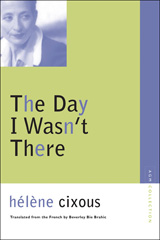 The Day I Wasn't There
Helene Cixous
Northwestern University Press, 2006 In this memoir-novel, a narrator who resembles Hélène Cixous obsessively recounts an incident--the premature death of her first-born child, a Down Syndrome baby left in the care of the clinic in Algeria where her midwife mother works. She uses this event to probe her family history and her relationship with her mother, a refugee from Nazi Germany; her dead father, after whom the baby is named; and her medical-student brother, who takes on some of the duties of a father figure.
Cixous's elusive writing bears all the trademarks of her poetic, provocative style, vivid with word play, intense feeling and a stream-of-consciousness that moves freely over time and place. The narrator's mother claims not to remember what happened, and the brother tries to fill in some gaps in the story. By the end of the book we understand the significance of the title: one day Cixous's mother returned to the clinic to find the baby on the brink of death. Rather than attempt to save him she chose to end his suffering.
By closing the door to the imaginary clinic at the end, the narrator at last resolves the feelings of guilt and realizes that each human being has a fate they must endure. Informed by psychoanalytical theory, and always brutally honest, The Day I Wasn't There is above all an intimate study of a woman's inner landscape.
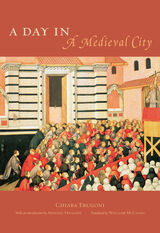 A Day in a Medieval City
Chiara Frugoni
University of Chicago Press, 2005 An opportunity to experience the daily hustle and bustle of life in the late Middle Ages, A Day in a Medieval City provides a captivating dawn-to-dark account of medieval life. A visual trek through the thirteenth and fourteenth centuries—with seasoned historian and expert on medieval iconography Chiara Frugoni as guide—this book offers a vast array of images and vignettes that depicts the everyday hardships and commonplace pleasures for people living in the Middle Ages. A Day in a Medieval City breathes life into the activities of the city streets, homes, fields, schools, and places of worship. With entertaining anecdotes and gritty details, it engages the modern reader with its discoveries of the religious, economic, and institutional practices of the day. From urban planning and education to child care, hygiene, and the more leisurely pursuits of games, food, books, and superstitions, Frugoni unearths the daily routines of the private and public lives of citizens. A Day in a Medieval City is a charming portal to the Middle Ages that you'll surely want with you on your travels to Europe—or in your armchair. “With its color illustrations of rare paintings and artifacts, this thoughtful and informative, elegantly fashioned excursion into the life of a medieval city is a veritable feast of information and visual delights. Frugoni is a marvelously experienced historical travel guide.”—Choice
“Stunningly beautiful . . . and a good read as well. . . . It’s amazing how much wealth of detail and image Ms. Frugoni has packed into this delightful, relatively small book.”—Steve Goode, Washington Times
“Charming and insightful. . . .Written with exceptional grace and infused with a warm sense of humanity.”—Library Journal
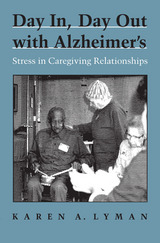 Day In Day Out Alzheimers
Karen Lyman
Temple University Press, 1993 "...an insightful and constructive view of persons with dementia and their caregivers."
--Carroll L. Estes, Institute for Health & Aging, University of California, San Francisco
Stress for care providers and distress for clients with varying degrees of dementia--these are the dynamics Karen A. Lyman discovered in her study of eight Alzheimer's day care centers in California. Speaking as an advocate for both day care providers and people with Alzheimer's disease, the author presents a model of "what works" in Alzheimer's care.
Many strategies developed by caregivers are self-defeating, Lyman found. Drawing on personal reflections, interviews, and anecdotes, she demonstrates how caregivers' struggle to maintain order through often unnecessary control contributed to patients' increased sense of self-doubt, anxiety, and incompetence. Negative expectations by caregivers brought on depression and rapid intellectual decline in patients, a "sense of hopelessness" that has been called "therapeutic nihilism."
Lyman identifies unsupportive institutional policies, restrictive environments, and poorly organized programs as chronic sources of stress. The alternatives she offers meet caregivers' needs and permit clients a degree of self-determination and identity. Her model for care will be of great interest to gerontological professionals, policy makers, and family members dealing with victims of Alzheimer's disease.
"[A]n insightful, comprehensive analysis of the unique reciprocal relationship between people with Alzheimer's disease and people who care for them. The author's compassionate concern emphasizes the need for innovative methods of care which alleviate stress for the care-giver and distress for the patients...an important book for policy makers, health care administrators, medical and nursing students, and all others who care."
--Maggie Kuhn, Founder and National Convener of the Gray Panthers
 A Day in "The Hole": Risk, Loss, and Excess in Downtown Lima
Daniella Gandolfo
University of Chicago Press A single day in a semilegal market in Lima, Peru, reveals a social world that defies conventional economic logic. In the heart of Lima’s historic center, the markets of El Hueco (“The Hole”) and sprawling Mesa Redonda pulse with life, with thousands of vendors selling everything from knockoff electronics to religious icons. In A Day in “The Hole,” anthropologist Daniella Gandolfo immerses readers in a single, tumultuous day—the thirty-fourth anniversary of a vendors’ cooperative—while examining the dynamics that sustain these marketplaces.
Through a blend of cinematic storytelling and incisive anthropological insight, Gandolfo reveals a world with its own unique codes. She inspects how vendors embrace expenditure over profit and instability over order, and moving through the sights and sounds of El Hueco and Mesa Redonda, she finds a dissident economy that is as much about survival as it is about spectacle. Gandolfo redefines how we think about urban economies and the unexpected ways these defiant communities thrive in this textured portrait of Lima’s markets and the people who animate them.
The Day is Ours!: An Inside View of the Battles of Trenton and Princeton, November 1776-January 1777
Dwyer, William M
Rutgers University Press, 1998 The Day is Ours! is a dramatic account of two battles that turned the tide of the American Revolution. In this distinguished, highly readable, and richly detailed narrative history, William M. Dwyer reveals as vivid a picture as we are likely to see of a critical period in the American Revolution. He lets the participants--from American, British, and Hessian soldiers to myriad fearful and ambivalent citizens--tell the story in their own words.
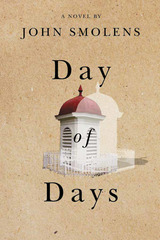 Day of Days
John Smolens
Michigan State University Press, 2020 In the spring of 1927, Andrew Kehoe, the treasurer for the school board in Bath, Michigan, spent weeks surreptitiously wiring the public school, as well as his farm, with hundreds of pounds of dynamite. The explosions on May 18, the day before graduation, killed and maimed dozens of children, as well as teachers, administrators, and village residents, including Kehoe’s wife, Nellie. A respected member of the community, Kehoe himself died when he ignited his truck, which he had loaded with crates of explosives and scrap metal. Decades later, one survivor, Beatrice Marie Turcott, recalls the spring of 1927 and how this haunting experience leads her to the conviction that one does not survive the present without reconciling hard truths about the past. In its portrayal of several Bath school children, Day of Days examines how such traumatic events scar one’s life long after the dead are laid to rest and physical wounds heal, and how an anguished but resilient American village copes with the bombing, which at the time seemed incomprehensible, and yet now may be considered a harbinger of the future.
 The Day of Shelly's Death: The Poetry and Ethnography of Grief
Renato Rosaldo
Duke University Press, 2014 This deeply moving collection of poetry by Renato Rosaldo focuses on the shock of his wife Michelle (Shelly) Rosaldo's sudden death on October 11, 1981. Just the day before, Shelly and her family had arrived in the northern Philippine village of Mungayang, where she and her husband Renato, both accomplished anthropologists, planned to conduct fieldwork. On October 11, Shelly died after losing her footing and falling some sixty feet from a cliff into a swollen river. Renato Rosaldo explored the relationship between bereavement and rage in his canonical essay, "Grief and a Headhunter's Rage," which first appeared in 1984 and is reprinted here. In the poems at the heart of this book, he returns to the trauma of Shelly's death through the medium of free verse, maintaining a tight focus on the events of October 11, 1981. He explores not only his own experience of Shelly's death but also the imagined perspectives of many others whose lives intersected with that tragic event and its immediate aftermath, from Shelly herself to the cliff from which she fell, from the two young boys who lost their mother to the strangers who carried and cared for them, from a tricycle taxi driver, to a soldier, to priests and nuns. Photographs taken years earlier, when Renato and Shelly were conducting research across the river valley from Mungayang, add a stark beauty. In a new essay, "Notes on Poetry and Ethnography," Rosaldo explains how and why he came to write the harrowing yet beautiful poems in The Day of Shelly's Death. More than anything else though, the essay is a manifesto in support of what he calls antropoesía, verse with an ethnographic sensibility. The essay clarifies how this book of rare humanity and insight challenges the limits of ethnography as it is usually practiced.
 The Day of the Cattleman
Ernest Staples Osgood
University of Minnesota Press, 1929
The Day of the Cattleman was first published in 1929. Minnesota Archive Editions uses digital technology to make long-unavailable books once again accessible, and are published unaltered from the original University of Minnesota Press editions.
The legend of the Wild West, as celebrated in thousands upon thousands of western stories and movies, radio and television programs, has a firm grip on the imaginations of both young and old, not only in America but in many other lands. But, popular though such versions are, they do not tell how the west was really won. Professor Osgood's account sets the record straight for those who want authentic history rather than melodramatic fiction.
"The range cattleman," Professor Osgood writes, "has more solid achievements to his credit than the creation of a legend. He was the first to utilize the semi-arid plains. Using the most available natural resources, the native grasses, as a basis, he built up a great and lucrative enterprise, attracted eastern and foreign capital to aid him in the development of a new economic area, stimulated railroad building in order that the product of the ranges might get to an eastern market, and laid the economic foundation of more than one western commonwealth."
Professor Osgood traces the rise and fall of the range cattle industry, particularly in Montana and Wyoming, from 1845 to the turn of the century. He gives a detailed account of the activities of the stock growers' associations and of the cattlemen's relations with the railroads and with the Federal government.
The book has won critical acclaim both in this country and abroad. The Saturday Review has described it as an "honest, scientific, and thorough examination" of a "semi-epic phase of Western life, now almost completely dead." In England, the Times Literary Supplement called it "the only substantial record of this particular chapter in the history of the West."
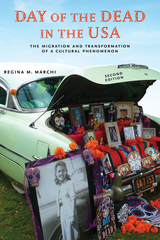 Day of the Dead in the USA, Second Edition: The Migration and Transformation of a Cultural Phenomenon
Regina M Marchi
Rutgers University Press, 2022 Honoring relatives by tending graves, building altars, and cooking festive meals has been a major tradition among Latin Americans for centuries. The tribute, "El Día de los Muertos," has enjoyed renewed popularity since the 1970s when Latinx activists and artists in the United States began expanding "Day of the Dead" north of the border with celebrations of performance art, Aztec danza, art exhibits, and other public expressions. Focusing on the power of public ritual to serve as a communication medium, this revised and updated edition combines a mix of ethnography, historical research, oral history, and critical cultural analysis to explore the manifold and unexpected transformations that occur when the tradition is embraced by the mainstream. A testament to the complex role of media and commercial forces in constructions of ethnic identity, Day of the Dead in the USA provides insight into the power of art and ritual to create community, transmit oppositional messages, and advance educational, political, and economic goals. Today Chicano-style Day of the Dead events take place in all fifty states. This revised edition provides new information about: - The increase in events across the US, incorporating media coverage and financial aspects,
- Recent political movements expressed in contemporary Day of the Dead celebrations, including #BlackLivesMatter and #MeToo
- Greater media coverage and online presence of the celebration in blogs, websites, and streaming video
- Día de los Muertos themes and iconography in video games and films
- The proliferation of commercialized merchandise such as home goods, apparel, face paints and jewelry at mainstream big box and web retailers, as well as the widespread proliferation of calavera-themed decorations and costumes for Halloween
- 24 new full color illustrations
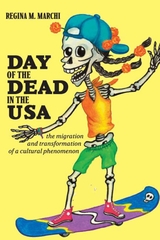 Day of the Dead in the USA: The Migration and Transformation of a Cultural Phenomenon
Marchi, Regina M
Rutgers University Press, 2009
Honoring relatives by tending graves, building altars, and cooking festive meals has been an honored tradition among Latin Americans for centuries. The tribute, "el Dia de los Muertos," has enjoyed renewed popularity since the 1970s when Latino activists and artists in the United States began expanding "Day of the Dead" north of the border with celebrations of performance art, Aztec danza, art exhibits, and other public expressions.
Focusing on the power of ritual to serve as a communication medium, Regina M. Marchi combines a mix of ethnography, historical research, oral history, and critical cultural analysis to explore the manifold and unexpected transformations that occur when the tradition is embraced by the mainstream. A testament to the complex nature of ethnic identity, Day of the Dead in the USA provides insight into the power of ritual to create community, transmit oppositional messages, and advance educational, political, and economic goals.
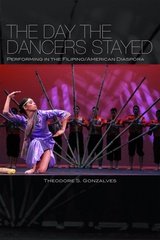 The Day the Dancers Stayed: Performing in the Filipino/American Diaspora
Theodore S. Gonzalves
Temple University Press, 2009 Pilipino Cultural Nights at American campuses have been a rite of passage for youth culture and a source of local community pride since the 1980s. Through performances—and parodies of them—these celebrations of national identity through music, dance, and theatrical narratives reemphasize what it means to be Filipino American. In The Day the Dancers Stayed, scholar and performer Theodore Gonzalves uses interviews and participant observer techniques to consider the relationship between the invention of performance repertoire and the development of diasporic identification. Gonzalves traces a genealogy of performance repertoire from the 1930s to the present. Culture nights serve several functions: as exercises in nostalgia, celebrations of rigid community entertainment, and occasionally forums for political intervention. Taking up more recent parodies of Pilipino Cultural Nights, Gonzalves discusses how the rebellious spirit that enlivened the original seditious performances has been stifled.
 The Day They Hanged Old Brown: The Making of Celebrity and Martyrdom in the Civil War Era
John R. Van Atta
University of Missouri Press, 2025 Abolitionist, fanatic, terrorist, freedom fighter, alleged murderer—all of those labels fit John Brown. Yet he also qualified as a mid-nineteenth-century celebrity. Reserved only for a few, celebrity in Brown’s time was, in historian Carolyn Eastman’s words, a quality “of being well known, an attribute, a degree of popularity and fame—the state of being celebrated by others,” as Brown certainly was.
Brown’s lifespan covered most of the period between the Revolution and the Civil War, a time of the still-early beginnings of the United States. Only then had his kind of “celebrity” started to matter. From different economic and moral perspectives, politically aware Americans clashed over different visions for the future of the country. At that time, any disruptive figure might be taken as a barometer of the progress or the decline of the republic. A function of the widely varying newspapers and magazines of that day, celebrity offered Americans an angle of vision, happily or not, as to who they were or were becoming or believed themselves to be—as if by a mirror reflection.
In The Day They Hanged Old Brown, John Van Atta examines the creation of celebrity in John Brown’s time and how it differed from modern day perceptions. Yet, as applicable as the concept of celebrity is in this case, the story of Brown’s notoriety represents far more. To his admirers, Brown was not merely a celebrity; he was a hero and, after his sacrificial death, a martyr. Not all celebrities rise to such levels. This book traces the meaning of heroism and martyrdom—as well as the opposite side of that coin, villainy—and suggests that John Brown’s story and legacy helped to redefine these concepts for many Americans during the era of the Civil War, before modern historians began to deliberate him.
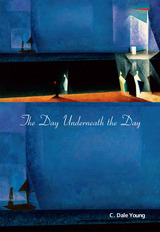 The Day Underneath the Day
C. Dale Young
Northwestern University Press, 2001 Winner of 2002 Norma Farber First Book Award Finalist
Gifted with a vivid and exact skill, C. Dale Young's writing resembles an intricate anatomy lesson. His powers of observation probe the small energies of the natural world. Again and again the ordinary details of life transform themselves under the delicate pressure of his words--the movement of birds' wings, the color and texture of tropical flowers, the study of the ocean waves, the "scalpel of light" cutting through the beginning of the day. The language of Young's poems evokes an ultimate sense of place through a gorgeous marriage of tone and diction that echoes James Merrill and Amy Clampitt. As he meticulously maps out human passions and emotions, he explores both the surfaces and depths of everything that he surveys. His confident and polished verse unfolds intricate layers of landscape, seeking the order that lies beneath the unruly patterns of our lives.
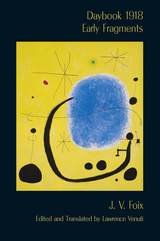 Daybook 1918: Early Fragments
J. V. Foix, Edited and translated by Lawrence Venuti
Northwestern University Press, 2019 Daybook 1918: Early Fragments is the first substantial selection in English from the prose poetry of the major Catalan writer J. V. Foix. The core of Lawrence Venuti’s edition is forty-five prose poems from the beginning of Foix’s career, supplemented by additional poems in prose and verse, prose fictions, and essays that immerse the reader in the heady cultural ferment of early twentieth-century Catalonia.
Deeply committed to the European avant-gardes, Foix explored experimental poetics in the service of Catalan nationalism as Catalonia itself carried out its notable experiments with autonomous government on the eve of Franco’s dictatorship. Foix was particularly attracted to the revolutionary energy of French surrealism, and he endows Catalan life and landscapes with a dreamlike quality while staging a series of unsettling encounters with the femme fatale Gertrudis.
In translations praised as both fluid and resonant, Venuti plumbs the expressive capabilities of English to evoke the profound impact that the Catalan texts had on their first readers. Daybook 1918: Early Fragments establishes Foix as a key figure in international modernism.
 Daybreak Birdsong Always Wakes Him: The Lives of Billy the Kid
Pamela Ryder
University of Alabama Press, 2026 A haunting reimagining of Billy the Kid—myth, violence, and regret collide in a lyrical coming-of-age story woven with history, legend, and the omnipresence of birds. Daybreak Birdsong Always Wakes Him: The Lives of Billy the Kid by Pamela Ryder is a coming-of-age saga like no other. It reaches beyond the myth of the reckless and romantic rebel, the murdering gunslinger, and the scrappy outlaw. His story is one of survival, mayhem, and regret. Billy is portrayed as a complex and authentic figure. At times he is ruthless, often sympathetic, always clever and engaging. Yet he remains haunted by loneliness as he rides ever closer to the end of his short and violent life. The child of Irish immigrants, Billy came of age amid hardship and lawlessness, forced to navigate a world that offered him little mercy. From his grim childhood in the tenements of New York to the unforgiving deserts of New Mexico, his journey is marked by loss, chaos, and fleeting moments of grace. He was a boy who became an outlaw, forever running from his past toward an inevitable fate. Told through shifting perspectives and enriched by Billy’s keen observations of birds, landscapes, and the lives he has taken, the novel unfolds in lyrical, unflinching prose. His fascination with birds, whose freedom stands in stark contrast to his own doomed flight, threads through the narrative. A meditation on myth, mortality, and the stories we tell about ourselves, Daybreak Birdsong Always Wakes Him is a singular reimagining of the American West. It does not flinch from the blood or the beauty of a life lived on the edge of history.
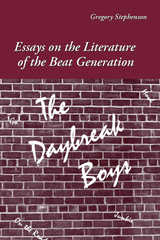 The Daybreak Boys: Essays on the Literature of the Beat Generation
Gregory Stephenson
Southern Illinois University Press, 1990 In these critical essays Gregory Stephenson takes the reader on a journey through the literature of the Beat Generation: a journey encompassing that common ethos of Beat literature—the passage from darkness to light, from fragmented being toward wholeness, from Beat to Beatific. He travels through Jack Kerouac’s Duluoz Legend,following Kerouac’s quests for identity, community, and spiritual knowledge. He examines Allen Ginsberg’s use of transcendence in “Howl,” discovers the Gnostic vision in William S. Burroughs’s fiction, and studies the mythic, visionary power of Lawrence Ferlinghetti’s poetry. Stephenson also provides detailed examinations of the writing of lesser-known Beat authors: John Clellon Holmes, Gregory Corso, Richard Fariña, and Michael McClure. He explores the myth and the mystery of the literary legend of Neal Cassady. The book concludes with a look at the common traits of the Beat writers—their use of primitivism, shamanism, myth and magic, spontaneity, and improvisation, all of which led them to a new idiom of consciousness and to the expansion of the parameters of American literature.
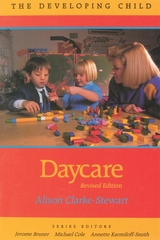 Daycare: Revised Edition
Alison Clarke-Stewart
Harvard University Press, 1993 There are eight million preschoolers whose mothers now work, most of them because of economic necessity. For these mothers the question is not whether to use daycare, but how to choose among the available options in a way that is best for the child. These are just the questions taken up in Daycare, a brief and readable summary of the best information modern “baby science” has to offer about how daycare affects young children and how to tell the difference between daycare that helps and daycare that hurts.
On the basis of her own research and a complete review of the most recent daycare studies, Alison Clarke-Stewart concludes that good daycare definitely does not impair the child's development either emotionally or intellectually. Fears that daycare children will fail to develop proper parental attachments and will cling instead to their peers are unfounded; so too are fears that mental growth will be slowed. In fact, there is some evidence that social and intellectual development can be facilitated in good daycare environments. The real question is just what these environments are made of, and here Daycare provides a complete discussion of the necessary ingredients, including a checklist that parents can use to make their own evaluation of any daycare arrangement.
This is a book that covers all the practical problems daycare parents must face and suggests ways to solve them that are based not on psychological theory or political conviction but on the facts as we now know them.
 Daydreamers: A Novel
Alvin Lu
University of Alabama Press, 2025 A fragmented manuscript left unfinished, a voice inherited by time, a ghost lingering in the margins—Daydreamers is what remains when fiction forgets its fiction and when the story you’re translating becomes your own. Upon the discovery of an unfinished manuscript left behind by his late father, a son’s act of literary translation quickly descends into a ghost story of family rumors, art, and the history we inherit, whether we want them or not. As the son translates the mysterious text, what emerges is a narrative haunted by betrayal, artistic rivalry, and a murder in California’s Chinese literary underground—one that was never solved but perhaps was fictionalized. Cycling between San Francisco, Los Angeles, China, and Taiwan, the novel unfolds across generations of Chinese immigrants and diaspora artists, linked by tenuous friendships, publishing feuds, and the obscure threads of an act of violence. At the center: a spectral woman named Lena Wu, the object of literary fixation, political allegory, and real-life scandal. Was the manuscript meant as a novel or a confession? Was the story’s central figure—Lena Wu—a real person or an idea and persona passed between generations of writers, each shaping her into their own myth? And what is the narrator’s responsibility when his father’s version of events begins to implicate those still living? Told through letters, interviews, travelogues, and unclaimed fragments, Daydreamers moves through foggy cities, cluttered studios, desert highways, and vanished publishing circles—where stories are currency and silence is survival. Lu constructs a novel that is both noir and anti-noir, both memoir and anti-memoir—a mystery that resists solving, and a translation that becomes its own original work.
 The Daykeeper: The Life and Discourse of an Ixil Diviner
Benjamin N. Colby and Lore M. Colby
Harvard University Press, 1981 The Daykeeper presents a unique view, of the life of a modern Mayan holy man--his religious beliefs and practices, his stories and folktales, his philosophy of living, his struggle for daily bread and peace of mind.
In the hands of Benjamin and Lore Colby; the daykeeper's testimony be comes an important vehicle for understanding a culture that is a direct descendant of the high Mayan civilization of the past.
The Colbys show that there are intelligible cultural principles that organize the daykeeper's methods of divination and guide his interpretation of dreams and his cures for the sick. There is also a clear cultural pattern underlying the stores he telIs and the morals that he draws from them. When these patterns are used to inform our perception of the daykeeper's experience of life, we gain a rich, understanding of the relation between culture and thought as well as a rare and privileged insight into the mind of a highly religious man.The Daykeeper is an unusual combination of compelling life history and sophisticated cultural analysis. This is a benchmark book in American anthropology that can be read with understanding and enjoyment by expert and layman alike.
Days and Memory
Charlotte Delbo
Northwestern University Press, 2001 In Auschwitz, memory meant life: remembering the humanity extinguished by the death camps and hoping to survive to tell what had been endured. Charlotte Delbo, a non-Jew sent to Auschwitz for being a member of the French resistance movement, recalls the poems, vignettes, and meditations that fed her companions' spirits, interweaving her experiences with the sufferings of others and depicting dignity and decency in the face of inhumanity.
This definitive translation is by Delbo's close friend, the author and theater critic Rosette Lamont, an expert on the works of Ionesco and Beckett. Lamont wrote that Delbo was, like Beckett, "a minimalist of infinite pain, a voice of conscience."
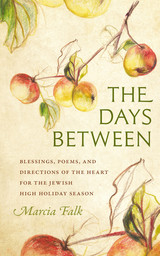 The Days Between: Blessings, Poems, and Directions of the Heart for the Jewish High Holiday Season
Marcia Falk
Brandeis University Press, 2014 The Jewish High Holidays—the ten days beginning with the New Year Festival of Rosh Hashanah and culminating with Yom Kippur, the Day of Atonement—constitute the most sacred period of the Jewish year. During this season, religious as well as nonaffiliated Jews attend synagogue services in unparalleled numbers. Yet much of what they find there can be unwelcoming in its patriarchal imagery, leaving many worshipers unsatisfied. For those seeking to connect more deeply with their Judaism, and for all readers in search of a contemplative approach to the themes of the fall season, poet and scholar Marcia Falk re-creates the holidays’ key prayers and rituals from an inclusive perspective. Among the offerings in The Days Between are Hebrew and English blessings for festive meals, prayers for synagogue services, and poems and meditations for quiet reflection. Emphasizing introspection as well as relationship to others, Falk evokes her vision of the High Holidays as “ten days of striving to keep the heart open to change.” Accessible and welcoming to modern readers, The Days Between is steeped in traditional sources and grounded in liturgical and biblical scholarship. It will serve as a meaningful alternative or supplement to the traditional liturgy for individuals, families, synagogues, and communities small and large—that is, for all who seek fresh meaning in the High Holidays.
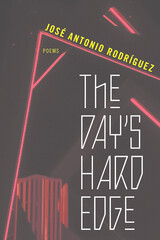 The Day's Hard Edge: Poems
Jose A. Rodriguez
Northwestern University Press, 2024 A radically open interrogation of queer Chicano identity
In his fourth poetry collection, José Antonio Rodríguez investigates how one constructs a relationship to the self, to community, and to poetry itself. The Day's Hard Edge is composed of three sections, the first of which situates the reader in the speaker’s world, one marked by multiple forms of trauma. Here are the contours of the Texas/Mexico borderlands where the speaker’s initial sense of self and community emerges. The second section broadens in scope and considers the potential and limitations of poetry as a site for meaning-making. The third section brings the speaker to a new understanding of the poem as it relates to the transformative and destabilizing experience of trauma. Ultimately this book lays bare an individual and, in doing so, shows how poetry acts as a place of succor and vulnerability for one’s very identity. Together these poems explore what it means to be queer, immigrant, and Chicano.
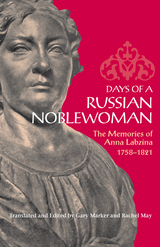 Days of a Russian Noblewoman: The Memories of Anna Labzina, 1758-1821
Anna Labzina
Northern Illinois University Press, 2001
Providing a unique glimpse into the domestic life of Russia's nobility in the late eighteenth and early nineteenth centuries, Days of a Russian Noblewoman combines a rare memoir and a diary, now translated into English for the first time. Anna Labzina was relatively well educated by the standards of her day, and she traveled widely through the Russian empire. Yet, unlike most writers of her time, she writes primarily as a dutiful, if inwardly rebellious, daughter and wife, reflecting on the onerous roles assigned to women in a male-centered society.
Labzina was married young to Alexander Karamyshev, who, while well regarded in political and scholarly circles of his day, proved to be brutish and abusive at home. A "Russian Voltairian," he professed atheism and free love. His unbridled behavior caused Labzina much grief, which she vividly recalls in her memoir. Because she moved among aristocratic circles, her reminiscences bring readers face to face with celebrated figures of politics and literature, including the Empress Catherine the Great and the "Radiant Prince" Grigorii Potemkin. As a pious and charitable woman, Labzina also speaks for others who rarely had a voice in literature: serfs, prisoners, and political exiles.
Labzina wrote both her memoir and her diary during her second marriage, to Alexander Labzin, a leader in Russian Freemasonry and in the movement for religious revival. At the same time, she became actively involved in the spiritual life of his lodge, the Dying Sphinx. Her account of her spiritual development and her social sphere offer unparalleled insights into male and female sensibilities of the time.
 Days of Awe: Reimagining Jewishness in Solidarity with Palestinians
Atalia Omer
University of Chicago Press, 2019 For many Jewish people in the mid-twentieth century, Zionism was an unquestionable tenet of what it meant to be Jewish. Seventy years later, a growing number of American Jews are instead expressing solidarity with Palestinians, questioning old allegiances to Israel. How did that transformation come about? What does it mean for the future of Judaism?
In Days of Awe, Atalia Omer examines this shift through interviews with a new generation of Jewish activists, rigorous data analysis, and fieldwork within a progressive synagogue community. She highlights people politically inspired by social justice campaigns including the Black Lives Matter movement and protests against anti-immigration policies. These activists, she shows, discover that their ethical outrage at US policies extends to Israel’s treatment of Palestinians. For these American Jews, the Jewish history of dispossession and diaspora compels a search for solidarity with liberation movements. This shift produces innovations within Jewish tradition, including multi-racial and intersectional conceptions of Jewishness and movements to reclaim prophetic Judaism. Charting the rise of such religious innovation, Omer points toward the possible futures of post-Zionist Judaism.
Days of Our Lives
Joan Aleshire
Four Way Books, 2019 Day of Our Lives is equal parts social history and memoir documenting the unraveling of a marriage against the backdrop of the shifting social mores of 1960s and ’70s America. Joan Aleshire’s speaker, a young wife, enters marriage gratefully, even eagerly, believing it to be “a long table / with friends crowding in, red wine / in tumblers.” Motherhood follows, but so do infidelities and reconciliation and ultimately divorce. With each hard knock, the speaker sheds a little more of her innocence as she gains awareness of her power as both a woman and a writer: “Coming home / late from a festival for women / where I’d said all the things / the audience liked, I slipped / into bed so flush with triumph / my husband recoiled from the heat.”
Days of Plenty, Days of Want
Patricia Preciado Martin
University of Arizona Press, 1999 For Patricia Preciado Martin, the past is every bit as real as the present. In Days of Plenty, Days of Want, past and present meet in a collection of strikingly crafted short stories that show us a heritage being irreverently pushed aside by "progress" yet passed along from person to person, century to century.
In the pages of this book are people so real you'll swear you've met them, situations so familiar you'll nod in recognition. Two of these stories have won prizes in Chicano literary contests; all will win the hearts of readers. Through them, Patricia Preciado Martin reminds us that freedom and self-expression are important in fulfilling our potential—and, more important, that a large part of this process requires acknowledging our heritage as a priceless gift whose relevance in our lives cannot be ignored.
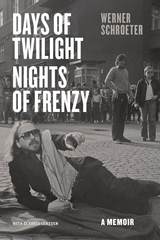 Days of Twilight, Nights of Frenzy: A Memoir
Werner Schroeter and Claudia Lenssen
University of Chicago Press, 2017 Werner Schroeter was a leading figure of New German Cinema. In more than forty films made between 1967 and 2008, including features, documentaries, and shorts, he ignored conventional narrative, creating instead dense, evocative collages of image and sound. For years, his work was eclipsed by contemporaries such as Wim Wenders, Rainer Werner Fassbinder, Werner Herzog, and Alexander Kluge. Yet his work has become known to a wider audience through several recent retrospectives, including at the Museum of Modern Art, New York.
Written in the last years of his life, Days of Twilight, Nights of Frenzy sees Schroeter looking back at his life with the help of film critic and friend Claudia Lenssen. Born in 1945, Schroeter grew up near Heidelberg and spent just a few weeks in film school before leaving to create his earliest works. Over the years, he would work with acclaimed artists, including Marianne Hopps, Isabelle Huppert, Candy Darling, and Christine Kaufmann. In the 1970s, Schroeter also embarked on prolific parallel careers in theater and opera, where he worked in close collaboration with the legendary diva Maria Callas. His childhood; his travels in Italy, France, and Latin America; his coming out and subsequent life as an gay man in Europe; and his run-ins with Hollywood are but a few of the subjects Schroeter recalls with insights and characteristic understated humor.
A sharp, lively, even funny memoir, Days of Twilight, Nights of Frenzy captures Schroeter’s extravagant life vividly over a vast prolific career, including many stories that might have been lost were it not for this book. It is sure to fascinate cinephiles and anyone interested in the culture around film and the arts.
Days on Earth: The Dance of Doris Humphrey
Marcia B. Siegel
Duke University Press, 1993 Now available in paperback, Days on Earth--originally published in 1988 (Yale University Press)--traces the dance career and artistic development of one of the founders of American modern dance. In this biography of dance pioneer Doris Humphrey, Marcia B. Siegel follows Humphrey's career from her days with the Denishawn Company (among fellos students like Martha Graham) to her creative partnership with Charles Weidman to her tenure as artistic director of protégé José Limon's dance company. Siegel's reconsideration and description of Humphrey's dances, including many that are no longer performed, sheds important light on this pathbreaking dancer/choreographer.
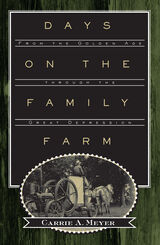 Days on the Family Farm: From the Golden Age through the Great Depression
Carrie A. Meyer
University of Minnesota Press, 2007 From the beginning of the twentieth century to World War II, farm wife May Lyford Davis kept a daily chronicle that today offers a window into a way of life that has all but disappeared. May and her husband Elmo lived through two decades of prosperity, the Great Depression, and two World Wars in their Midwestern farming community. Like many women of her time, Davis kept diaries that captured the everyday events of the family farm; she also kept meticulous farming accounts. In doing so, she left an extraordinary record that reflects not only her own experiences but also the history of early twentieth-century American agriculture. May and Elmo’s story, engagingly told by Carrie A. Meyer, showcases the large-scale evolution of agriculture from horses to automobile and tractors, a surprisingly vibrant family and community life, and the business of commercial farming. Details such as what items were bought and sold, what was planted and harvested, the temperature and rainfall, births and deaths, and the direction of the wind are gathered to reveal a rich picture of a world shared by many small farmers. With sustainable and small-scale farming again on the rise in the United States, Days on the Family Farm resonates with both the profound and mundane aspects of rural life—past and present—in the Midwest. Carrie A. Meyer is associate professor of economics at George Mason University.
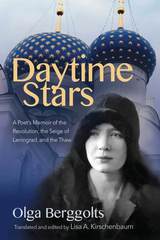 Daytime Stars
Olga Berggolts, translated by Lisa Kirschenbaum
University of Wisconsin Press, 2018 For 872 days during World War II, the city of Leningrad endured a crushing blockade at the hands of German forces. Close to one million civilians died, most from starvation. Amid the devastation, Olga Berggolts broadcast her poems on the one remaining radio station, urging listeners not to lose hope. When the siege had begun, the country had already endured decades of revolution, civil war, economic collapse, and Stalin's purges. Berggolts herself survived the deaths of two husbands and both of her children, her own arrest, and a stillborn birth after being beaten under interrogation.
Berggolts wrote her memoir Daytime Stars in the spirit of the thaw after Stalin's death. In it, she celebrated the ideals of the revolution and the heroism of the Soviet people while also criticizing censorship of writers and recording her doubts and despair. This English translation by Lisa A. Kirschenbaum makes available a unique autobiographical work by an important author of the Soviet era. In her foreword, Katharine Hodgson comments on experiences of the Terror about which Berggolts was unable or unwilling to write.
Daytime Television Gameshows and the Celebration of Merchandise: The Price Is Right
Morris B. Holbrook
University of Wisconsin Press, 1993 A neglected genre that promises to shed light on the culture of consumption appears in the form of the daytime television game shows whose hegemonic message seems to convey and to justify a widespread obeisance to the mandate of materialism. A close analysis of the longest running game show, The Price Is Right, suggests that all facets of this program combine to reinforce its central meaning as a ritualistic validation of consumption-oriented greed.
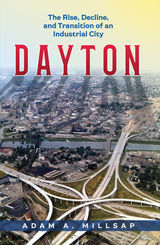 Dayton: The Rise, Decline, and Transition of an Industrial City
Adam A. Millsap
Ohio State University Press, 2019 The Rust Belt was once the crown of American manufacturing, a symbol of the country’s economic prowess. But now it is named for what it has become: a deteriorating stretch of industrial cities left behind by a post-industrial world. In Dayton: The Rise, Decline, and Transition of an Industrial City, Adam A. Millsap turns his focus to his hometown, an archetypal Rust Belt city, to examine its history and discuss its future.
Thoroughly researched and engagingly written, Millsap’s book explores the economic background of the region made famous by J. D. Vance’s Hillbilly Elegy. From early twentieth-century optimism, through the Great Depression and post-WWII manufacturing decline, to Dayton now, with its labor-force problems and opioid crisis, Millsap tracks the underlying forces driving the city’s trajectory. Race relations, interstates, suburbanization, climate, crime, geography, and government policies all come into play as Millsap develops a picture of the city, past and present. By examining the past, Millsap proposes a plan for the future, claiming that there is hope for Dayton to thrive again. And if Dayton can rise from its industrial ashes, then perhaps the Rust Belt can shed its stigma and once again become the backbone of American innovation.
DC Distribution Systems and Microgrids
Tomislav Dragičević
The Institution of Engineering and Technology, 2018 DC electric power distribution systems have higher efficiency, better current carrying capacity and faster response when compared to conventional AC systems. They also provide a more natural interface with many types of renewable energy sources. Furthermore, there are fewer issues with reactive power flow, power quality and frequency regulation, resulting in a notably less complex control system. All these facts lead to increased applications of DC systems in modern power systems. Still, design and operation of these systems imposes a number of specific challenges, mostly related to lack of mature protection technology and operational experience, as well as very early development stage of standards regarding DC based power infrastructure.
 DC Jazz: Stories of Jazz Music in Washington, DC
Maurice Jackson and Blair A. Ruble, Editors
Georgetown University Press, 2018 The familiar history of jazz music in the United States begins with its birth in New Orleans, moves upstream along the Mississippi River to Chicago, then by rail into New York before exploding across the globe. That telling of history, however, overlooks the pivotal role the nation's capital has played for jazz for a century. Some of the most important clubs in the jazz world have opened and closed their doors in Washington, DC, some of its greatest players and promoters were born there and continue to reside in the area, and some of the institutions so critical to national support of this uniquely American form of music, including Congress, the Smithsonian Institution, the Kennedy Center, the Library of Congress and the Historical Society of Washington, D.C., are rooted in the city. Closer to the ground, a network of local schools like the Duke Ellington High School for the Performing Arts, jazz programs at the University of the District of Columbia and Howard University, churches, informal associations, locally focused media, and clubs keeps the music alive to this day. Noted historians Maurice Jackson and Blair Ruble, editors of this book, present a collection of original and fascinating stories about the DC jazz scene throughout its history, including a portrait of the cultural hotbed of Seventh and U Streets, the role of jazz in desegregating the city, a portrait of the great Edward "Duke" Ellington’s time in DC, notable women in DC jazz, and the seminal contributions of the University of District of Columbia and Howard University to the scene. The book also includes three jazz poems by celebrated Washington, DC, poet E. Ethelbert Miller. Collectively, these stories and poems underscore the deep connection between creativity and place. A copublishing initiative with the Historical Society of Washington, DC, the book includes over thirty museum-quality photographs and a guide to resources for learning more about DC jazz.
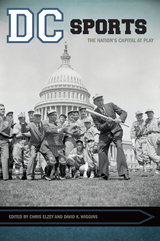 DC Sports: The Nation's Capital at Play
Chris Elzey
University of Arkansas Press, 2015 Washington, DC, is best known for its politics and monuments, but sport has always been an integral part of the city, and Washingtonians are among the country’s most avid sports fans. DC Sports gathers seventeen essays examining the history of sport in the nation’s capital, from turn-of-the-century venues such as the White Lot, Griffith Stadium, and DC Memorial Stadium to Howard-Lincoln Thanksgiving Day football games of the roaring twenties; from the surprising season of the 1969 Washington Senators to the success of Georgetown basketball during the 1980s. This collection covers the field, including public recreation, high-school athletics, intercollegiate athletics, professional sports, sports journalism, and sports promotion.
A southern city at heart, Washington drew a strong color line in every facet of people’s lives. Race informed how sport was played, written about, and watched in the city. In 1962, the Redskins became the final National Football League team to integrate. That same year, a race riot marred the city’s high-school championship game in football. A generation later, race as an issue resurfaced after Georgetown’s African American head coach John Thompson Jr. led the Hoyas to national prominence in basketball.
DC Sports takes a hard look at how sports in one city has shaped culture and history, and how culture and history inform sports. This informative and engaging collection will appeal to fans and students of sports and those interested in the rich history of the nation’s capital.
 D-Day Remembered: The Normandy Landings in American Collective Memory
Michael Dolski
University of Tennessee Press, 2016 D-Day, the Allied invasion of northwestern France in June 1944, has remained in the forefront of American memories of the Second World War to this day. Depictions in books, news stories, documentaries, museums, monuments, memorial celebrations, speeches, games, and Hollywood spectaculars have overwhelmingly romanticized the assault as an event in which citizen-soldiers—the everyday heroes of democracy—engaged evil foes in a decisive clash fought for liberty, national redemption, and world salvation. In D-Day Remembered, Michael R. Dolski explores the evolution of American D-Day tales over the course of the past seven decades. He shows the ways in which that particular episode came to overshadow so many others in portraying the twentieth century’s most devastating cataclysm as “the Good War.” With depth and insight, he analyzes how depictions in various media, such as the popular histories of Stephen Ambrose and films like The Longest Day and Saving Private Ryan, have time and again reaffirmed cherished American notions of democracy, fair play, moral order, and the militant, yet non-militaristic, use of power for divinely sanctioned purposes. Only during the Vietnam era, when Americans had to confront an especially stark challenge to their pietistic sense of nationhood, did memories of D-Day momentarily fade. They soon reemerged, however, as the country sought to move beyond the lamentable conflict in Southeast Asia. Even as portrayals of D-Day have gone from sanitized early versions to more realistic acknowledgments of tactical mistakes and the horrific costs of the battle, the overarching story continues to be, for many, a powerful reminder of moral rectitude, military skill, and world mission. While the time to historicize this morality tale more fully and honestly has long since come, Dolski observes, the lingering positive connotations of D-Day indicate that the story is not yet finished.
D-Day Through French Eyes: Normandy 1944
Mary Louise Roberts
University of Chicago Press, 2014 A gripping account of what it was like to be in the midst of the Norman Invasion on D-Day and immediately afterward.
Silent parachutes dotting the night sky—that’s how one woman in Normandy in June 1944 learned that the D-Day invasion was underway. Though they yearned for liberation, the people of Normandy steeled themselves for further warfare, knowing that their homes, land, and fellow citizens would have to bear the brunt of the attack. In D-Day through French Eyes, Mary Louise Roberts resets our view of the usual stories of that momentous operation, taking readers across the Channel to view the invasion anew. Roberts builds her history from an impressive range of gripping first-person accounts from French citizens, reinvigorating a story we thought we knew. The result is a fresh perspective on the heroism, sacrifice, and achievement of D-Day.
De Administrando Imperio
Gyula Moravcsik
Harvard University Press, 1967 This is a reprint of the second revised edition of the text and translation of the De Administrando Imperio written and compiled by Emperor Constantine VII Porphyrogenitus in the tenth century. It contains a wide variety of information on both foreign relations and internal administration and is one of the most important historical documents surviving from the Middle Byzantine period. Its confidential character and generally honest appraisal of the empire’s political situation enhance its value for students of Byzantium and Europe during this period. The edition includes general and critical introductions, an index of proper names, and an extensive glossary, as well as grammatical notes and an index of sources and parallel passages.
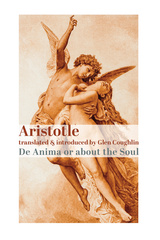 De Anima, or About the Soul
Aristotle
St. Augustine's Press, 2021 The De Anima (On the Soul) is the first and most general of Aristotle’s biological works and as such is the most important work in the study of nature after the Physics of Aristotle. It is presupposed to Aristotle’s Sense and the Sensible, Memory and Reminiscence, and his many other biological works.
In this text, Aristotle discusses his predecessors’ views of life, defines the principle of life (“soul”), discusses the principle sorts of living things (plants, animals, and human beings), and analyzes the chief activities of each sort of life. In the case of rational life, he shows that the ability to think implies an immaterial aspect to the human soul.
The De Anima is necessary not only to the study of biology, but also advances the understanding of metaphysics, of ethics and of politics, and even of logic, insofar as logic directs the acts of the human mind.
Like Coughlin’s translation of Aristotle’s Physics (also published by St. Augustine Press), this translation attempts to be literal and concrete. The edition includes the translation, introduction, glossary, index, and explanatory notes.
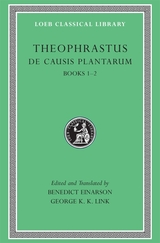 De Causis Plantarum, Volume I: Books 1–2
Theophrastus
Harvard University Press, 1976 The first fruits of Greek botany.
Theophrastus of Eresus in Lesbos, born about 370 BC, is the author of the most important botanical works that have survived from classical antiquity. He was in turn student, collaborator, and successor of Aristotle. Like his predecessor he was interested in all aspects of human knowledge and experience, especially natural science. His writings on plants form a counterpart to Aristotle’s zoological works.
In the Enquiry into Plants Theophrastus classifies and describes varieties—covering trees, plants of particular regions, shrubs, herbaceous plants, and cereals; in the last of the nine books he focuses on plant juices and medicinal properties of herbs. This edition is in two volumes; the second contains two additional treatises, On Odours and Weather Signs.
In De causis plantarum Theophrastus turns to plant physiology. Books 1 and 2 are concerned with generation, sprouting, flowering and fruiting, and the effects of climate. In Books 3 and 4 Theophrastus studies cultivation and agricultural methods. In Books 5 and 6 he discusses plant breeding; diseases and other causes of death; and distinctive flavors and odors. The Loeb Classical Library edition is in three volumes.
Theophrastus’ celebrated Characters is of a quite different nature. This collection of descriptive sketches is the earliest known character-writing and a striking reflection of contemporary life.
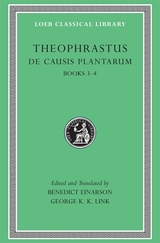 De Causis Plantarum, Volume II: Books 3–4
Theophrastus
Harvard University Press, 1976 The first fruits of Greek botany.
Theophrastus of Eresus in Lesbos, born about 370 BC, is the author of the most important botanical works that have survived from classical antiquity. He was in turn student, collaborator, and successor of Aristotle. Like his predecessor he was interested in all aspects of human knowledge and experience, especially natural science. His writings on plants form a counterpart to Aristotle’s zoological works.
In the Enquiry into Plants Theophrastus classifies and describes varieties—covering trees, plants of particular regions, shrubs, herbaceous plants, and cereals; in the last of the nine books he focuses on plant juices and medicinal properties of herbs. This edition is in two volumes; the second contains two additional treatises, On Odours and Weather Signs.
In De causis plantarum Theophrastus turns to plant physiology. Books 1 and 2 are concerned with generation, sprouting, flowering and fruiting, and the effects of climate. In Books 3 and 4 Theophrastus studies cultivation and agricultural methods. In Books 5 and 6 he discusses plant breeding; diseases and other causes of death; and distinctive flavors and odors. The Loeb Classical Library edition is in three volumes.
Theophrastus’ celebrated Characters is of a quite different nature. This collection of descriptive sketches is the earliest known character-writing and a striking reflection of contemporary life.
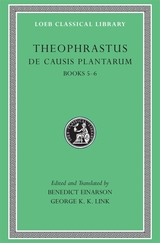 De Causis Plantarum, Volume III: Books 5–6
Theophrastus
Harvard University Press, 1976 The first fruits of Greek botany.
Theophrastus of Eresus in Lesbos, born about 370 BC, is the author of the most important botanical works that have survived from classical antiquity. He was in turn student, collaborator, and successor of Aristotle. Like his predecessor he was interested in all aspects of human knowledge and experience, especially natural science. His writings on plants form a counterpart to Aristotle’s zoological works.
In the Enquiry into Plants Theophrastus classifies and describes varieties—covering trees, plants of particular regions, shrubs, herbaceous plants, and cereals; in the last of the nine books he focuses on plant juices and medicinal properties of herbs. This edition is in two volumes; the second contains two additional treatises, On Odours and Weather Signs.
In De causis plantarum Theophrastus turns to plant physiology. Books 1 and 2 are concerned with generation, sprouting, flowering and fruiting, and the effects of climate. In Books 3 and 4 Theophrastus studies cultivation and agricultural methods. In Books 5 and 6 he discusses plant breeding; diseases and other causes of death; and distinctive flavors and odors. The Loeb Classical Library edition is in three volumes.
Theophrastus’ celebrated Characters is of a quite different nature. This collection of descriptive sketches is the earliest known character-writing and a striking reflection of contemporary life.
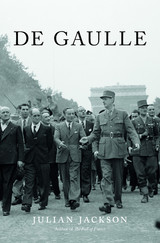 De Gaulle
Julian Jackson
Harvard University Press, 2018 Winner of the Duff Cooper Prize
Winner of the Elizabeth Longford Prize
A New Yorker, Financial Times, Spectator, Times, and Telegraph Book of the Year
In this definitive biography of the mythic general who refused to accept the Nazi domination of France, Julian Jackson captures Charles de Gaulle as never before. Drawing on unpublished letters, memoirs, and papers from the recently opened de Gaulle archive, he shows how this volatile visionary of staunch faith and conservative beliefs infuriated Churchill, challenged American hegemony, recognized the limitations of colonial ambitions in Algeria and Vietnam, and put a broken France back at the center of world affairs.
“With a fluent style and near-total command of existing and newly available sources…Julian Jackson has come closer than anyone before him to demystifying this conservative at war with the status quo, for whom national interests were inseparable from personal honor.”
—Richard Norton Smith, Wall Street Journal
“A sweeping-yet-concise introduction to the most brilliant, infuriating, and ineffably French of men.”
—Ross Douthat, New York Times
“Classically composed and authoritative…Jackson writes wonderful political history.”
—Adam Gopnik, New Yorker
“A remarkable book in which the man widely chosen as the Greatest Frenchman is dissected, intelligently and lucidly, then put together again in an extraordinary fair-minded, highly readable portrait. Throughout, the book tells a thrilling story.”
—Antonia Fraser, New Statesman
“Makes awesome reading, and is a tribute to the fascination of its subject, and to Jackson’s mastery of it…A triumph, and hugely readable.”
—Max Hastings, Sunday Times
 De Gaulle’s Foreign Policy, 1944–1946
A. W. DePorte
Harvard University Press This is the first detailed, scholarly study of French foreign policy during the relatively brief period at the end of World War II when General de Gaulle was President of the provisional French government. During these years de Gaulle took the vitally important step of returning French foreign policy to the pragmatic, nationalist tradition of Poincaré and Louis Barthou. De Gaulle's efforts on the international scene, although not strikingly successful in themselves, foreshadowed many of the aims and policies which were pursued in various ways by his successors in the Fourth Republic and which he himself has reaffirmed in the years since 1958.
In the opening chapter, Mr. DePorte outlines French foreign policy between 1918 and 1940 and at the same time places de Gaulle firmly within that tradition of French diplomacy which rejected the notion that France could afford to be dependent on either Germany or Great Britain. In the second chapter, the author reviews de Gaulle's wartime experience, emphasizing his preoccupation with restoring France to full status as a Great Power and pointing out the extent to which his distrust of alliances preceded the problems he encountered with his allies as leader of the Free French. This discussion also includes a perceptive reevaluation of de Gaulle's difficulties with President Roosevelt.
The remaining chapters of the book deal in detail with the working out of diplomatic policies and problems during de Gaulle's term in office. Domestic affairs are discussed when events at home had a bearing on policy abroad. Through the issues and attitudes of these years--the Franco-Soviet pact, the distrust of allies and their blocs, the attempts to organize other groupings around France, the proposals for a Western European entity in which at least part of Germany could find a place--runs the unifying theme of the constant thrust for recognition of France's standing as a major power. During this period de Gaulle suffered many setbacks, but it is noteworthy that his basic objective the acceptance of France's right to participate in the great decisions of peace and war--which he himself did not achieve, was attained by his successors.
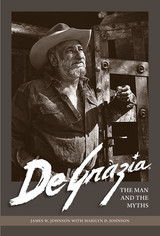 De Grazia: The Man and the Myths
James W. Johnson with Marilyn D. Johnson
University of Arizona Press, 2014 Artist Ted De Grazia (1909–1982) lived life with passion and verve, embracing risk and romance, becoming a legend in Arizona, and gaining international acclaim. De Grazia: The Man and the Myths is a biography that reveals the eccentric, colorful man behind the myths.
Born in Arizona Territory to Italian immigrant parents, De Grazia had a humble childhood as a copper miner’s son, which later influenced his famous persona. De Grazia often held forth at his gallery in Tucson’s Catalina foothills dressed in a pseudo-prospector’s getup of scraggly beard, jeans, flannel shirt, boots, and beat-up cowboy hat. Outrageous stories of womanizing, scores of children, and drinking binges created an eclectic image that fueled stories of mythic proportions, along with global sales of his colorful paintings inspired by the Southwest and Mexico. He made millions through his paintings and the licensing of his art for greeting cards and trinkets. Critics called his work kitsch or commercial, yet thousands of admirers continue to love it.
Calling De Grazia a complicated man doesn’t begin to explain him. He once described himself as “not saint nor devil, but both.” In this first comprehensive biography of De Grazia, authors James W. Johnson with Marilyn D. Johnson tell the story of a life remarkably lived.
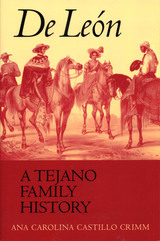 De León, a Tejano Family History
By Ana Carolina Castillo Crimm
University of Texas Press, 2003 Winner, Presidio La Bahia Award, 2004
San Antonio Conservation Society Citation, 2005 La familia de León was one of the foundation stones on which Texas was built. Martín de León and his wife Patricia de la Garza left a comfortable life in Mexico for the hardships and uncertainties of the Texas frontier in 1801. Together, they established family ranches in South Texas and, in 1824, the town of Victoria and the de León colony on the Guadalupe River (along with Stephen F. Austin's colony, the only completely successful colonization effort in Texas). They and their descendents survived and prospered under four governments, as the society in which they lived evolved from autocratic to republican and the economy from which they drew their livelihood changed from one of mercantile control to one characterized by capitalistic investments. Combining the storytelling flair of a novelist with a scholar's concern for the facts, Ana Carolina Castillo Crimm here recounts the history of three generations of the de León family. She follows Martín and Patricia from their beginnings in Mexico through the establishment of the family ranches in Texas and the founding of the de León colony and the town of Victoria. Then she details how, after Martín's death in 1834, Patricia and her children endured the Texas Revolution, exile in New Orleans and Mexico, expropriation of their lands, and, after returning to Texas, years of legal battles to regain their property. Representative of the experiences of many Tejanos whose stories have yet to be written, the history of the de León family is the story of the Tejano settlers of Texas.
 De l'indécision
Joseph Vogl
Diaphanes, 2016 À partir des réflexions proposées par Freud dans le Moïse de Michel-Ange, Joseph Vogl développe une théorie de l’indécision et présente dans le même temps un véritable système pour explorer cette notion dans toutes ses variantes et ses nuances : dans le glissement synonymique entre hésiter, tergiverser, osciller, rechigner, chanceler ou vaciller s’exprime un doute profond, une démarche inquiète, un recul. Pourtant, la perplexité implicite de cette hésitation n’implique pas tout simplement l’arrêt d’une action. Elle indique tout d’abord le seuil imperceptible entre action et non-action, un interstice régi par la pure contingence et la potentialité créatrice. En tant qu’acte de parole à la fois impuissant et résistant, l’indécision introduit une temporalité suspendue qui s’oppose au primat de l’acte posé par la culture occidentale.
Pour Joseph Vogl, un événement est toujours inscrit dans un ensemble stratifié formé par l’ensemble de ses variantes non réalisées. Sa recherche esthétique et historique attribue ainsi à l’indécision une place posée comme systématique : elle instaure une « méthode de complication » par laquelle le pouvoir discursif des événements historiques et politiques peut être interrogé et contenu. Considérée comme une attitude face au monde et un geste de mise en question radicale, la temporalité suspendue de l’indécision constitue enfin le champ opératoire du discours lui-même.
Dans ce petit essai brillant et érudit, Vogl retrace une « anti-histoire » de l’indécision qui apparaît surtout en littérature et prend corps à travers les siècles dans les personnages d’Oreste, de Wallenstein, de Joseph K., de Bartleby ou de l’homme sans qualités.
 De nobilitate animi
Guillelmus de Aragonia
Harvard University Press Guillelmus de Aragonia was known as a philosopher for his commentary on Boethius and his works on physiognomy, oneirology, and astronomy; he was also a physician, perhaps a personal physician to the king of Aragon. In a time of intellectual upheaval and civil strife, when nobility was on the verge of being defined with legal precision as it had not been since antiquity, Guillelmus taught that true nobility is an acquired habit, not an inborn quality. Guillelmus wrote De nobilitate animi, “On Nobility of Mind,” around 1280–1290. Working in the recently renewed Aristotelian tradition, he took an independent and original approach, quoting from philosophers, astronomers, physicians, historians, naturalists, orators, poets, and rustics pronouncing proverbs. This edition presents the Latin text, based on six manuscripts, three of them hitherto unknown, along with an English translation. An introduction reviews Guillelmus’s life and work, considering his theory of nobility in the contexts of history, philosophy, and rhetoric, and studies the authorities he quotes with particular attention to the troubadours, lyric poets from the area known today as the south of France. An appendix of sources and analogues is also included.
 The De Peyster Genealogy
Waldron Phoenix Belknap Jr.
Harvard University Press From the Preface:
The de Peysters were an armigerous family of Ghent, and can be traced as landowners of some importance in that neighborhood as far back as the thirteenth century. By custom they were associated with various of the mediaeval guilds of Ghent, especially the Goldsmiths' Guild, serving frequently as Chief-Dean and Syndic of more than one. Many, including Johannes de Peyster's grandfather, Josse de Peyster (1554- ?) of Ghent, were described as goldsmith, probably in the old meaning of banker. Their conversion to Protestantism caused the family to take refuge in Holland, while some established themselves in London and in Rouen.
The interest of the author, Waldron Phoenix Belknap, Jr., in his Dutch and Colonial ancestors prompted him to write this book. His painstaking research has given us a record of the de Peyster family up to the present, and brought to light many interesting and little-known facts about the family. Attention is called to the variation in the spelling of some names, in many instances of the same person, but the spelling follows the records as found.
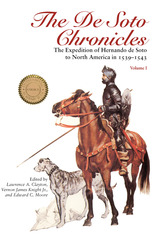 The De Soto Chronicles, 2 Volume Set: The Expedition of Hernando de Soto to North America in 1539-1543
Edited by Lawrence A. Clayton, Vernon James Knight Jr., and Edward C. Moore
University of Alabama Press, 1995 “For those interested in De Soto and his expedition, these volumes are an absolute necessity.” —The Hispanic American Historical Review
1993 Choice Outstanding Academic Book, sponsored by Choice Magazine
The De Soto expedition was the first major encounter of Europeans with indigenous North Americans in the eastern half of the United States. De Soto and his army of over 600 men, including 200 cavalry, spent four years traveling through what is now Florida, Georgia, Alabama, North and South Carolina, Tennessee, Mississippi, Louisiana, Arkansas, and Texas. The De Soto Chronicles Volume 1 and Volume 2 present for the first time all four primary accounts of the De Soto expedition together in English translation.
The four primary accounts are generally referred to as Elvas, Rangel, Biedma (in Volume 1), and Garcilaso, or the Inca (in Volume 2). In this landmark 1993 publication, Clayton’s team presents the four accounts with literary and historical introductions. They further add brief essays about De Soto and the expedition, translations of De Soto documents from the Spanish Archivo General de Indias, two short biographies of De Soto, and bibliographical studies.
For anthropologists, archaeologists, and historians, The De Soto Chronicles are valued for the unique ethnological information they contain. They form the only detailed eyewitness records of the most advanced native civilization in North America—the Mississippian culture—a culture largely lost in the wake of European contact.
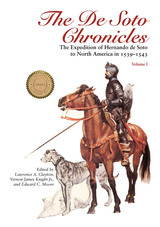 The De Soto Chronicles Vol 1: The Expedition of Hernando de Soto to North America in 1539-1543
Lawrence A. Clayton
University of Alabama Press, 1993 “For those interested in De Soto and his expedition, these volumes are an absolute necessity.” —The Hispanic American Historical Review
1993 Choice Outstanding Academic Book, sponsored by Choice Magazine
The De Soto expedition was the first major encounter of Europeans with indigenous North Americans in the eastern half of the United States. De Soto and his army of over 600 men, including 200 cavalry, spent four years traveling through what is now Florida, Georgia, Alabama, North and South Carolina, Tennessee, Mississippi, Louisiana, Arkansas, and Texas. The De Soto Chronicles Volume 1 and Volume 2 present for the first time all four primary accounts of the De Soto expedition together in English translation.
The four primary accounts are generally referred to as Elvas, Rangel, Biedma (in Volume 1), and Garcilaso, or the Inca (in Volume 2). In this landmark 1993 publication, Clayton’s team presents the four accounts with literary and historical introductions. They further add brief essays about De Soto and the expedition, translations of De Soto documents from the Spanish Archivo General de Indias, two short biographies of De Soto, and bibliographical studies.
For anthropologists, archaeologists, and historians, The De Soto Chronicles are valued for the unique ethnological information they contain. They form the only detailed eyewitness records of the most advanced native civilization in North America—the Mississippian culture—a culture largely lost in the wake of European contact.
 The De Soto Chronicles Vol 1: The Expedition of Hernando de Soto to North America in 1539-1543
Edited by Lawrence A. Clayton, Vernon James Knight Jr., and Edward C. Moore
University of Alabama Press, 2022 “For those interested in De Soto and his expedition, these volumes are an absolute necessity.” —The Hispanic American Historical Review
1993 Choice Outstanding Academic Book, sponsored by Choice Magazine
The De Soto expedition was the first major encounter of Europeans with indigenous North Americans in the eastern half of the United States. De Soto and his army of over 600 men, including 200 cavalry, spent four years traveling through what is now Florida, Georgia, Alabama, North and South Carolina, Tennessee, Mississippi, Louisiana, Arkansas, and Texas. The De Soto Chronicles Volume 1 and Volume 2 present for the first time all four primary accounts of the De Soto expedition together in English translation.
The four primary accounts are generally referred to as Elvas, Rangel, Biedma (in Volume 1), and Garcilaso, or the Inca (in Volume 2). In this landmark 1993 publication, Clayton’s team presents the four accounts with literary and historical introductions. They further add brief essays about De Soto and the expedition, translations of De Soto documents from the Spanish Archivo General de Indias, two short biographies of De Soto, and bibliographical studies.
For anthropologists, archaeologists, and historians, The De Soto Chronicles are valued for the unique ethnological information they contain. They form the only detailed eyewitness records of the most advanced native civilization in North America—the Mississippian culture—a culture largely lost in the wake of European contact.
 The De Soto Chronicles Vol 2: The Expedition of Hernando de Soto to North America in 1539-1543
Edited by Lawrence A. Clayton, Vernon James Knight Jr., and Edward C. Moore
University of Alabama Press, 2022 “For those interested in De Soto and his expedition, these volumes are an absolute necessity.” —The Hispanic American Historical Review
The De Soto expedition was the first major encounter of Europeans with indigenous North Americans in the eastern half of the United States. De Soto and his army of over 600 men, including 200 cavalry, spent four years traveling through what is now Florida, Georgia, Alabama, North and South Carolina, Tennessee, Mississippi, Louisiana, Arkansas, and Texas. The De Soto Chronicles Volume 1 and Volume 2 present for the first time all four primary accounts of the De Soto expedition together in English translation.
The four primary accounts are generally referred to as Elvas, Rangel, Biedma (in Volume 1), and Garcilaso, or the Inca (in Volume 2). In this landmark 1993 publication, Clayton’s team presents the four accounts with literary and historical introductions. They further add brief essays about De Soto and the expedition, translations of De Soto documents from the Spanish Archivo General de Indias, two short biographies of De Soto, and bibliographical studies.
For anthropologists, archaeologists, and historians, The De Soto Chronicles are valued for the unique ethnological information they contain. They form the only detailed eyewitness records of the most advanced native civilization in North America—the Mississippian culture—a culture largely lost in the wake of European contact.
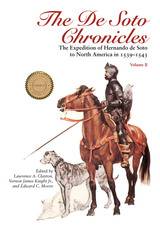 The De Soto Chronicles Vol 2: The Expedition of Hernando de Soto to North America in 1539-1543
Edited by Lawrence A. Clayton, Vernon James Knight Jr., and Edward C. Moore
University of Alabama Press, 1993 “For those interested in De Soto and his expedition, these volumes are an absolute necessity.” —The Hispanic American Historical Review
The De Soto expedition was the first major encounter of Europeans with indigenous North Americans in the eastern half of the United States. De Soto and his army of over 600 men, including 200 cavalry, spent four years traveling through what is now Florida, Georgia, Alabama, North and South Carolina, Tennessee, Mississippi, Louisiana, Arkansas, and Texas. The De Soto Chronicles Volume 1 and Volume 2 present for the first time all four primary accounts of the De Soto expedition together in English translation.
The four primary accounts are generally referred to as Elvas, Rangel, Biedma (in Volume 1), and Garcilaso, or the Inca (in Volume 2). In this landmark 1993 publication, Clayton’s team presents the four accounts with literary and historical introductions. They further add brief essays about De Soto and the expedition, translations of De Soto documents from the Spanish Archivo General de Indias, two short biographies of De Soto, and bibliographical studies.
For anthropologists, archaeologists, and historians, The De Soto Chronicles are valued for the unique ethnological information they contain. They form the only detailed eyewitness records of the most advanced native civilization in North America—the Mississippian culture—a culture largely lost in the wake of European contact.
 De Stijl 1917-1931: The Dutch Contribution to Modern Art
H. L. C. Jaffé
Harvard University Press, 1986 Here is the essential book on De Stijl, one of the longest lived and most influential of modern art movements. H. L. C. Jaffé recounts the history of this abstract movement; explains its artistic goals and practice; delineates its utopian ideology; and describes the special qualities of De Stijl painting, sculpture, architecture, and design.
Jaffé charts the evolution of the movement from its beginning in 1917 with the founding of the journal De Stijl. He locates the philosophical origins of the artistic program, which put aside representation of nature and confined itself to "pure" forms of expression: vertical and horizontal lines and the primary colors--yellow, blue, red--against white, black, and gray. He describes the roles of Ban Doesburg, De Stijl's driving force, and Mondrian, its leading exponent; the application of its principles to design and architecture; and the involvement of sculptors Arp and Brancusi. He places De Stijl in relation to other abstract arts and demonstrates its wide range of influence. Throughout Jaffé quotes extensively from the writings of the De Stijl group, allowing the artists themselves to describe their aims and methods; a complete forty-page pamphlet by Mondrian, Art and Life (1931) is appended.
The Dead Alive and Busy
Alan Shapiro
University of Chicago Press, 2000 In his sixth book of poems, Alan Shapiro once again shows that he is a master at articulating the secrets of the heart. The Dead Alive and Busy deals with issues of personal identity as revealed through examining the intimate bonds of family life. The poems explore these familial relations in terms of the religious, social, and literary contexts that inform them, delving into such universal themes as human frailty, illness and death, bereavement, and thwarted desires. By turns lyrical and narrative, slangy and elevated, analytical and visionary, this collection showcases one of America's most important poets in his top form.
Praise for Alan Shapiro: "Shapiro is a shrewd and sympathetic moralist. He never trivializes his subjects with high-minded flourishes or stylistic gimmicks."—J. D. McClatchy, New York Times Book Review
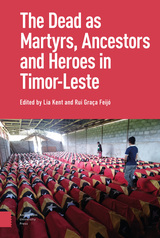 The Dead as Ancestors, Martyrs, and Heroes in Timor-Leste
Lia Kent
Amsterdam University Press, 2020 During the 24-year Indonesian occupation of East Timor, thousands of people died, or were killed, in circumstances that did not allow the required death rituals to be performed. Since the nation’s independence, families and communities have invested considerable time, effort and resources in fulfilling their obligations to the dead. These obligations are imbued with urgency because the dead are ascribed agency and can play a benevolent or malevolent role in the lives of the living. These grassroots initiatives run, sometimes critically, in parallel with official programs that seek to transform particular dead bodies into public symbols of heroism, sacrifice and nationhood. The Dead as Ancestors, Martyrs, and Heroes in Timor-Leste focuses on the dynamic interplay between the potent presence of the dead in everyday life and their symbolic usefulness to the state. It underlines how the dead shape relationships amongst families, communities and the nation-state, and open an important window into — are in fact pivotal to — processes of state and nation formation.
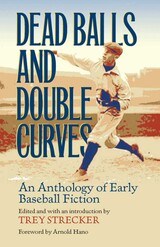 Dead Balls and Double Curves: An Anthology of Early Baseball Fiction
Edited and with an Introduction by Trey Strecker. Foreword by Arnold Hano
Southern Illinois University Press, 2004 Dead Balls and Double Curves: An Anthology of Early Baseball Fiction collects twenty-two classic stories from baseball’s youth, presented in chronological order to capture the development of this most American of sports. Many of these tales have never before been reprinted, adding historical value to the rich literary merits of this anthology. Editor Trey Strecker’s collection begins with an informal village match in an excerpt from James Fenimore Cooper’s Home as Found (1838), published the year prior to Abner Doubleday’s alleged invention of the game outside Cooperstown, New York, and concludes with the arrival of the superstar slugger that signaled the end of the dead-ball era in Heywood Broun’s The Sun Field (1923). The sampling of fiction from the eighty-five-year interim loads the bases with the humor, realism, and athletic gallantry of the sport’s earliest years. Not all grandstanding and heroism, these stories also explore cultural and class conflicts, racial strife, town rivalries, labor disputes, gambling scandals, and the striking personalities that decorated a simple game’s evolution into a national pastime. Dead Balls and Double Curves presents a lineup of first-division writers, including Mark Twain, Frank Norris, Christy Mathewson, Edna Ferber, and the game’s poet laureate, Ring Lardner, plus legendary characters such as Baseball Joe, South-Paw Skaggs, Tin Can Tommy, and the sole artiste of the mythic double curve, Frank Merriwell. Throughout the volume, each author’s abiding affection for the game and its characters shines through with diamond-like focus.
Dead Elvis: A Chronicle of a Cultural Obsession
Greil Marcus
Harvard University Press In life, Elvis Presley went from childhood poverty to stardom, from world fame to dissipation and early death. As Greil Marcus shows in this remarkable book, Presley's journey after death takes him even further, pushing him beyond his own frontiers to merge with the American public consciousness—and the American subconscious.
As he listens in on the public conversation that recreates Elvis after death, Marcus tracks the path of Presley's resurrection. He grafts together scattered fragments of the eclectic dialogue—snatches of movies and music, books and newspapers, photographs, posters, cartoons—and amazes us with not only what America has been saying as it raises its late king, but also what this strange obsession with a dead Elvis can tell us about America itself.
Dead End Kids: Gang Girls and the Boys They Know
Mark S. Fleisher
University of Wisconsin Press, 2000 Dead End Kids exposes both the depravity and the humanity in gang life through the eyes of a teenaged girl named Cara, a member of a Kansas City gang. In this shocking yet compassionate account, Mark Fleisher shows how gang girls’ lives are shaped by poverty, family disorganization, and parental neglect.
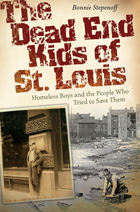 The Dead End Kids of St. Louis: Homeless Boys and the People Who Tried to Save Them
Bonnie Stepenoff
University of Missouri Press, 2021 Joe Garagiola remembers playing baseball with stolen balls and bats while growing up on the Hill. Chuck Berry had run-ins with police before channeling his energy into rock and roll. But not all the boys growing up on the rough streets of St. Louis had loving families or managed to find success. This book reviews a century of history to tell the story of the “lost” boys who struggled to survive on the city’s streets as it evolved from a booming late-nineteenth-century industrial center to a troubled mid-twentieth-century metropolis. To the eyes of impressionable boys without parents to shield them, St. Louis presented an ever-changing spectacle of violence. Small, loosely organized bands from the tenement districts wandered the city looking for trouble, and they often found it. The geology of St. Louis also provided for unique accommodations—sometimes gangs of boys found shelter in the extensive system of interconnected caves underneath the city. Boys could hide in these secret lairs for weeks or even months at a stretch. Bonnie Stepenoff gives voice to the harrowing experiences of destitute and homeless boys and young men who struggled to grow up, with little or no adult supervision, on streets filled with excitement but also teeming with sharpsters ready to teach these youngsters things they would never learn in school. Well-intentioned efforts of private philanthropists and public officials sometimes went cruelly astray, and sometimes were ineffective, but sometimes had positive effects on young lives. Stepenoff traces the history of several efforts aimed at assisting the city’s homeless boys. She discusses the prison-like St. Louis House of Refuge, where more than 80 percent of the resident children were boys, and Father Dunne's News Boys' Home and Protectorate, which stressed education and training for more than a century after its founding. She charts the growth of Skid Row and details how historical events such as industrialization, economic depression, and wars affected this vulnerable urban population. Most of these boys grew up and lived decent, unheralded lives, but that doesn’t mean that their childhood experiences left them unscathed. Their lives offer a compelling glimpse into old St. Louis while reinforcing the idea that society has an obligation to create cities that will nurture and not endanger the young.
Dead Ends of Transition: Rentier Economies and Protectorates
Edited by Michael Dauderstädt and Arne Schildberg
Campus Verlag, 2006 After war, many countries, such as Bosnia, Kosovo, Afghanistan, or Iraq, the transition to a democratic market economy extremely difficult. This failure to thrive, Dead Ends of Transition demonstrates, is often the result of national reliance on foreign aid. Rentier states, the contributors to this study argue, have few incentives to respond to the needs of their societies. Taking a closer look at the policies of rentier economies, this book further identifies new ways in which these countries and their international partners could work together to ease the critical transition to democracy.
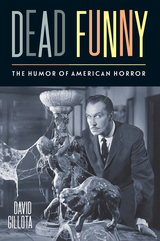 Dead Funny: The Humor of American Horror
David Gillota
Rutgers University Press, 2023 Horror films strive to make audiences scream, but they also garner plenty of laughs. In fact, there is a long tradition of horror directors who are fluent in humor, from James Whale to John Landis to Jordan Peele. So how might horror and humor overlap more than we would expect?
Dead Funny locates humor as a key element in the American horror film, one that is not merely used for extraneous “comic relief” moments but often serves to underscore major themes, intensify suspense, and disorient viewers. Each chapter focuses on a different comic style or device, from the use of funny monsters and scary clowns in movies like A Nightmare on Elm Street to the physical humor and slapstick in movies ranging from The Evil Dead to Final Destination. Along the way, humor scholar David Gillota explores how horror films employ parody, satire, and camp to comment on gender, sexuality, and racial politics. Covering everything from the grotesque body in Freaks to the comedy of awkwardness in Midsommar, this book shows how integral humor has been to the development of the American horror film over the past century.
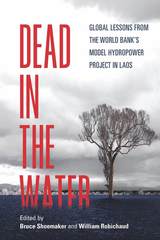 Dead in the Water: Global Lessons from the World Bank's Model Hydropower Project in Laos
Edited by Bruce Shoemaker and William Robichaud; foreword by Yos Santasombat; afterword by Philip Hirsch
University of Wisconsin Press, 2019 For decades, large dam projects have been undertaken by both nations and international agencies with the aim of doing good: preventing floods, bringing electricity to rural populations, producing revenues for poor countries, and more. But time after time, the social, economic, and environmental costs have outweighed the benefits of the dams, sometimes to a disastrous degree. In this volume, a diverse group of experts—involved for years with the Nam Theun 2 dam in Laos—issue an urgent call for critical reassessment of the approach to, and rationale for, these kinds of large infrastructure projects in developing countries.
In the 2000s, as the World Bank was reeling from revelations of past hydropower failures, it nonetheless promoted the enormous Nam Theun 2 project. NT2, the Bank believed, offered a new, wiser model of dam development that would alleviate poverty, protect the environment, engage locally affected people in a transparent fashion, and stimulate political transformation. This was a tall order. For the first time, this book shows in detail why, despite assertions of success from the World Bank and other agencies involved in the project, the dam's true story has been one of substantial loss for affected villagers and the regional environment. Nam Theun 2 is an important case study that illustrates much broader problems of global development policy.
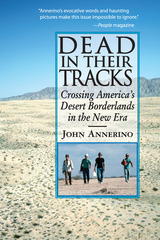 Dead in Their Tracks: Crossing America’s Desert Borderlands in the New Era
John Annerino
University of Arizona Press, 2009 Alarmed by breaking news reports of thirteen men, women, and children who died of thirst on American soil—and twenty-two other human beings saved by Border Patrol rescue teams—John Annerino left the cool pines of his mountain retreat and journeyed into one of the most inhospitable places on earth, the heart of the 4,100-square-mile “empty quarter” that straddles the desolate corner of southwest Arizona and northwest Sonora, Mexico.
During the Sonoran Desert’s glorious and brutal summer season Annerino, a photojournalist, author, and explorer, watched four border crossers step off a bus and nonchalantly head into the American no-man’s land. On assignment for Newsweek, Annerino did more than just watch on that blistering August day. He joined them on their ultramarathon, life-or-death quest to find work to feed their families, amid temperatures so hot your parched throat burns from breathing and drinking water is the ultimate treasure.
As their water dwindled and the heat punished them, Annerino and the desperate men continued marching fifty miles in twenty-four hours and managed to survive their harrowing journey across the deadliest migrant trail in North America, El Camino del Diablo, “The Road of the Devil.” Driven by the mounting death toll, John returned again and again to the sun-scorched despoblado (uninhabited lands)—where hidden bighorn sheep water tanks glowed like diamonds—to document the lives, struggles, and heartbreaking remains of those who continue to disappear and perish in a region that’s claimed the lives of more than 9,700 men, women, and children.
Following the historic paths of indigenous Hia Ced O’odham (People of the Sand), Spanish missionary explorer Padre Eusebio Francisco Kino, and California-bound Forty-Niners, Annerino’s journeys on foot, crisscrossed the alluring yet treacherous desert trails of the El Camino del Diablo, Hohokam shell trail, and O’odham salt trails where hundreds of gambusinos (Mexican miners) and Euro-American pioneers succumbed during the 1850s.
As the migrants kept coming, the deaths kept mounting, and Annerino kept returning. He crossed celebrated Sonoran Desert sanctuaries—Organ Pipe Cactus National Monument, a UNESCO Biosphere Reserve, Cabeza Prieta National Wildlife Refuge, Barry M. Goldwater Range, sacred ancestral lands of the Tohono O’odham—that had become lost horizons, killing grounds, graveyards, and deadly smuggling corridors that also claimed the lives of National Park rangers and Border Patrol agents. John Annerino’s mission was to save someone, anyone, everyone—when he could find them.
Dead in Their Tracks is the saga of a merciless despoblado in the Great Southwest, of desperate yet hopeful migrants and refugees who keep staggering north. It is the story of ranchers, locals, and Border Patrol trackers who’ve saved countless lives, and heavily armed smugglers who haunt an inhospitable, if beautiful, wilderness that remains off the radar for journalists and news organizations that dare not set foot in the American desert waiting to welcome them on its terms.
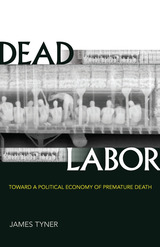 Dead Labor: Toward a Political Economy of Premature Death
James Tyner
University of Minnesota Press, 2019 A groundbreaking consideration of death from capitalism, from the seventeenth to the twenty-first century From a 2013 Texas fertilizer plant explosion that killed fifteen people and injured 252 to a 2017 chemical disaster in the wake of Hurricane Harvey, we are confronted all too often with industrial accidents that reflect the underlying attitude of corporations toward the lives of laborers and others who live and work in their companies’ shadows. Dead Labor takes seriously the myriad ways in which bodies are commodified and profits derived from premature death. In doing so it provides a unique perspective on our understanding how life and death drive the twenty-first-century global economy. James Tyner tracks a history from the 1600s through which premature death and mortality became something calculable, predictable, manageable, and even profitable. Drawing on a range of examples, including the criminalization of migrant labor, medical tourism, life insurance, and health care, he explores how today we can no longer presume that all bodies undergo the same processes of life, death, fertility, and mortality. He goes on to develop the concept of shared mortality among vulnerable populations and examines forms of capital exploitation that have emerged around death and the reproduction of labor. Positioned at the intersection of two fields—the political economy of labor and the philosophy of mortality—Dead Labor builds on Marx’s notion that death (and truncated life) is a constant factor in the processes of labor. Considering premature death also as a biopolitical and bioeconomic concept, Tyner shows how racialized and gendered bodies are exposed to it in unbalanced ways within capitalism, and how bodies are then commodified, made surplus and redundant, and even disassembled in order to accumulate capital.
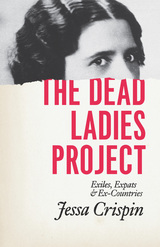 The Dead Ladies Project: Exiles, Expats, and Ex-Countries
Jessa Crispin
University of Chicago Press, 2015 When Jessa Crispin was thirty, she burned her settled Chicago life to the ground and took off for Berlin with a pair of suitcases and no plan beyond leaving. Half a decade later, she’s still on the road, in search not so much of a home as of understanding, a way of being in the world that demands neither constant struggle nor complete surrender.
The Dead Ladies Project is an account of that journey—but it’s also much, much more. Fascinated by exile, Crispin travels an itinerary of key locations in its literary map, of places that have drawn writers who needed to break free from their origins and start afresh. As she reflects on William James struggling through despair in Berlin, Nora Barnacle dependant on and dependable for James Joyce in Trieste, Maud Gonne fomenting revolution and fostering myth in Dublin, or Igor Stravinsky starting over from nothing in Switzerland, Crispin interweaves biography, incisive literary analysis, and personal experience into a rich meditation on the complicated interactions of place, personality, and society that can make escape and reinvention such an attractive, even intoxicating proposition.
Personal and profane, funny and fervent, The Dead Ladies Project ranges from the nineteenth century to the present, from historical figures to brand-new hangovers, in search, ultimately, of an answer to a bedrock question: How does a person decide how to live their life?
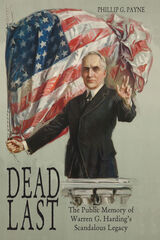 Dead Last: The Public Memory of Warren G. Harding’s Scandalous Legacy
Phillip G. Payne
Ohio University Press, 2008 If George Washington and Abraham Lincoln are the saints in America’s civil religion, then the twenty-ninth president, Warren G. Harding, is our sinner. Prior to the Nixon administration, the Harding scandals were the most infamous of the twentieth century. Harding is consistently judged a failure, ranking dead last among his peers. By examining the public memory of Harding, Phillip G. Payne offers the first significant reinterpretation of his presidency in a generation. Rather than repeating the old stories, Payne examines the contexts and continued meaning of the Harding scandals for various constituencies. Payne explores such topics as Harding’s importance as a midwestern small-town booster, his rumored black ancestry, the role of various biographers in shaping his early image, the tension between public memory and academic history, and, finally, his status as an icon of presidential failure in contemporary political debates. Harding was a popular president and was widely mourned when he died in office in 1923; but with his death began the construction of his public memory and his fall from political grace. In Dead Last, Payne explores how Harding’s name became synonymous with corruption, cronyism, and incompetence and how it is used to this day as an example of what a president should not be.
Dead Laws for Dead Men: The Politics of Federal Coal Mine Health and Safety Legislation
Daniel J. Curran
University of Pittsburgh Press, 1993 This account of the struggle for coal mine health and safety legislation in the U.S. examines the series of laws that steadily expanded the role of the federal government from the late 1800s through the 1980s. Curran concludes that federal legislation has done little to improve change conditions in the coal mines.
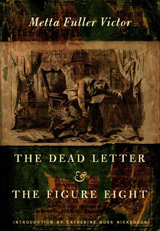 The Dead Letter and The Figure Eight
Metta Fuller Victor
Duke University Press, 2003 Before Raymond Chandler, before Dorothy Sayers or Agatha Christie, there was Metta Fuller Victor, the first American author—man or woman—of a full-length detective novel. This novel, The Dead Letter, is presented here along with another of Victor’s mysteries, The Figure Eight. Both written in the 1860s and published under the name Seeley Regester, these novels show how—by combining conventions of the mystery form first developed by Edgar Allan Poe with those of the domestic novel—Victor pioneered the domestic detective story and paved the way for generations of writers to follow. In The Dead Letter, Henry Moreland is killed by a single stab to the back. Against a background of post–Civil War politics, Richard Redfield, a young attorney, helps Burton, a legendary New York City detective, unravel the crime. In The Figure Eight, Joe Meredith undertakes a series of adventures and assumes a number of disguises to solve the mystery of the murder of his uncle and regain the lost fortune of his angelic cousin.
Dead Letters to Nietzsche, or the Necromantic Art of Reading Philosophy
Joanne Faulkner
Ohio University Press, 2010 Dead Letters to Nietzsche examines how writing shapes subjectivity through the example of Nietzsche’s reception by his readers, including Stanley Rosen, David Farrell Krell, Georges Bataille, Laurence Lampert, Pierre Klossowski, and Sarah Kofman. More precisely, Joanne Faulkner finds that the personal identification that these readers form with Nietzsche’s texts is an enactment of the kind of identity-formation described in Lacanian and Kleinian psychoanalysis. This investment of their subjectivity guides their understanding of Nietzsche’s project, the revaluation of values. Not only does this work make a provocative contribution to Nietzsche scholarship, but it also opens in an original way broader philosophical questions about how readers come to be invested in a philosophical project and how such investment alters their subjectivity.
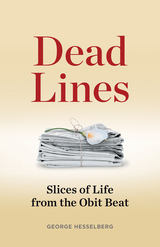 Dead Lines: Slices of Life from the Obit Beat
George Hesselberg
Wisconsin Historical Society Press, 2021 In a lively collection of feature obituaries and related news stories, longtime newspaper reporter George Hesselberg celebrates life, sharing the most fascinating stories that came from decades of covering the obit and public safety beats.
In more than forty years at the Wisconsin State Journal, Hesselberg frequently found himself writing about fatal accidents, crime investigations, and the deaths of the wealthy, famous, or notorious. But he was most drawn to the curious, the unknown, and the unsung—the deaths that normally wouldn’t make much of a splash, if any mention at all, in the news columns of a daily paper.
Digging deeper, he uncovered the extraordinary among the ordinary, memorializing the lives of a sword designer, a radio villain, a pioneering female detective, a homeless woman who spoke fluent French, a beloved classroom tarantula, and many more. Their stories are alternately amusing, sad, surprising, and profound. Together they speak to a shared human experience and inspire us to see the people around us with new eyes, valuing the lives while they are still being lived.
 Dead Man's Rapids
William Durbin
University of Minnesota Press, 2018 When 13-year-old Ben Ward left school to work with his Pa in a logging camp, a winter of peeling potatoes and setting tables wasn’t the adventure he had in mind. Still, come spring, he signs up for the log drive with his friend Nevers, wishing the head cook on the wanigan (the floating cook shack) could be someone other than his crabby Pa. Fate, with a wink, complies, and Pa quits—only to be replaced by someone far worse: Pete Sardman, aka Old Sard, a cantankerous character complete with a greasy apron, an eye patch, one deaf ear, and plenty to say. Luckily, there’s also the rest of the crew—a colorful, sometimes outrageous company of men. Together Ben and Nevers endure freezing weather, dangerous rapids, logjams, storms and floods, and a number of gripping tall tales, along the way learning about logging on the river and a whole lot more about life. Taking up where Blackwater Ben left off, Dead Man’s Rapids returns to the north woods of Minnesota in the late nineteenth century, and with warmth, humor, and attention to historical detail engages readers both young and old.
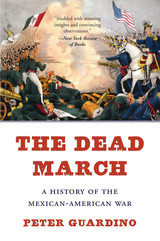 The Dead March: A History of the Mexican-American War
Peter Guardino
Harvard University Press, 2020 Winner of the Bolton-Johnson Prize
Winner of the Utley Prize
Winner of the Distinguished Book Award, Society for Military History
“The Dead March incorporates the work of Mexican historians…in a story that involves far more than military strategy, diplomatic maneuvering, and American political intrigue…Studded with arresting insights and convincing observations.”
—James Oakes, New York Review of Books
“Superb…A remarkable achievement, by far the best general account of the war now available. It is critical, insightful, and rooted in a wealth of archival sources; it brings far more of the Mexican experience than any other work…and it clearly demonstrates the social and cultural dynamics that shaped Mexican and American politics and military force.”
—Journal of American History
It has long been held that the United States emerged victorious from the Mexican–American War because its democratic system was more stable and its citizens more loyal. But this award-winning history shows that Americans dramatically underestimated the strength of Mexican patriotism and failed to see how bitterly Mexicans resented their claims to national and racial superiority. Their fierce resistance surprised US leaders, who had expected a quick victory with few casualties.
By focusing on how ordinary soldiers and civilians in both countries understood and experienced the conflict, The Dead March offers a clearer picture of the brief, bloody war that redrew the map of North America.
 Dead Moose on Isle Royale: Off Trail with the Citizen Scientists of the Wolf-Moose Project
Jeffrey M Holden
Michigan State University Press, 2025 Isle Royale in Michigan is one of the most remote and pristine of all the U.S. national parks, and it is the site of the world’s longest-running predator–prey study. Every summer, Jeffrey M. Holden leads groups of citizen scientists on week-long expeditions to search for dead moose. Those intrepid enough to join him backpacking off trail in Isle Royale’s rugged beauty face challenges from treacherous weather conditions, to wildlife, primitive backcountry camping, traveling through swamps and wetlands, and backpacks that grow heavier with bones every time a new dead moose is found. Sometimes the moose they find are long dead, with only a scattering of bones remaining. Sometimes they are freshly departed, rotted, stinking, and covered with thousands of bloodthirsty ticks. Scientists use the bones, photos, and data they collect to reconstruct the moose population through the years, correlating it against other data on wolves, weather, and ticks. This book provides a fascinating look into the day-to-day realities of backpacking in the wilderness, while featuring the extraordinary scientific discoveries of the Wolf-Moose Project itself and highlighting the role and rewards for volunteers in this extraordinary endeavor. This is a must read for anyone who is interested in off-trail hiking, becoming a citizen scientist, or exploring America’s least-visited national park.
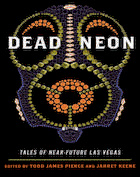 Dead Neon: Tales of Near-Future Las Vegas
Todd Pierce
University of Nevada Press, 2010 Las Vegas is considered a modern icon of excess. It offers every imaginable extreme of greed, pleasure, and despair, all supported by technology that enhances fantasy and allows residents and visitors alike to forget reality and responsibility. The authors of the fourteen stories in Dead Neon imagine Sin City in the near future, when excess has led to social, environmental, or economic collapse. Their stories range from futuristic casinos to the seared post-apocalyptic desert, from the struggle to survive in a repressive theocracy to the madness of living in a world where most life forms and all moral codes have vanished. Dead Neon explores the possible future of America by examining the near future of Las Vegas. The authors, all either Vegas-based or intimately familiar with the city, capture its unique rhythms and flavor and probe its potential for evoking the fullest range of the human spirit in settings of magic, horror, and despair.
The Dead of Achill Island
Betsy Draine and Michael Hinden
University of Wisconsin Press, 2019 Art historian Nora Barnes and her husband, Toby Sandler, are visiting West Ireland for a family reunion. During a morning walk through a deserted village on Achill Island, Nora stumbles upon a body—her notorious uncle Bert. When a clue singles out her mother as the likely suspect, Nora and Toby are on the case to clear her name. Whether in a barroom brawl or the sauna of a swingers’ club, Toby has Nora’s back. As they search, the dead of Achill seem to speak from graveyards, ruined churches, and megalithic tombs. A second murder makes it all the more difficult to connect the dots. And when Nora and Toby become the next targets, their own survival is at stake.
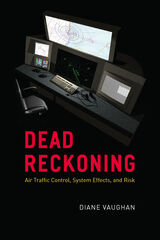 Dead Reckoning: Air Traffic Control, System Effects, and Risk
Diane Vaughan
University of Chicago Press, 2021 Vaughan unveils the complicated and high-pressure world of air traffic controllers as they navigate technology and political and public climates, and shows how they keep the skies so safe.
When two airplanes were flown into the World Trade Center towers on September 11, 2001, Americans watched in uncomprehending shock as first responders struggled to react to the situation on the ground. Congruently, another remarkable and heroic feat was taking place in the air: more than six hundred and fifty air traffic control facilities across the country coordinated their efforts to ground four thousand flights in just two hours—an achievement all the more impressive considering the unprecedented nature of the task.
In Dead Reckoning, Diane Vaughan explores the complex work of air traffic controllers, work that is built upon a close relationship between human organizational systems and technology and is remarkably safe given the high level of risk. Vaughan observed the distinct skill sets of air traffic controllers and the ways their workplaces changed to adapt to technological developments and public and political pressures. She chronicles the ways these forces affected their jobs, from their relationships with one another and the layouts of their workspace to their understanding of their job and its place in society. The result is a nuanced and engaging look at an essential role that demands great coordination, collaboration, and focus—a role that technology will likely never be able to replace. Even as the book conveys warnings about complex systems and the liabilities of technological and organizational innovation, it shows the kinds of problem-solving solutions that evolved over time and the importance of people.
The Dead Sea Scrolls in Scholarly Perspective: A History of Research
Devorah Dimant
SBL Press, 2016 Now in paperback! The volume covers Qumran scholarship in separate countries: the USA, Canada, Israel, France, Germany, Spain, the Netherlands, Scandinavia, Italy, and Eastern Europe. Each essay carries a detailed bibliography for the respective country. Biographies of all the major scholars active in the field are briefly given as well. This book thereby exhaustively surveys past and present Qumran research, outlining its particular development in various circumstances and national contexts. For the first time, perspectives and information not recorded in any other publication are highlighted. Features: Paperback format of an essential Brill resource Twenty-seven articles by twenty-six of the top scholars in the field Contributions represent the work of more than sixty years of scholarly research
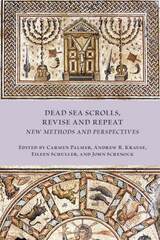 Dead Sea Scrolls, Revise and Repeat: New Methods and Perspectives
Carmen Palmer
SBL Press, 2020 A reexamination of the people and movements associated with Qumran, their outlook on the world, and what bound them together
Dead Sea Scrolls, Revise and Repeat examines the identity of the Qumran movement by reassessing former conclusions and bringing new methodologies to the study of the Dead Sea Scrolls. The collection as a whole addresses questions of identity as they relate to law, language, and literary formation; considerations of time and space; and demarcations of the body. The thirteen essays in this volume reassess the categorization of rule texts, the reuse of scripture, the significance of angelic fellowship, the varieties of calendrical use, and celibacy within the Qumran movement. Contributors consider identity in the Dead Sea Scrolls from new interdisciplinary perspectives, including spatial theory, legal theory, historical linguistics, ethnicity theory, cognitive literary theory, monster theory, and masculinity theory.
Features
- Essays that draw on new theoretical frameworks and recent advances in Qumran studies
- A tribute to the late Peter Flint, whose scholarship helped to shape Qumran studies
 Dead Subjects: Toward a Politics of Loss in Latino Studies
Antonio Viego
Duke University Press, 2007 Dead Subjects is an impassioned call for scholars in critical race and ethnic studies to engage with Lacanian psychoanalytic theory. Antonio Viego argues that Lacanian theory has the potential to begin rectifying the deeply flawed way that ethnic and racialized subjects have been conceptualized in North America since the mid-twentieth century. Viego contends that the accounts of human subjectivity that dominate the humanities and social sciences and influence U.S. legal thought derive from American ego psychology. Examining ego psychology in the United States during its formative years following World War II, Viego shows how its distinctly American misinterpretation of Freudian theory was driven by a faith in the possibility of rendering the human subject whole, complete, and transparent. Viego traces how this theory of the subject gained traction in the United States, passing into most forms of North American psychology, law, civil rights discourse, ethnic studies, and the broader culture. Viego argues that the repeated themes of wholeness, completeness, and transparency with respect to ethnic and racialized subjectivity are fundamentally problematic as these themes ultimately lend themselves to the project of managing and controlling ethnic and racialized subjects by positing them as fully knowable, calculable sums: as dead subjects. He asserts that the refusal of critical race and ethnic studies scholars to read ethnic and racialized subjects in a Lacanian framework—as divided subjects, split in language—contributes to a racist discourse. Focusing on theoretical, historical, and literary work in Latino studies, he mines the implicit connection between Latino studies’ theory of the “border subject” and Lacan’s theory of the “barred subject” in language to argue that Latino studies is poised to craft a critical multiculturalist, anti-racist Lacanian account of subjectivity while adding historical texture and specificity to Lacanian theory.
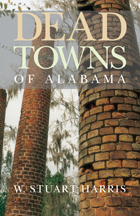 Dead Towns of Alabama
W. Stuart Harris
University of Alabama Press, 2001 This easy-to-use reference work documents the many long-vanished towns, forts, settlements, and former state capitals that were once thriving communities of Alabama. Dead Towns of Alabama is not merely a series of obituaries for dead towns. Instead, it brings back to life 83 Indian towns, 77 fort sites, and 112 colonial, territorial, and state towns. W. Stuart Harris conjures up a wealth of fascinating images from Alabama's rich and colorful past--images of life as the Indians lived it, of colonial life in the wilderness, of Spanish explorers and French exiles, of danger and romance, of riverboats and railroads, of plantations and gold mines, of stagecoaches and ferries. Overall, it presents a thoroughly absorbing panorama of Alabama's early history. Here we learn about two former capitals--St. Stephens and Cahaba--that have deteriorated to mouldering ruins now. We learn about once thriving communities--county seats, river landings and crossings, trading posts, junctions, and other settlements--that time has forgotten. Absent from most maps, these sites come alive again in Harris's fascinating account, filled anew with the bustling activity of their former inhabitants. First published in 1977, Dead Towns of Alabama is a unique guidebook to every region of the state. It is an invaluable resource for historians, students, tourists, and anyone interested in exploring Alabama's interesting historical and cultural past.
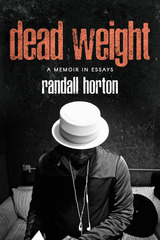 Dead Weight: A Memoir in Essays
Randall Horton
Northwestern University Press, 2022 Dead Weight chronicles the improbable turnaround of a drug smuggler who, after being sentenced to eight years in state prison, returned to society to earn a PhD in creative writing and become the only tenured professor in the United States with seven felony convictions. Horton’s visceral essays highlight the difficulties of trying to change one’s life for the better, how the weight of felony convictions never dissipates.
The memoir begins with a conversation between Horton and Ralph Ellison’s Invisible Man statue in New York City. Their imagined dialogue examines the psychological impact of racism on Black men and boys, including Horton’s separation from his mother, immediately after his birth, in a segregated Alabama hospital. From his current life as a professor and prison reformer, Horton looks back on his experiences as a drug smuggler and trafficker during the 1980s–1990s as well as the many obstacles he faced after his release. He also examines the lasting impact of his drug activity on those around him, reflecting on the allure of economic freedom and the mental escapism that cocaine provided, an allure so strong that both sellers and users were willing to risk prison. Horton shares historical context and vivid details about people caught in the war on drugs who became unsuspecting protagonists in somebody else’s melodrama.
Lyrical and gripping, Dead Weight reveals the lifelong effects of one man’s incarceration on his psyche, his memories, and his daily experience of American society.
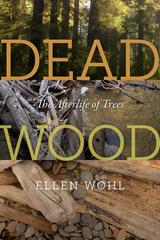 Dead Wood: The Afterlife of Trees
Ellen Wohl
Oregon State University Press, 2022 The west is full of magnificent trees: mighty spruces, towering cedars, and stout firs. We are used to appreciating trees during their glory years, but how often do we consider what happens to a tree when it dies? We’ve all seen driftwood on the beach. But how many people have truly looked at it and appreciated its ecological role?
Ellen Wohl has thought about these questions, and In Dead Wood, she takes us through the afterlife of trees, describing the importance of standing and downed dead wood in forests, in rivers, along beaches, in the open ocean, and even at the deepest parts of the seafloor. Downed wood in the forest provides habitat for diverse plants and animals, and the progressive decay of the wood releases nutrients into the soil. Wood in rivers provides critical habitat for stream insects and fish and can accumulate in logjams that divert the river repeatedly across the valley floor, creating a floodplain mosaic that is rich in habitat and biodiversity. Driftwood on the beach helps to stabilize shifting sand, creating habitat for plants and invertebrates. Fish such as tuna congregate at driftwood in the open ocean. As driftwood becomes saturated and sinks to the ocean floor, collections of sunken wood provide habitat and nutrients for deep-sea organisms. Far from being an unsightly form of waste that needs to be cleaned from forests, beaches, and harbors, dead wood is a critical resource for many forms of life.
Dead Wood follows the afterlives of three trees: a spruce in the Colorado Rocky Mountains that remains on the floodplain after death; a redcedar in Washington that is gradually transported downstream to the Pacific; and a poplar in the Mackenzie River of Canada that is transported to the Arctic Ocean. With these three trees, Wohl encourages readers to see beyond landscapes, to appreciate the ecological processes that drive rivers and forests and other ecosystems, and demonstrates the ways that the life of an ecosystem carries on even when individual members of that system have died. Readers will discover that trees can have an exceptionally rich afterlife—one tightly interwoven with the lives of humans and ecosystems.
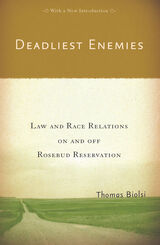 Deadliest Enemies: Law and Race Relations on and off Rosebud Reservation
Thomas Biolsi
University of Minnesota Press, 2007 Many people living far away from Indian reservations express sympathy for the poverty and misery experienced by Native Americans, yet, Thomas Biolsi argues, the problems faced by Native Americans are the results of white privilege. In Deadliest Enemies, Biolsi connects the origins of racial tension between Indians and non-Indians on the Rosebud Reservation in South Dakota to federal laws, showing how the courts have created opposing political interests along race lines. Biolsi demonstrates that the court’s definitions of legal rights—both constitutional and treaty rights—make solutions to racial tensions intractable. This powerful work sheds much-needed light on racial conflicts in South Dakota and in the rest of the United States, and holds white people accountable for the benefits of their racial privilege that come at the expense of Native Americans. Thomas Biolsi is professor of Native American studies at the University of California at Berkeley.
 Deadline: 200 Years of Violence Against Journalists in the United States
Elizabeth Atwood
University of Missouri Press, 2025 In Deadline: 200 Years of Violence against Journalists in the United States, Elizabeth Atwood offers the first comprehensive look at the history of fatal attacks against journalists in the United States between 1829 and the present. Atwood describes the political, technological, and economic context of these assaults, and includes brief biographies of the victims and accounts of what happened both them and to their assailants after the attacks.
To help us understand these attacks, Atwood presents a framework for categorizing them, built on John Nerone’s studies on assaults on American media workers. Atwood categorizes attacks against journalists as attacks against individuals, ideas, and media institutions, and undertaken to suppress reporting on certain topics and in the context of wars and other international or conflicts. Crucially, Deadline utilizes this framework to offer possible solutions to the issue of violence against journalists.
Atwood was inspired to explore the pressing issue of violence against American journalists after the tragic death of one of her colleagues at the Baltimore Sun, Rob Hiaasen, in the Capital Gazette shooting in 2018. Throughout, she demonstrates that distrust of the media and violence against the press in the United States are hardly new developments. Her work examines how intimidation, violence, and censorship have, in fact, been used against the American press since both its and the nation’s founding.
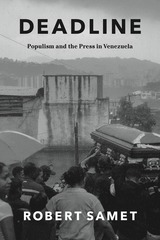 Deadline: Populism and the Press in Venezuela
Robert Samet
University of Chicago Press, 2019 Since 2006, Venezuela has had the highest homicide rate in South America and one of the highest levels of gun violence in the world. Former president Hugo Chávez, who died in 2013, downplayed the extent of violent crime and instead emphasized rehabilitation. His successor, President Nicolás Maduro, took the opposite approach, declaring an all-out war on crime (mano dura). What accounts for this drastic shift toward more punitive measures?
In Deadline, anthropologist Robert Samet answers this question by focusing on the relationship between populism, the press, and what he calls “the will to security.” Drawing on nearly a decade of ethnographic research alongside journalists on the Caracas crime beat, he shows how the media shaped the politics of security from the ground up. Paradoxically, Venezuela’s punitive turn was not the product of dictatorship, but rather an outgrowth of practices and institutions normally associated with democracy. Samet reckons with this apparent contradiction by exploring the circulation of extralegal denuncias (accusations) by crime journalists, editors, sources, and audiences. Denuncias are a form of public shaming or exposé that channels popular anger against the powers that be. By showing how denuncias mobilize dissent, Deadline weaves a much larger tale about the relationship between the press, popular outrage, and the politics of security in the twenty-first century.
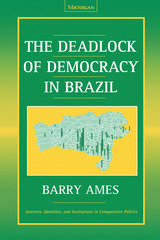 The Deadlock of Democracy in Brazil
Barry Ames
University of Michigan Press, 2002 Many countries have experimented with different electoral rules in order either to increase involvement in the political system or make it easier to form stable governments. Barry Ames explores this important topic in one of the world's most populous and important democracies, Brazil. This book locates one of the sources of Brazil's "crisis of governance" in the nation's unique electoral system, a system that produces a multiplicity of weak parties and individualistic, pork-oriented politicians with little accountability to citizens. It explains the government's difficulties in adopting innovative policies by examining electoral rules, cabinet formation, executive-legislative conflict, party discipline and legislative negotiation.
The book combines extensive use of new sources of data, ranging from historical and demographic analysis in focused comparisons of individual states to unique sources of data for the exploration of legislative politics. The discussion of party discipline in the Chamber of Deputies is the first multivariate model of party cooperation or defection in Latin America that includes measures of such important phenomena as constituency effects, pork-barrel receipts, ideology, electoral insecurity, and intention to seek reelection. With a unique data set and a sophisticated application of rational choice theory, Barry Ames demonstrates the effect of different electoral rules for election to Brazil's legislature.
The readership of this book includes anyone wanting to understand the crisis of democratic politics in Brazil. The book will be especially useful to scholars and students in the areas of comparative politics, Latin American politics, electoral analysis, and legislative studies.
Barry Ames is the Andrew Mellon Professor of Comparative Politics and Chair, Department of Political Science, University of Pittsburgh.
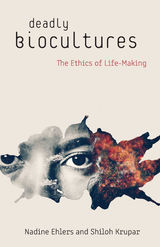 Deadly Biocultures: The Ethics of Life-making
Nadine Ehlers
University of Minnesota Press, 2019 A trenchant analysis of the dark side of regulatory life-making today
In their seemingly relentless pursuit of life, do contemporary U.S. “biocultures”—where biomedicine extends beyond the formal institutions of the clinic, hospital, and lab to everyday cultural practices—also engage in a deadly endeavor? Challenging us to question their implications, Deadly Biocultures shows that efforts to “make live” are accompanied by the twin operation of “let die”: they validate and enhance lives seen as economically viable, self-sustaining, productive, and oriented toward the future and optimism while reinforcing inequitable distributions of life based on race, class, gender, and dis/ability. Affirming life can obscure death, create deadly conditions, and even kill.
Deadly Biocultures examines the affirmation to hope, target, thrive, secure, and green in the respective biocultures of cancer, race-based health, fatness, aging, and the afterlife. Its chapters focus on specific practices, technologies, or techniques that ostensibly affirm life and suggest life’s inextricable links to capital but that also engender a politics of death and erasure. The authors ultimately ask: what alternative social forms and individual practices might be mapped onto or intersect with biomedicine for more equitable biofutures?
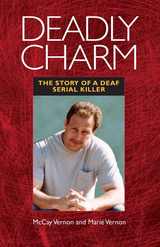 Deadly Charm: The Story of a Deaf Serial Killer
McCay Vernon
Gallaudet University Press, 2010 From the day he was born, Patrick McCullough faced hardships and reacted with untempered anger. His mother, a soon-to-be-divorced military wife, was late to realize that he was deaf and never learned how to handle his outbursts. Eventually, she abandoned him by petitioning for him to be a ward of the state. Stints in mental institutions and dismissals from several schools punctuated the rest of McCullough’s early years. Despite this severe childhood, no one could have predicted the outcome of his life described in Deadly Charm: The Story of a Deaf Serial Killer. Authors McCay and Marie Vernon present a compelling story about McCullough, a strikingly handsome man with a winning personality. His charm was endearing, but his incendiary temper resulted in increasing aggression and abuse. Eventually, he was convicted for the murder of two men. Yet, McCullough ingratiated himself with the court and served only seven years in prison. Once free again, he resumed his pattern of sweetness and mayhem. He beguiled sympathetic women whom he then abused and stalked. Finally, his rage culminated in a crescendo of destruction. Deadly Charm depicts a deaf serial killer driven by frustration and violence and leaves much to consider. Did McCullough’s deafness exacerbate his lethally violent nature? Perhaps his vicious impulses could have been constrained if his time in mental institutions had been more productive than his time in prison.
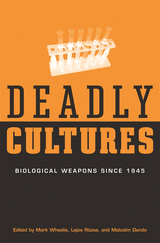 Deadly Cultures: Biological Weapons since 1945
Mark Wheelis, Lajos Rózsa, and Malcolm Dando, editors
Harvard University Press, 2006 The threat of biological weapons has never attracted as much public attention as in the past five years. Current concerns largely relate to the threat of weapons acquisition and use by rogue states or by terrorists. But the threat has deeper roots—it has been evident for fifty years that biological agents could be used to cause mass casualties and large-scale economic damage. Yet there has been little historical analysis of such weapons over the past half-century.
Deadly Cultures sets out to fill this gap by analyzing the historical developments since 1945 and addressing three central issues: Why have states continued or begun programs for acquiring biological weapons? Why have states terminated biological weapons programs? How have states demonstrated that they have truly terminated their biological weapons programs?
We now live in a world in which the basic knowledge needed to develop biological weapons is more widely available than ever before. Deadly Cultures provides the lessons from history that we urgently need in order to strengthen the long-standing prohibition of biological weapons.
Deadly Dust: Silicosis and the On-Going Struggle to Protect Workers' Health
David Rosner and Gerald Markowitz
University of Michigan Press, 2006 During the Depression, silicosis, an industrial lung disease, emerged as a national social crisis. Experts estimated that hundreds of thousands of workers were at risk of disease, disability, and death by inhaling silica in mines, foundries, and quarries. By the 1950s, however, silicosis was nearly forgotten by the media and health professionals. Asking what makes a health threat a public issue, David Rosner and Gerald Markowitz examine how a culture defines disease and how disease itself is understood at different moments in history. They also explore the interlocking relationships of public health, labor, business, and government to discuss who should assume responsibility for occupational disease.
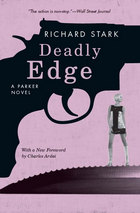 Deadly Edge: A Parker Novel
Richard Stark
University of Chicago Press, 2010 An action-packed crime novel starring Parker, the heister starring in the forthcoming Shane Black film Play Dirty!
Richard Stark's Parker novels are the hardest of hard-boiled, classic crime novels where the heists are huge, the body counts are high, and the bad guys usually win.
The Parker novels have been a huge influence on countless writers and filmmakers, including Quentin Tarantino, Stephen King, George Pelecanos, Colson Whitehead, Lucy Sante, John Banville, and many more. Their stripped-down language and hard-as-nails amorality create an unforgettable world where the next score could be the big one, but your next mistake could also be your last. There's nothing else like them.
Deadly Edge bids a brutal adieu to the 1960s as Parker robs a rock concert, and the heist goes south. Soon Parker finds himself—and his woman, Claire—menaced by a pair of sadistic, strung-out killers who want anything but a Summer of Love. Parker has a score to settle while Claire’s armed with her first rifle—and they’re both ready to usher in the end of the Age of Aquarius.
Deadly Excitements: Shadows Phantoms
Robert Sampson
University of Wisconsin Press, 1989 This volume celebrates yesterday’s pulp magazines and their heroes and heroines. Readers will acquaint themselves with such famous magazine titles as The Shadow, The Black Mask, Weird Tales, and others as obscure as Scientific Detective Monthly and the sensuous Scarlet Adventuress of dim reputation. And more: Erle Stanley Gardner’s tough White Rings; Toffee the dream girl; Senorita Scorpion, a quick-trigger blond from Old Texas; Oscar Sail, protagonist of a pair of ferocious stories. And mediums, bandits, cowboys, detectives, vivacious characters, fascinating and vitally alive.
Deadly Landscapes: Case Studies in Prehistoric Southwestern Warfare
Glen E. Rice
University of Utah Press, 2012 Deadly Landscapes presents a series of cases that advance the rigorous examination of war in the archaeological record. The studies encompass examples from the Hohokam, Sinagua, Mogollon, and Anasazi regions, plus a pan-regional study of iconography covering the Colorado Plateau and the Rio Grande Valley. All of the cases focus on the narrow time frame from AD 1200 to the early-1400s, during which evidence for warfare is most pervasive. Contributors to this volume present varying definitions of warfare and use differing types of data to test for the presence of warfare. These detailed case studies give clear demonstration of a pattern of significant warfare in the late prehistoric period that will alter our understanding of ancient Southwestern cultures.
The Deadly Politics of Giving: Exchange and Violence at Ajacan, Roanoke, and Jamestown
Seth Mallios
University of Alabama Press, 2006 A clash of cultures on the North American continent. With a focus on indigenous cultural systems and agency theory, this volume analyzes Contact Period relations between North American Middle Atlantic Algonquian Indians and the Spanish Jesuits at Ajacan (1570–72) and English settlers at Roanoke Island (1584–90) and Jamestown Island (1607–12). It is an anthropological and ethnohistorical study of how European violations of Algonquian gift-exchange systems led to intercultural strife during the late 1500s and early 1600s, destroying Ajacan and Roanoke, and nearly destroying Jamestown.
 Deadly Refusals: Kurdish Decolonization in Times of Counterterrorism
Serra M. Hakyemez
University of Minnesota Press, 2026 Revolutionary desire and decolonial struggle inside the heart of the carceral state Deadly Refusals offers an intimate portrait of Kurdish decolonial struggle within the carceral and legal apparatuses of the Turkish state. Set in the counterterrorism courts and maximum-security prisons of Northern Kurdistan, Serra M. Hakyemez’s ethnography examines how prosecuted and imprisoned Kurds from different socioeconomic backgrounds organize in refusal of the criminalization and colonization of their political demands and desires. Through acts of self-criticism, revolutionary education, and comradely care, these prisoners articulate a political subjectivity that challenges the foundations of colonial power. Based on more than seventeen years of ethnographic research—including interviews with former prisoners, lawyers, judges, and prosecutors; observations of more than one hundred court hearings; and analysis of prison memoirs, poetry, and legal archives—Deadly Refusals uncovers the mechanisms through which counterterrorism law reproduces the colonial state. Yet it is not solely a study of repression. Engaging psychoanalytic concepts of subject, desire, and ethics, Hakyemez illuminates how these carceral spaces also become sites of revolutionary responsibility. Here, refusal is not resignation but a political act in which the colonized self is killed—literally or figuratively—to make way for a larger collective subjectivity. Using the interplay of comradeship and intimacy, political desire and ordinary pleasure, death and love, Deadly Refusals examines how Kurdish political prisoners forge multilayered relations of decolonization in an ongoing psychopolitical struggle. Hakyemez shows how both small gestures of withdrawal, restraint, and negation as well as radical acts like language protests, hunger strikes, and death protests become part of a shared struggle for alternative futures that state power cannot fully contain or comprehend. Retail e-book files for this title are screen-reader friendly with images accompanied by short alt text and/or extended descriptions.
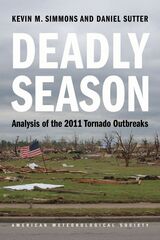 Deadly Season: Analysis of the 2011 Tornado Outbreaks
Kevin M. Simmons and Daniel Sutter
American Meteorological Society, 2012 In 2011, despite continued developments in forecasting, tracking, and warning technology, the United States was hit by the deadliest tornado season in decades. More than 1,200 tornadoes touched down, shattering communities and their safety nets, and killing more than 500 people—a death toll unmatched since 1953. Drawing on the unique analysis described in their first book, Economic and Societal Impacts of Tornadoes, economists Kevin M. Simmons and Daniel Sutter here examine the factors that contributed to the outcomes of such tornadoes as the mid-April outbreak that devastated communities in North Carolina, the “Super Outbreak” across the southern and eastern United States in late April, and the single, mile-wide funnel that touched down in Joplin, Missouri, in late May. In the course of their study the authors identify patterns and anomalies, and reconsider previous assertions about the effectiveness of the Doppler radar and storm warning systems. Their conclusions, as well their assessment of early recovery efforts, are aimed at helping community leaders and policy-makers keep vulnerable populations safer in the future.
 The Deadly Truth: A History of Disease in America
Gerald N. Grob
Harvard University Press, 2005 The Deadly Truth chronicles the complex interactions between disease and the peoples of America from the pre-Columbian world to the present.
Grob's ultimate lesson is stark but valuable: there can be no final victory over disease. The world in which we live undergoes constant change, which in turn creates novel risks to human health and life. We conquer particular diseases, but others always arise in their stead. In a powerful challenge to our tendency to see disease as unnatural and its virtual elimination as a real possibility, Grob asserts the undeniable biological persistence of disease.
Diseases ranging from malaria to cancer have shaped the social landscape--sometimes through brief, furious outbreaks, and at other times through gradual occurrence, control, and recurrence. Grob integrates statistical data with particular peoples and places while giving us the larger patterns of the ebb and flow of disease over centuries. Throughout, we see how much of our history, culture, and nation-building was determined--in ways we often don't realize--by the environment and the diseases it fostered.
The way in which we live has shaped, and will continue to shape, the diseases from which we get sick and die. By accepting the presence of disease and understanding the way in which it has physically interacted with people and places in past eras, Grob illuminates the extraordinarily complex forces that shape our morbidity and mortality patterns and provides a realistic appreciation of the individual, social, environmental, and biological determinants of human health.
|
|
